Moore Street was originally only an entry from Mill Street into the Moor Family’s various lumber mills operations at the Upper Dam
*
(Update in Progress as of 4/14/2024)
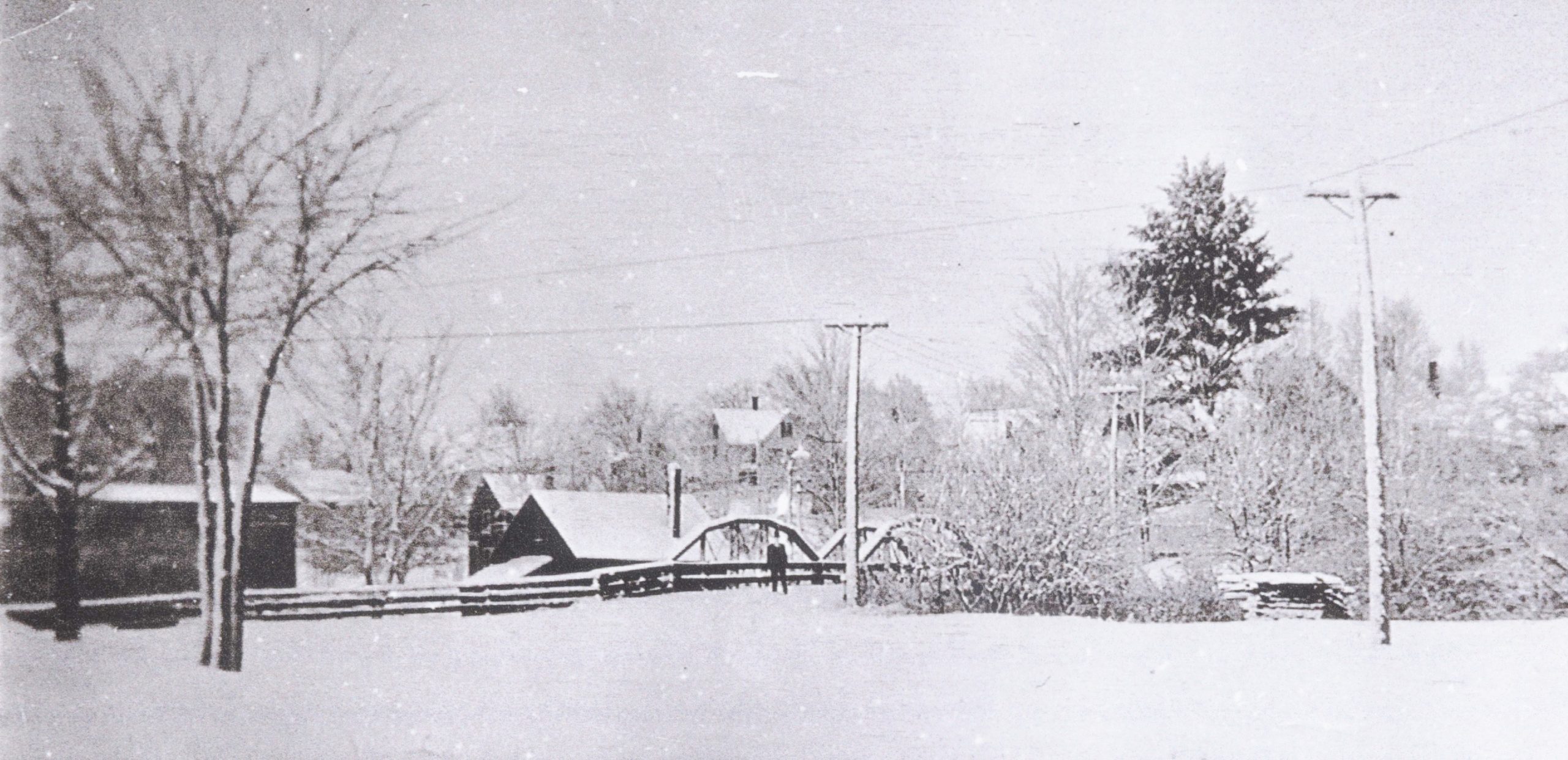
Upper & Lower Mill Street and Moore Street as seen from corner of North Street – 1920s
*
Currently, no maps of Hartland detailing the locations of homes, businesses and merchants before 1860 have been discovered. Various documents provide us with enough information to know many existed in its early years of settlement, but most of the specific details of when they were built or by whom remain unknown. The following is based on our best interpretation of known maps, town records, census data, historical book references, photos, artifacts and family genealogical information. Updates will be made as new information is discovered.
*
What is now known as Upper Mill Street on the northern side of the Sebasticook River was originally surveyed, deeded and incorporated as part of Hartland however in 1821 it was part of a large section of land annexed to St Albans. Lower Mill Street and the future Moore Street area remained as part of Hartland.
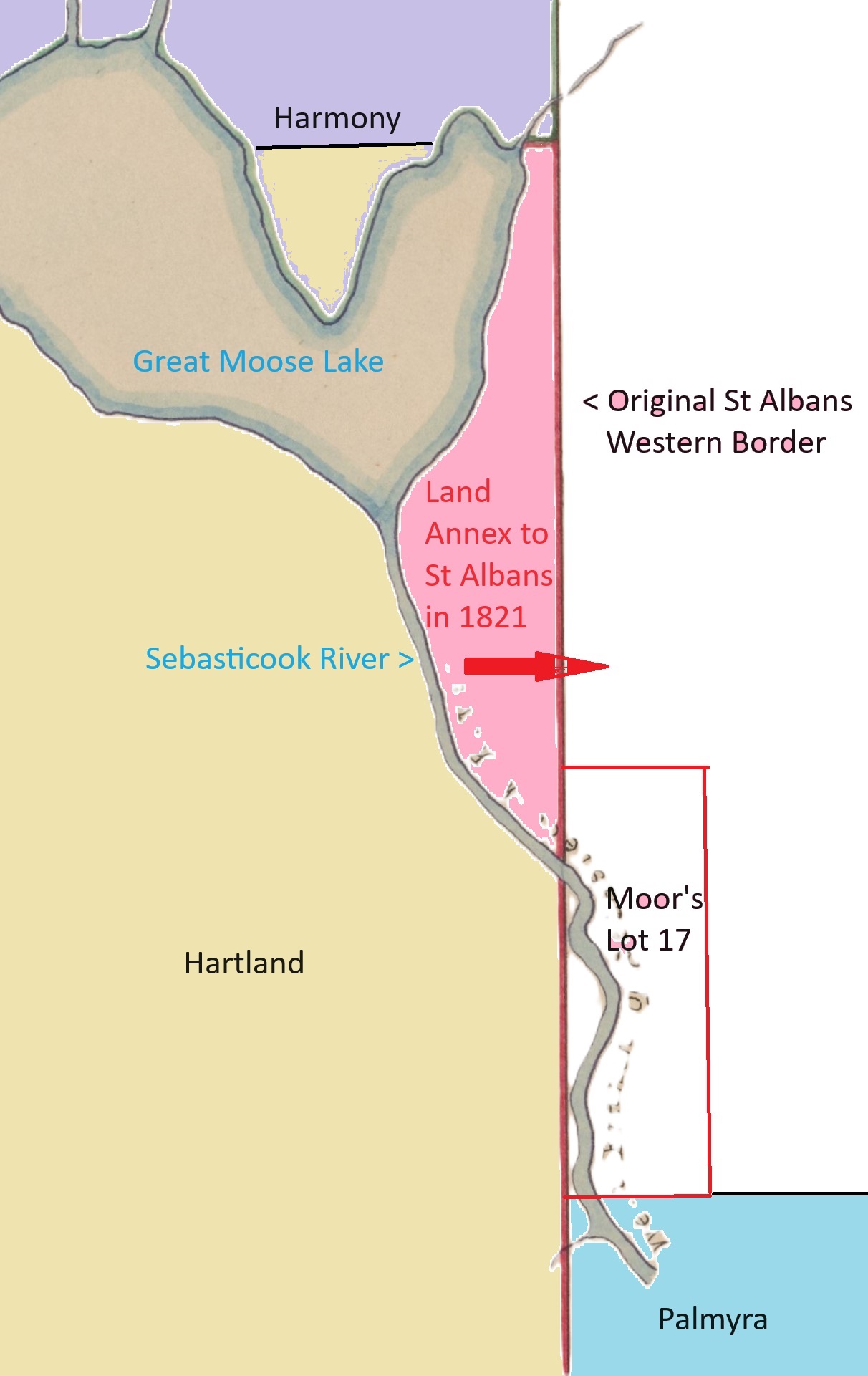
1821 Land Annexation to St Albans
*
All of William Moor’s original Lot 17 remained part of St Albans including the southwest section which crossed the Sebasticook River. This section sustained that part of St Albans’ as illustrated below using a template of the 1883 map with future streets included for reference as to where the village area remained divided in 1821. By this time, Moor had already divided up most of his original lot into multiple properties sold to new settlers in the village area before he moved to Corinna in the mid-1820s.
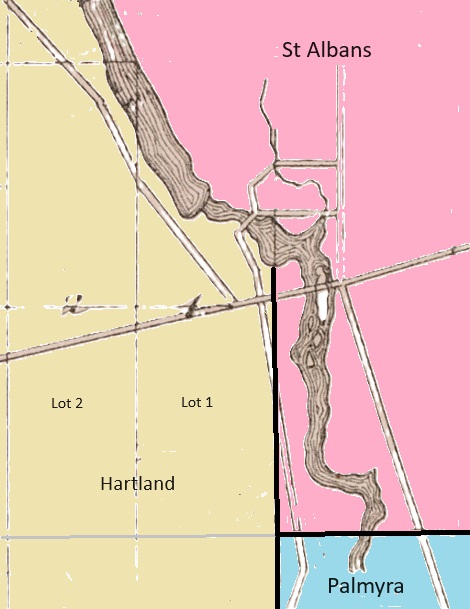
1821 Village Area Borders
*
In 1802, James Moor (1800-1873) arrived with his parents William & Sally Moor who settled on what became Commercial Street in Hartland. Following his parents departure to Corinna soon after 1820, James remained in Hartland and began an important role in the early years of development of Hartland’s town affairs and its industry.
James married Dorcas Wiggin (1799-1893) in 1821 and they built a modest home atop the highest hill on Main Street where they began raising their family of 9 eventual children. In 1847, James & Dorcas built a new, larger house on the same location which would eventually become the Scott-Webb Memorial Hospital in 1932.
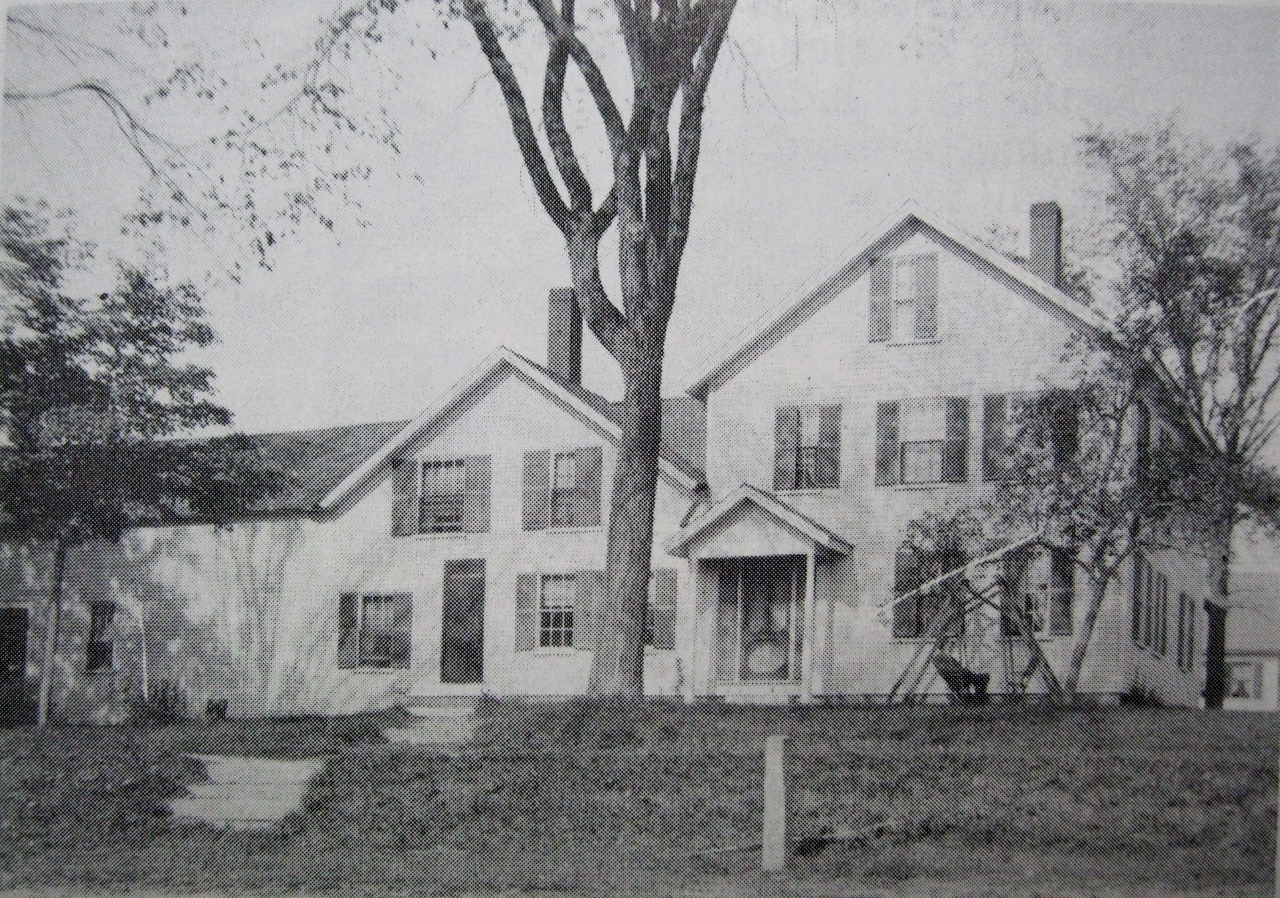
Former James Moor Residence – Main Street – c1910
*
By 1825, James had built the Upper Dam on the Sebasticook River and opened a sawmill on the dam accessed from an entrance way just off Mill Street (future Moore Street). A furniture manufacturing shop was later built connecting to the sawmill. Given its name, it could be likely Mill Street was originally cleared by Moor to get to his sawmill operations from his Main Street home.
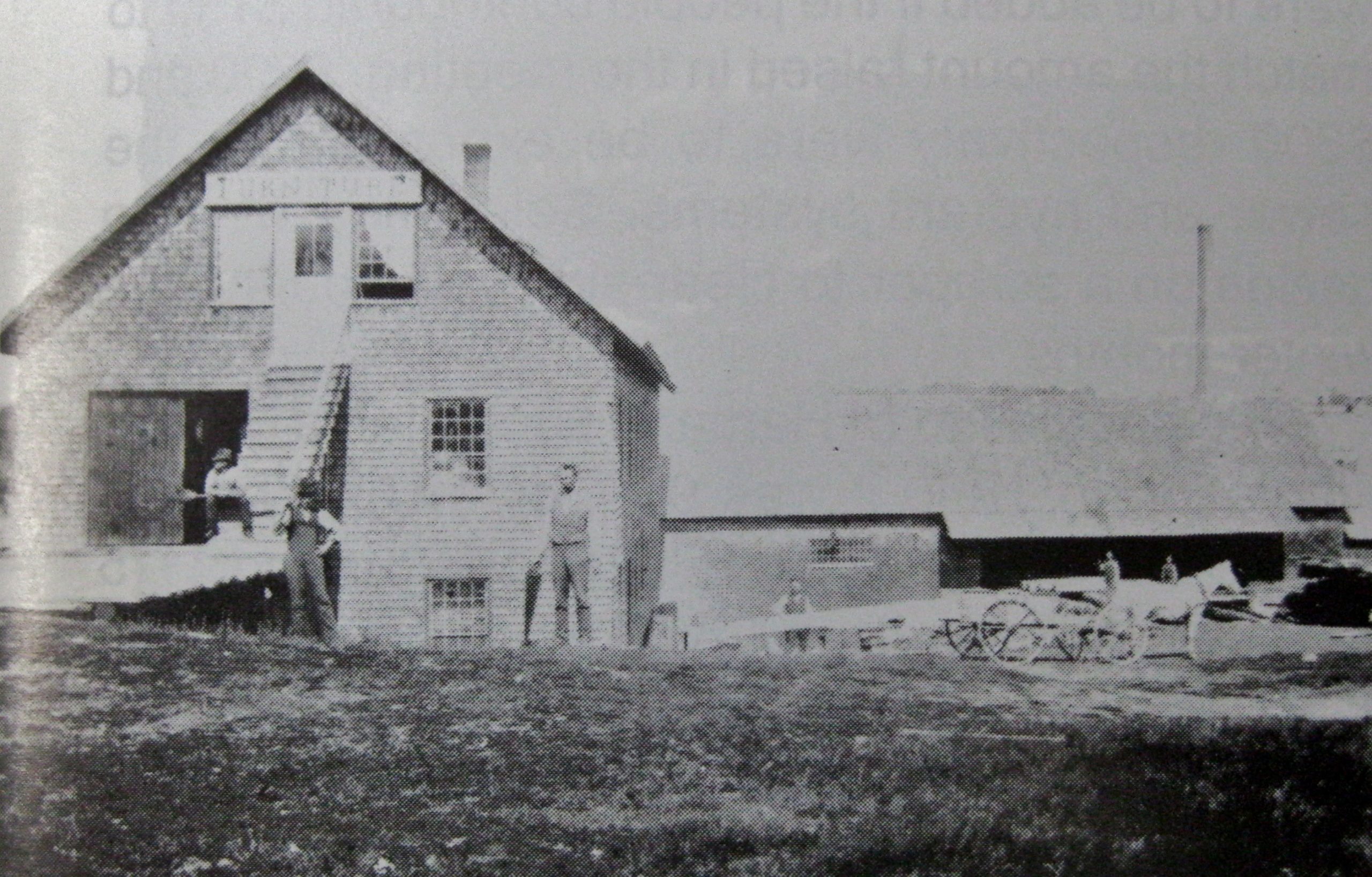
Moor Furniture Mill & Moor Sawmill in background – c1870
*
Following the opening of a throughway from Commercial Street (then known as North Street) in the early part of 1850, the first bridge to connect Mill Street to the new throughway was built in October of 1850 according to early town records.
By 1860, the new throughway became known as Billings Street following construction of the Billings Tannery in 1856. The short span of connecting road between it and the Mill Street Bridge were often referred to as Bridge Street before being officially included as the upper part of Mill Street in 1897.
In 1880, a local newspaper article reported a new iron bridge was built at a cost of $2,000 to replace the existing structure, however it is currently unknown how long this new iron bridge lasted and when or if it was replaced.
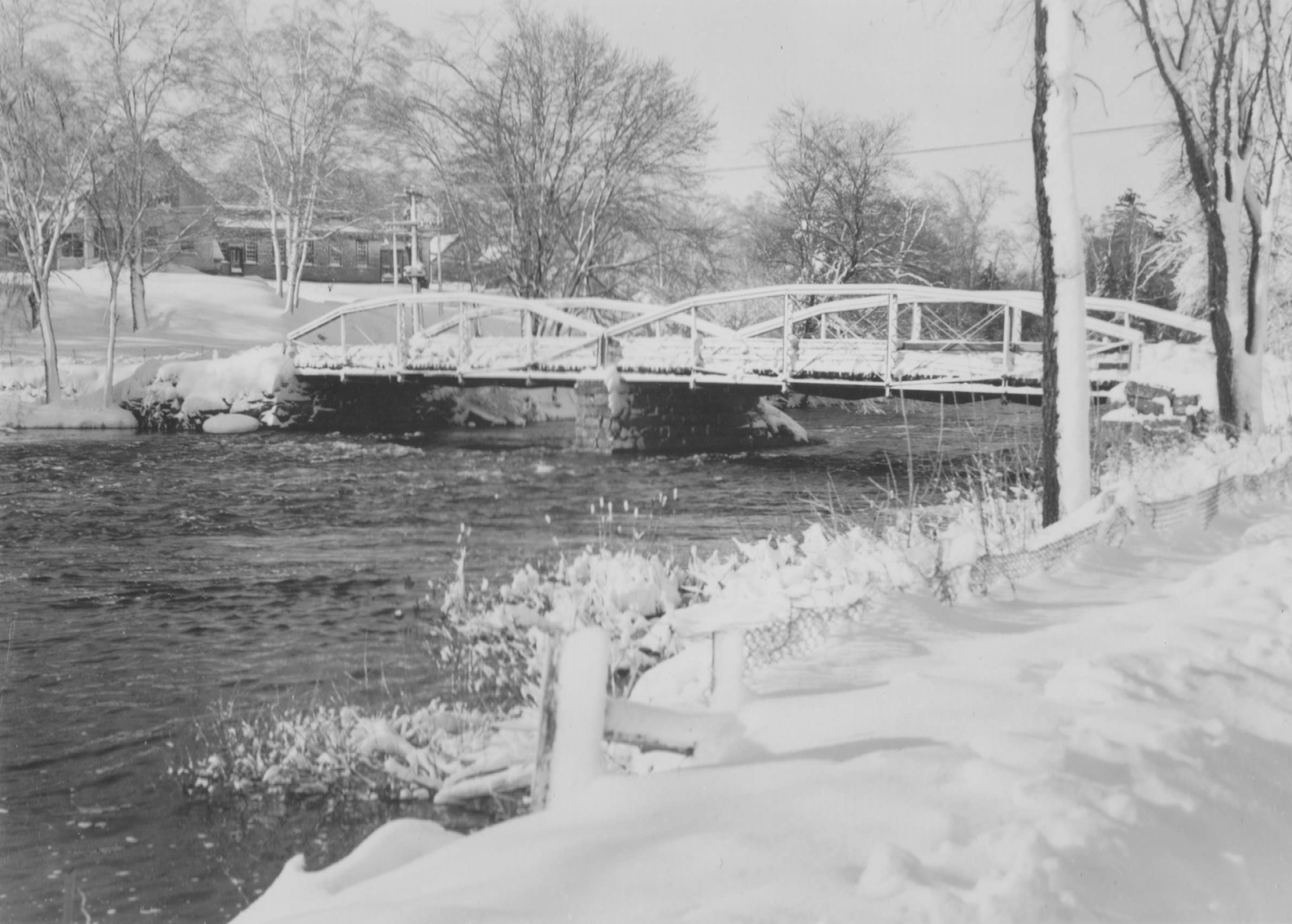
Mill Street Bridge from Water Street – 1942
*
Both of James’ surviving sons became involved in the family wood business. His elder son Amasa James Moor (1827-1899) was involved by the 1850s and eventually took over operations at his father’s sawmill where he produced long & short lumber. A. J. Moor built his house on North Street with his wife Frances E. Lancey (1830-1894), daughter of George Lancey, Sr & Mary Gilman of Palmyra.
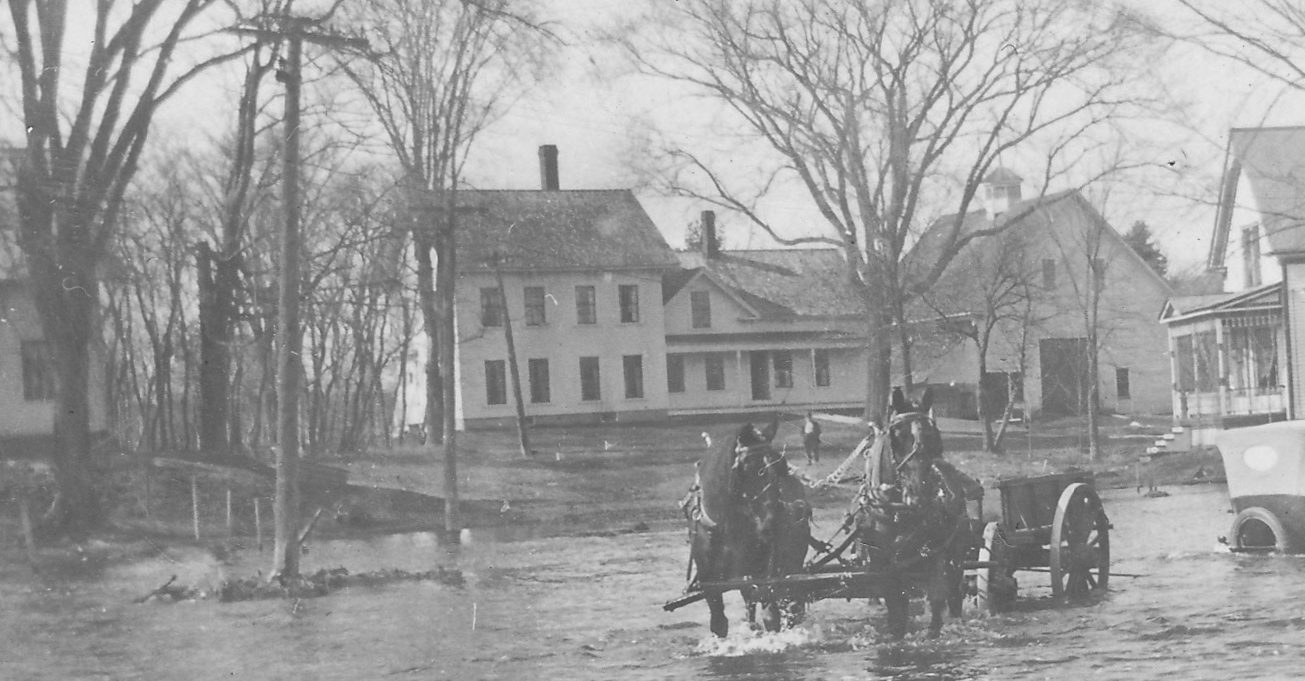
Original Amasa J. Moor Homestead on North Street – 1923
*
James’ son, James Wiggin Moor (1830-1902) operated a casket & coffin manufacturing and a chair & settee furniture business in another separate building on the Moor woodworking lot. James W. Moor and his wife Martha Folsom (1831-1899) built the first house on the river end of the future Moore Street located on the hill at the corner of Mill Street.
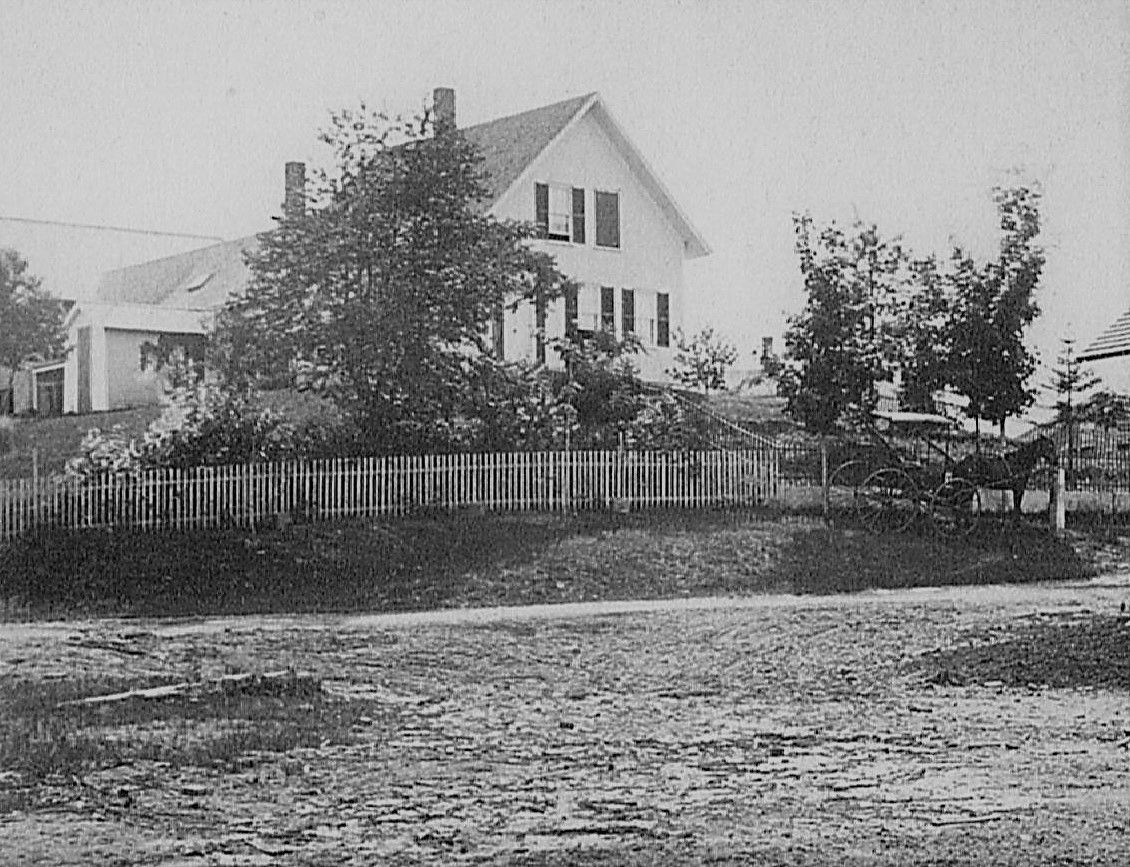
James W. Moor Residence at Mill Street & Moore Street
*
In 1856, Josiah Billings, Jr built a tannery at the Upper Dam on the north side of the Mill Street Bridge located on property which eventually became Upper Mill Street. Billings also built his home, a hide drying house and a boarding house for some of his dozen or so tannery employees which were accessed from North Street then known as Billings Street.
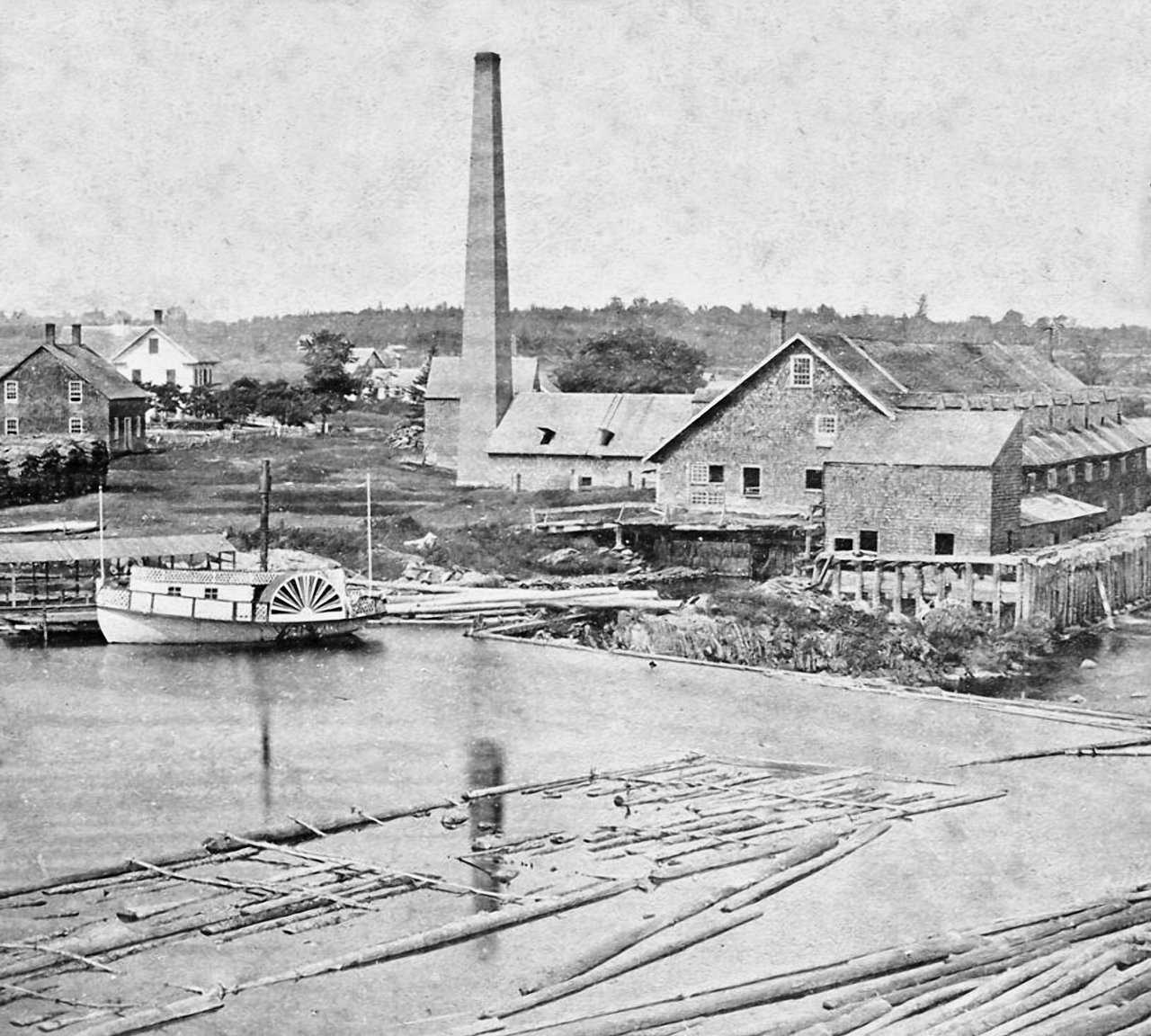
Former Billings Tannery at the Upper Dam – c1877
*
The Moor Family Wood Mills, James W. Moor’s home and a Blacksmith Shop were the only known buildings to exist on Mill Street by 1860.
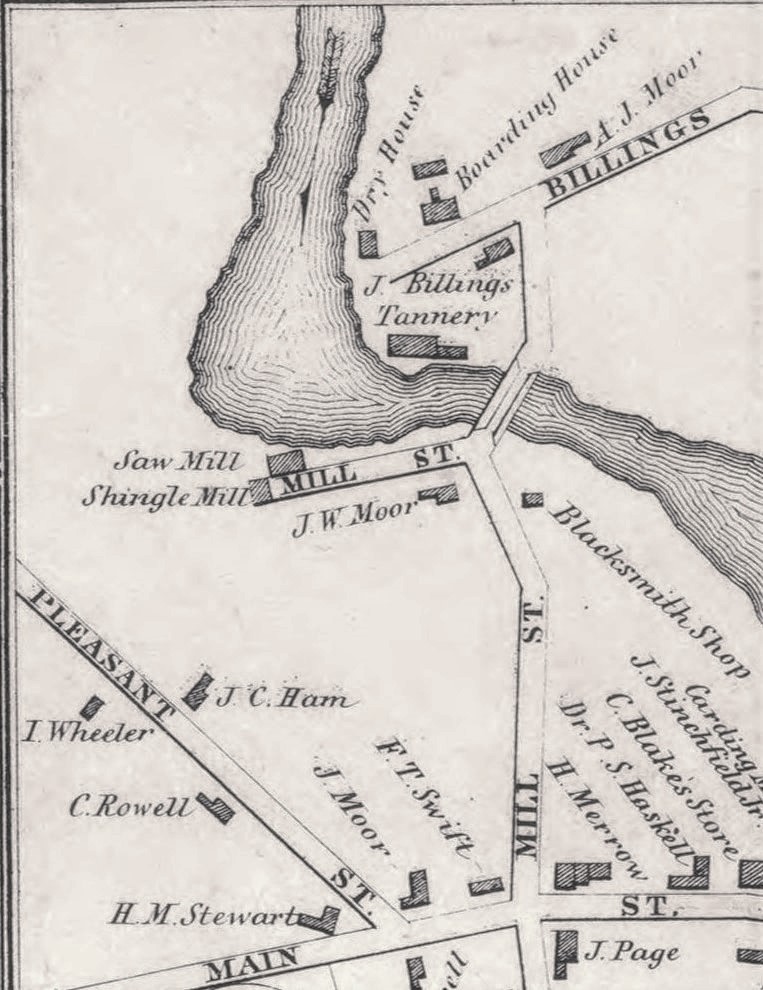
Hartland Village – 1860
*
In 1867, Josiah Billings sold his tannery to Greenville Jefferson Shaw and his father Charles Shaw and left town for Iowa.
James Moor passed away on December 2, 1873 at 73yrs old. Following their father’s death, the Moor Brothers continued operations making everything from sawed lumber to furniture, shingles, doors, sashes, blinds, chairs, settees, coffins & caskets. Only a few additional houses had been built on Mill Street by 1883.
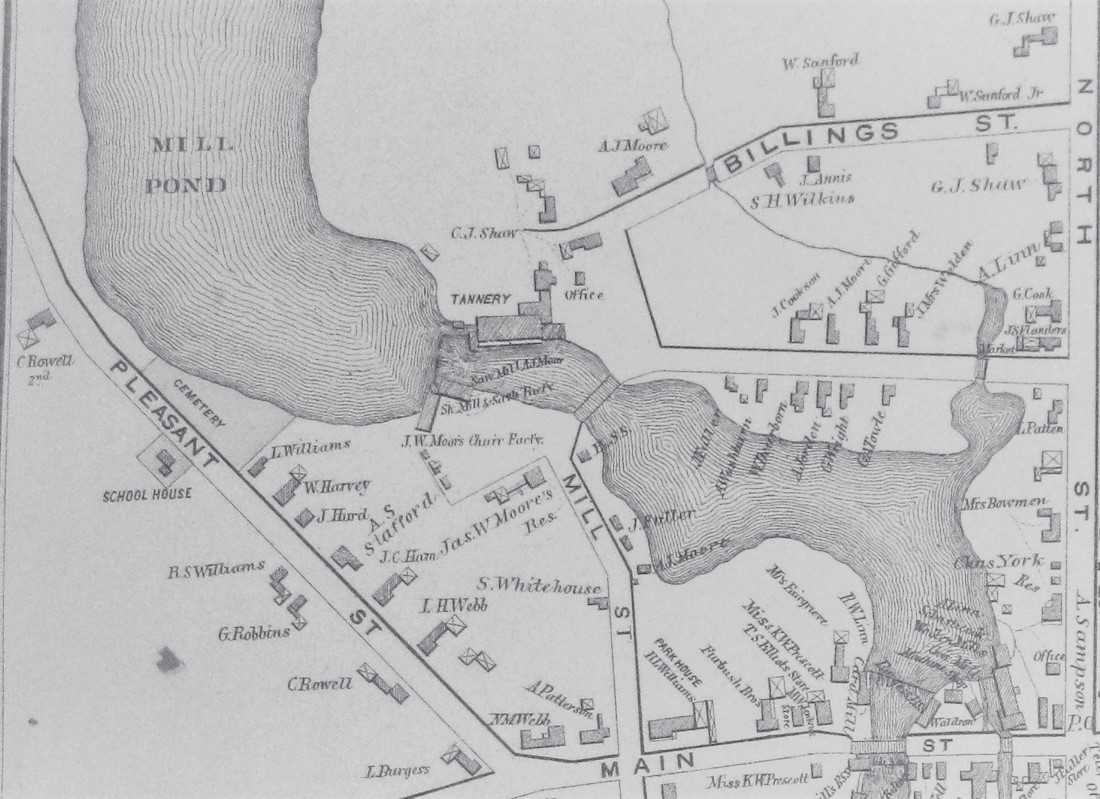
Hartland Village – 1883
*
Amasa and James W. Moor had 3 male heirs born between them but James’ only child Herbert Moor died at 16yrs old in 1875. Amasa had 2 sons and a daughter but the youngest son Charles L. Moor (1861-1919) didn’t appear to have an interest in the wood business and instead went to work as a Bookkeeper for the Linn Woolen Mill. This left Amasa’s youngest son Walter H. Moor as heir apparent to the family wood business.
By the early 1880s, Walter Henry Moor (1856-1931) became a partner in his father’s business after working in the various Moor Family mills throughout his youth. In 1885, following a January fire that destroyed a couple of the original lumber mill buildings, they built a new mill operating as “A. J. Moor & Son Woodworkings” while James W. Moor continued his casket & furniture operations. The new mill had a very creative system to supply its power using pulleys & belts connected to a shaft which tied directly into the dam.
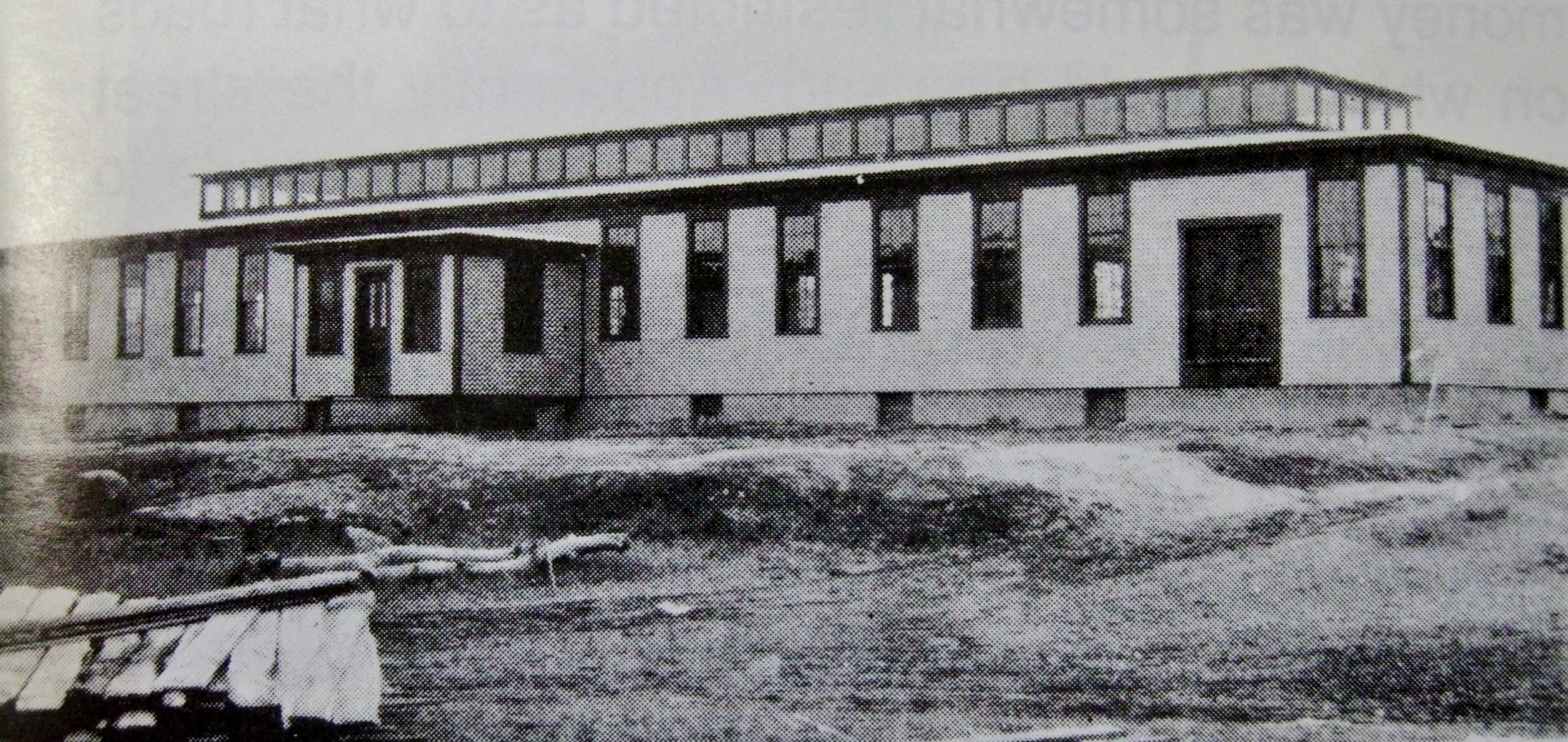
Former A. J. Moor & Son Woodworking Mill
*
The Great Flood of 1887 caused major damage to numerous Hartland industries along the Sebasticook River including extensive damage to the Upper Dam and Greenville Shaw’s Tannery as noted by the Pittsfield Advertiser, “The Boat House at the Upper Dam and a wing dam connecting to the end of Shaw’s Tannery were carried away. Mr. Moor’s Sawmill is all right but on Sunday, some 10,000 logs belonging to him went down river.” The flood was part of the cause of the tannery’s eventual demise as Shaw ceased operations soon after and focused his efforts on his trotter breeding operation at his Maple Lane Farm on Commercial Street and other business ventures.
*
A cropped section of the 1896 Map of Hartland Village shows the Mill Street & Moore Street area at the time. Remnants of the Shaw Tannery foundation also appear on the map after it had been razed soon after the Great Flood of 1887.
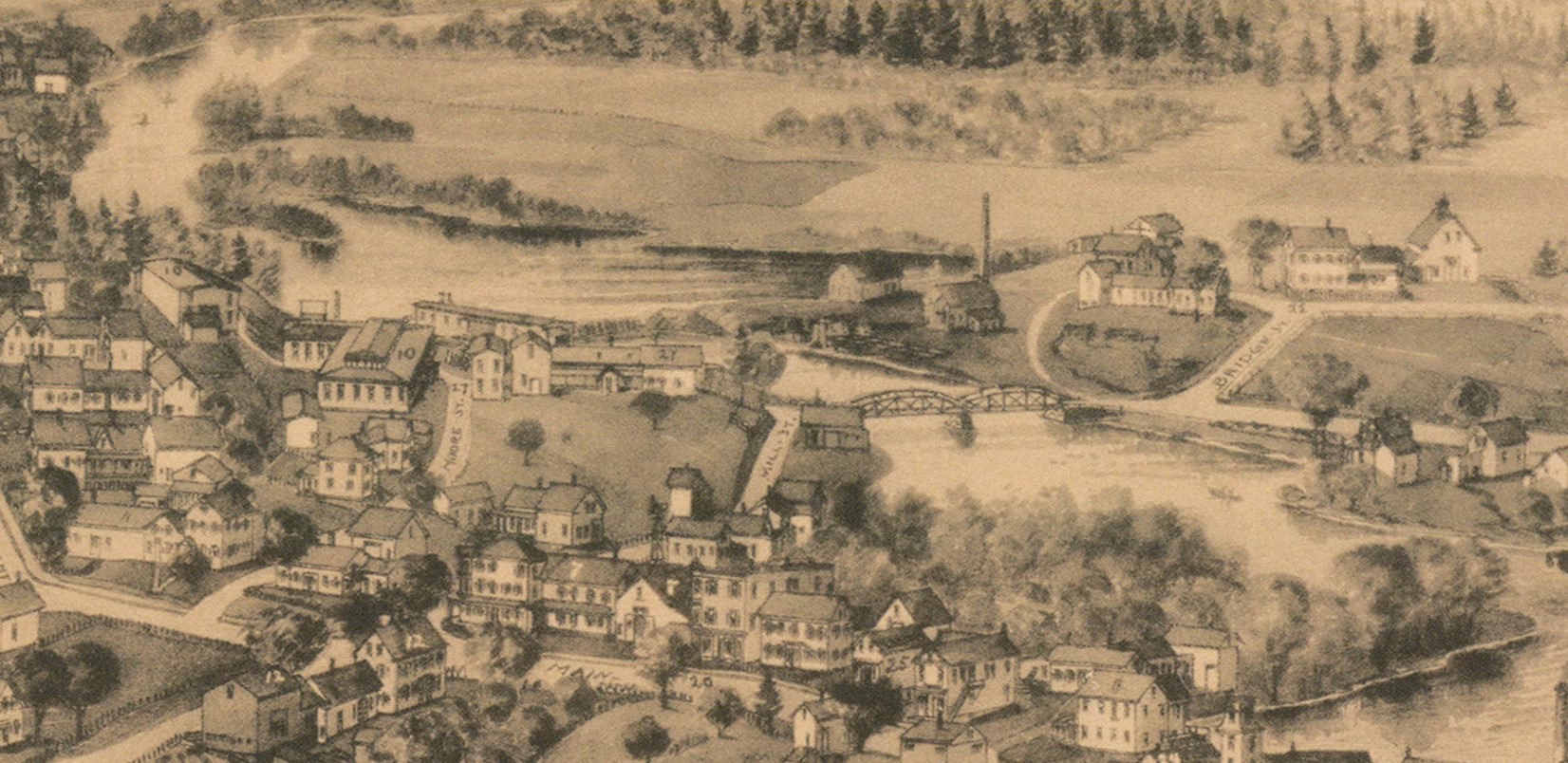
Mill Street & Moore Street Area – Map of 1896
*
At the 1897 Town Meeting, the people of Hartland voted to accept an updated list of names for streets in their village. The connecting street between Mill Street and North Street, sometimes referred to previously as Bridge Street, officially became part of Mill Street as noted, “From A. J. Moor’s to said Main Street going south; Mill Street”. Moore Street would remain an unofficial street sometimes referred to as Webb Street until officially proclaimed as Moore Street in 1955.
*
There appears to be two separate reconstructions of the Upper Dam following the demolition of the main Shaw Tannery building by 1896 as several undated photos reveal two distinct changes to the dam gate structural components. The first reconstruction is believed to have been done by the Linn Woolen Company soon after they purchased the Upper Dam in 1900 as noted below and incorporated a wooden gate structure which was, at an unknown date, replaced with a concrete gate structure leading up to a dated photo from the Great Flood of 1923. We continue research into the exact timeline of these photos and events.
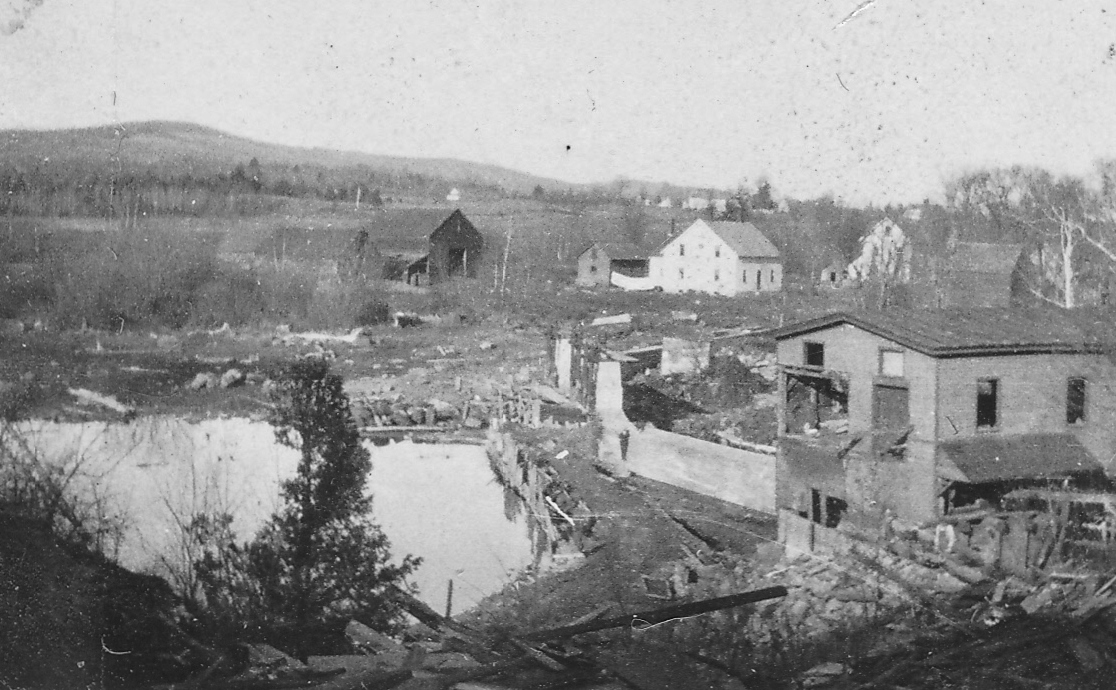
Upper Dam Rebuild with Moor Sawmill
*
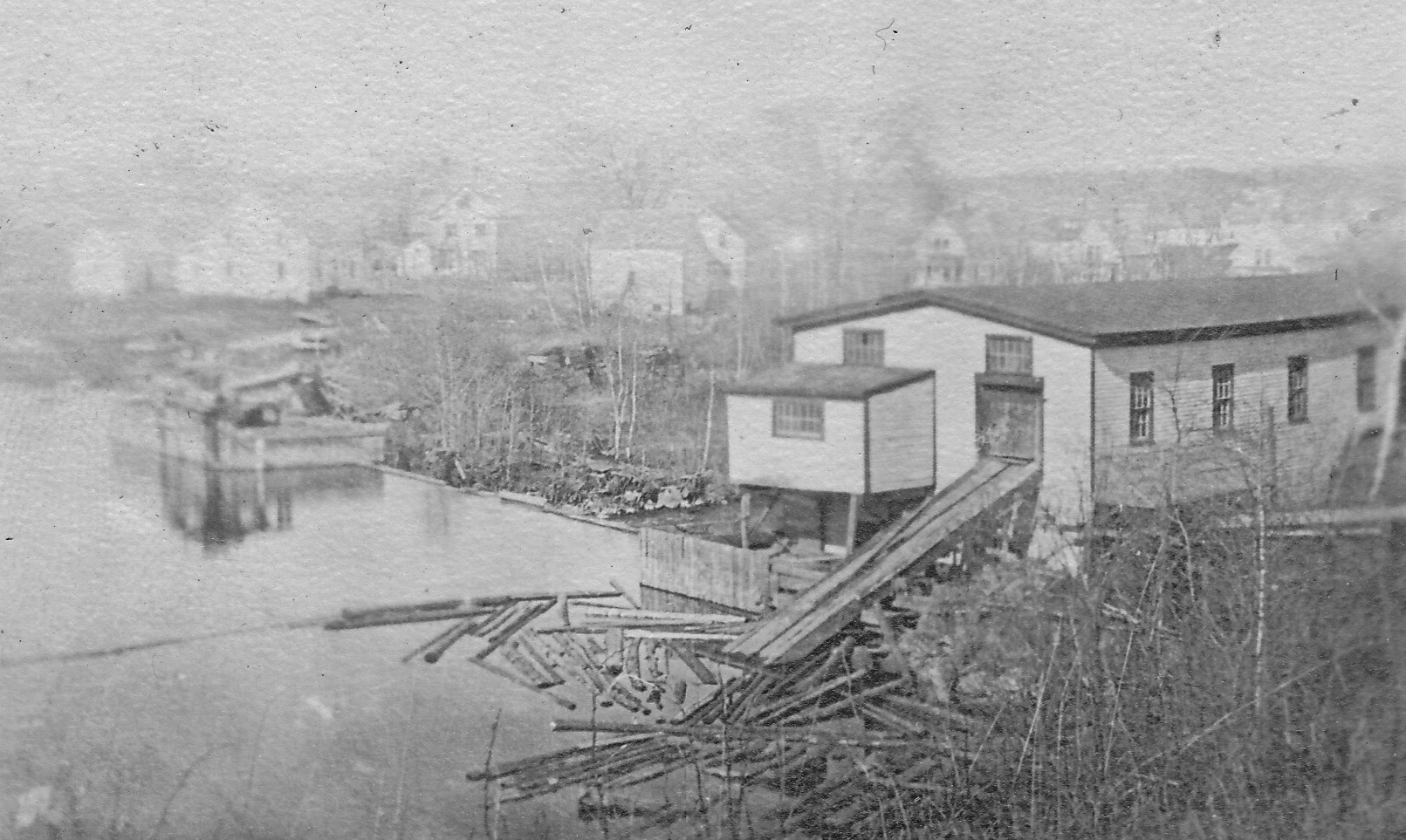
Upper Dam with Moor Sawmill – Wooden Gate
*

High Water at Upper Dam with Moor Sawmill – Wooden Gate Structure – Steel Beam across the Dam
*

Open Flow at Upper Dam – Steel Beam across Dam
*
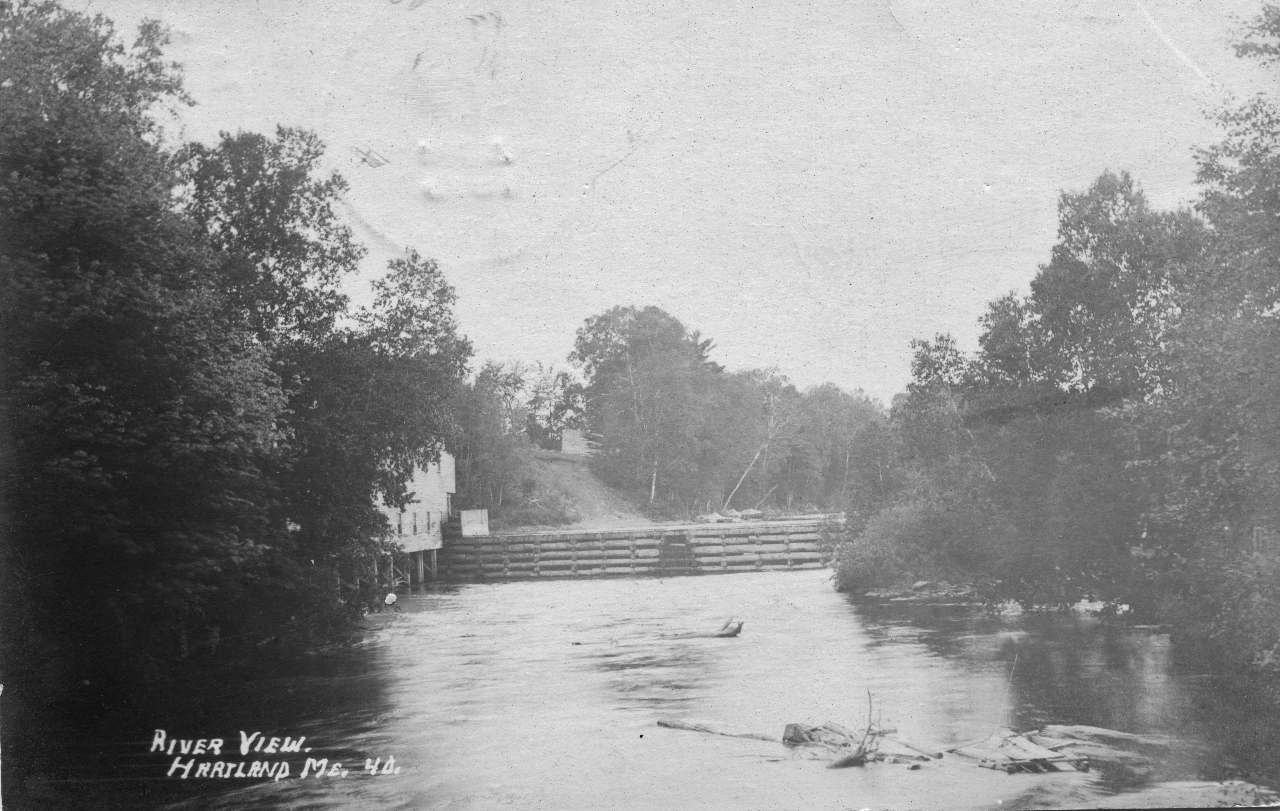
Upper Dam from Mill Street Bridge with Moor Sawmill
*
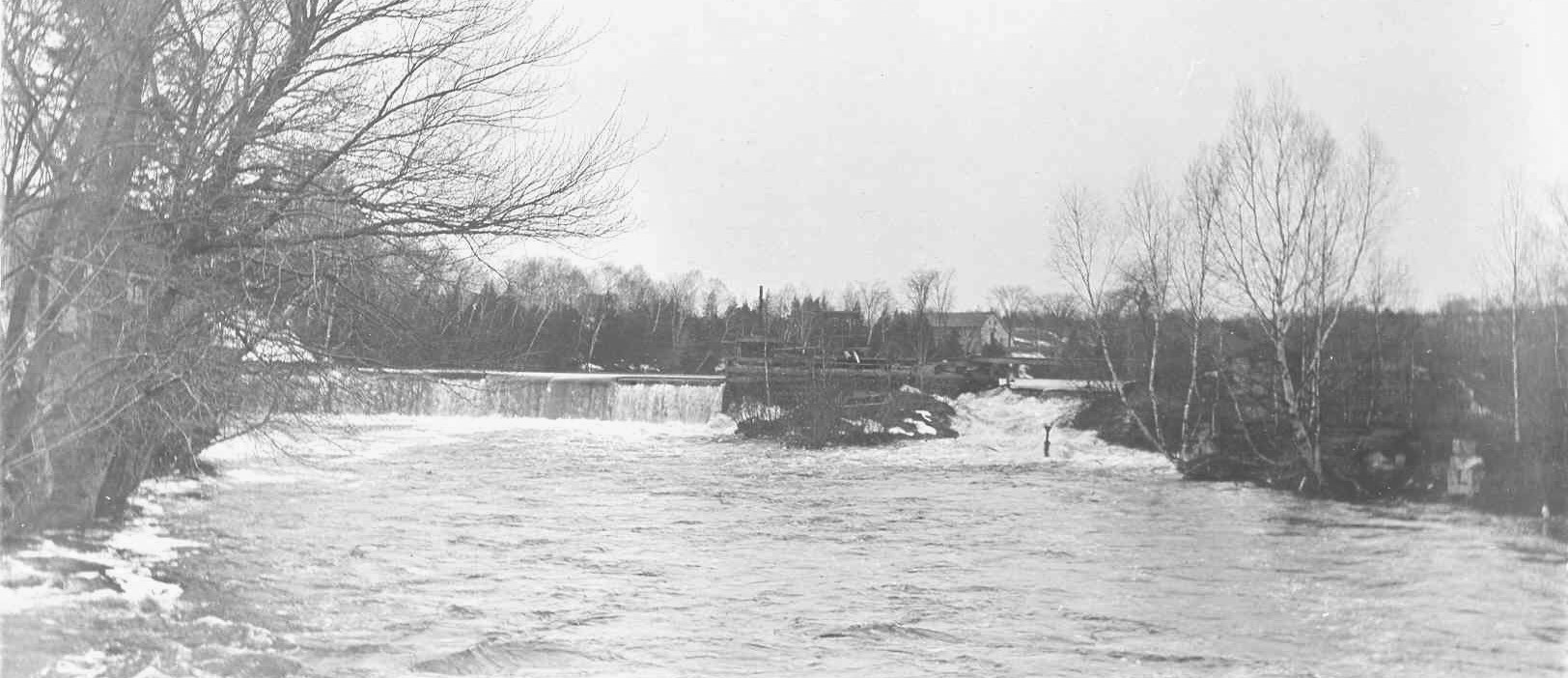
High Water at Upper Dam with Moor Sawmill – Wooden Gate Structure
*
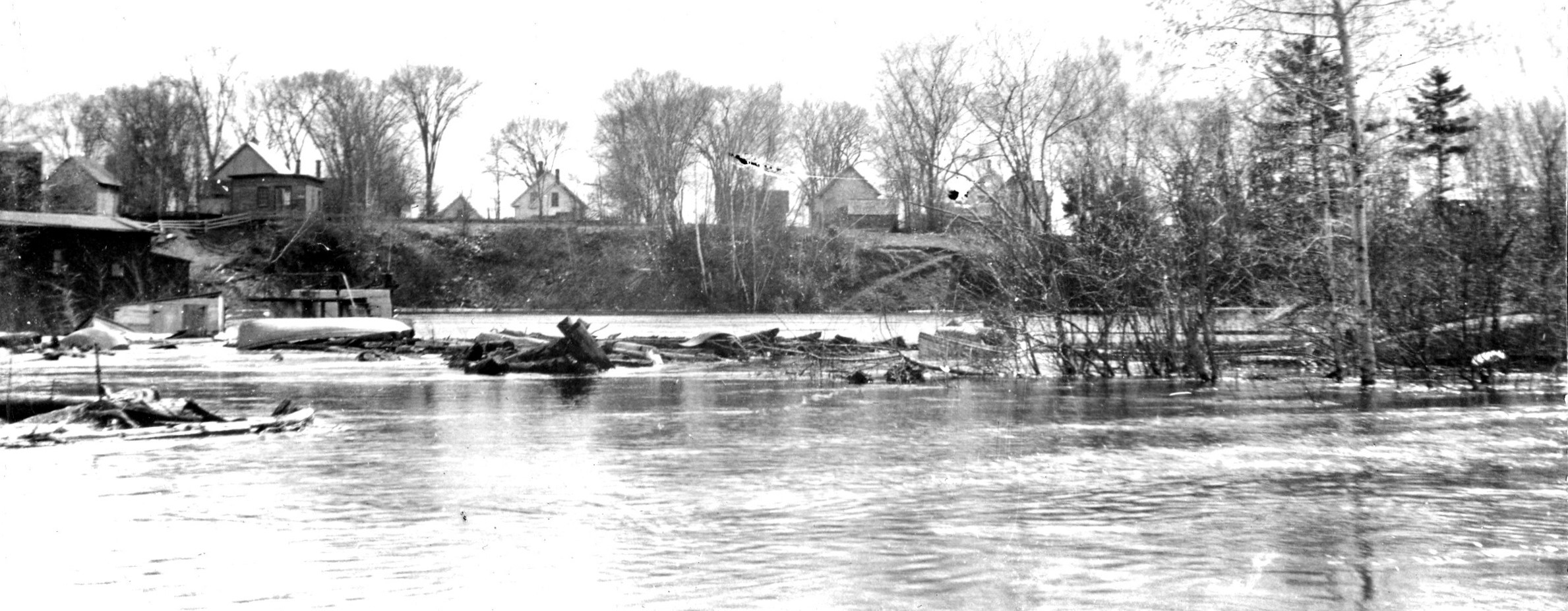
Flood Waters at Upper Dam with Moor Sawmill & Woodworking Mill
*
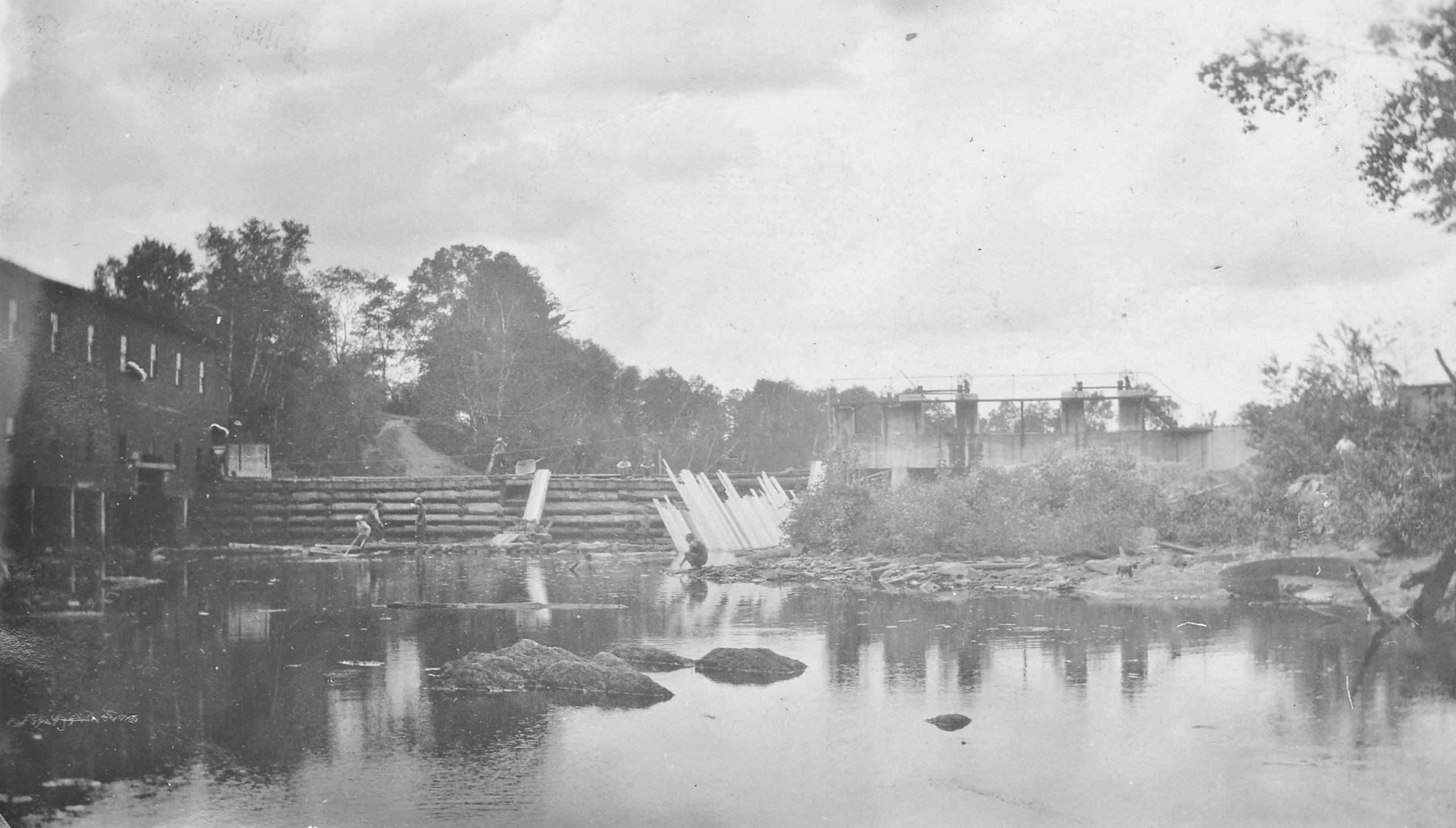
Rebuild of the Upper Dam with Moor Sawmill – 5 Concrete Gate Buttress
*
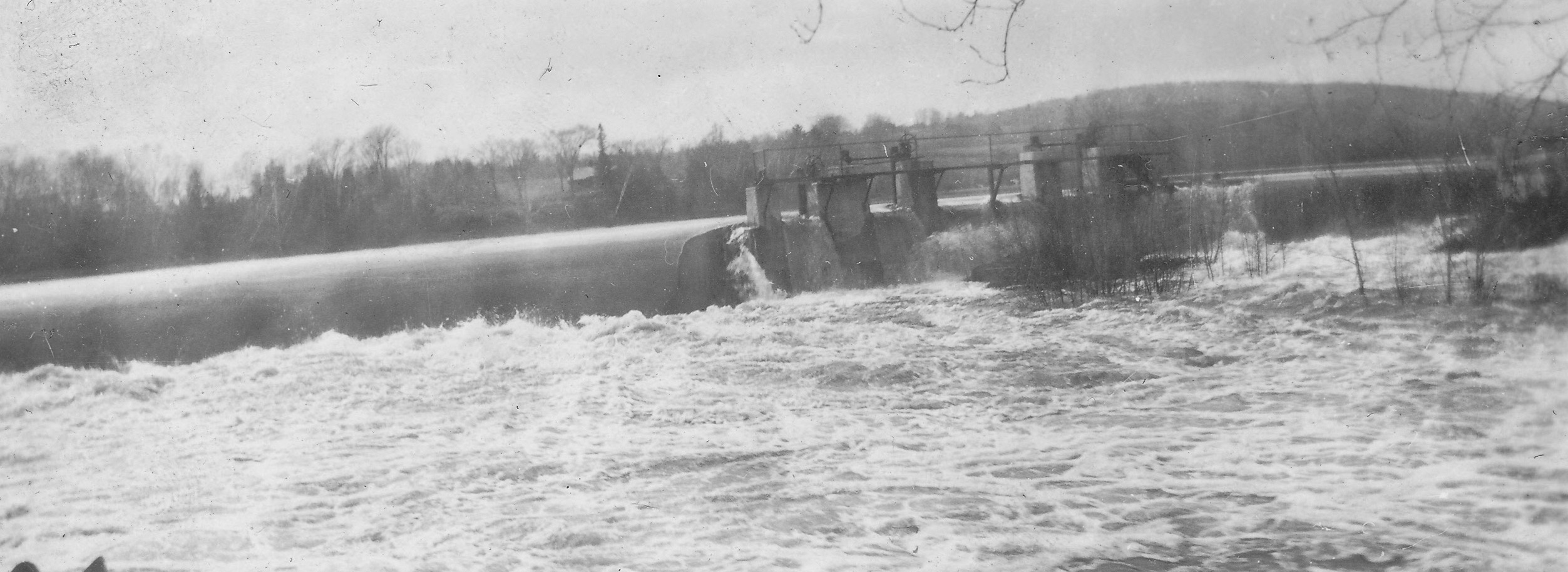
Dated Photo of Upper Dam during the Great Flood of 1923 – 5 Concrete Gate Buttress
*
Following the death of his father Amasa Moor on January 30, 1899 and his Uncle James W. Moor’s retirement, Walter continued production at the woodworking mill manufacturing doors, sashes and blinds. Walter remained at his father’s house on North Street with his wife Florence Belle Page and their sons Merrill Amasa Moor & James Folsom Moor.
The Linn Woolen Company, now with its second woolen mill in full operation at the Lower Dam on Main Street, took great interest in the Upper Dam and more specifically control of its flow downstream in order to regulate an ample and consistent flow of water to power the steam boilers for both mills. On April 20, 1900, they purchased the rights to the Upper Dam from Walter and soon after began a rebuild of the dam to meet their power needs.
“A year or more ago the Linn Woolen Company purchased from Walter Moor the water power at the Moor Mill, paying a large sum, and now has one of the best powers in the state for its business. Between the Upper Dam and the dam at the Linn Woolen Company’s mill there is quite a mill pool and by regulating the gates at the Upper Dam, the head of water on the Linn Company’s wheels is maintained at a given point at all times and there is sufficient amount so that the company will never in all probability be called upon to use steam for power, notwithstanding an immense power is required to run the machinery in both their mills. The company is now having a new boiler set which will increase the amount of steam available by 100 horse power to be used in dyeing and as needed for other purposes. ~ Pittsfield Advertiser – July 4, 1901
The 1900 Linn Woolen Company purchase also included the entire Moor Mills lot as well as the sawmill, the woodworking building and all the machinery however they showed little interest in operating either of the woodworking businesses. Although Walter was no longer the owner, he continued operations for a few more years at the woodworking mill making doors, sashes and blinds. In April of 1902, his Uncle James W. Moor passed away at 72yrs old.
*
In 1903, future U. S. Representative Clyde H. Smith, then still living in Hartland, and his business partner Albert C. Bowman took over operations at the former Moor Woodworking Mill where they began producing numerous wooden novelty items. The new business enjoyed great success and growth but Clyde soon sold his interests in the company to Eugene Weeks of Pittsfield when he was elected Sheriff of Somerset County in late 1904 and moved to Skowhegan soon after. Smith & Bowman had also been operating a hardware store at the Latty Block on Main Street before Smith sold his interest in the company and joined his brother Myron Smith to purchase a clothing store on Commercial Street in 1901. The article also mentions the “New Upper Dam”.
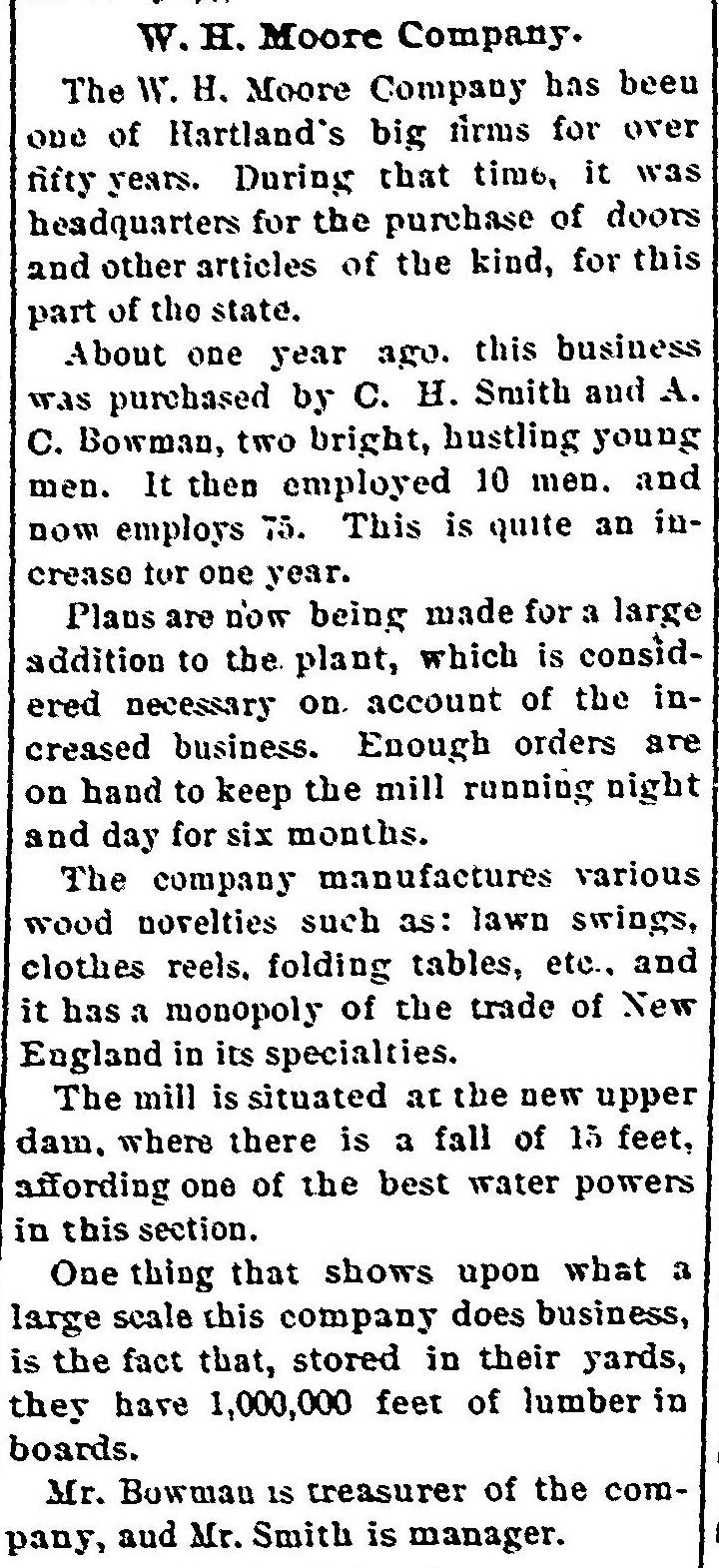
Smith & Bowman Article – 1904
*
Following the eventual closure of the Smith & Bowman wood novelty business, Walter resumed operations by 1906 at the woodworking mill as the Walter H. Moore Woodworking Company making wheelbarrows, tables, etc. The untimely death of his wife Florence Belle Page on December 22, 1909 at 44yrs old coincided directly with Walter ceasing his operations at the Moore Street location for the final time.
In early 1910, Ira W. Page, Sr and his son Ira W. Page, Jr moved their sash & blind manufacturing business from Skowhegan into the former Moore Woodworking Mill. Before they moved to Skowhegan in 1909, Ira Page, Sr and his wife Maria Folsom, parents of Walter H. Moore’s wife Florence B. Page, had lived in Hartland for some 25 years where she operated a millinery shop on Commercial Street for many years. The new business venture was short lived as Ira left town soon after Maria’s death in 1912.
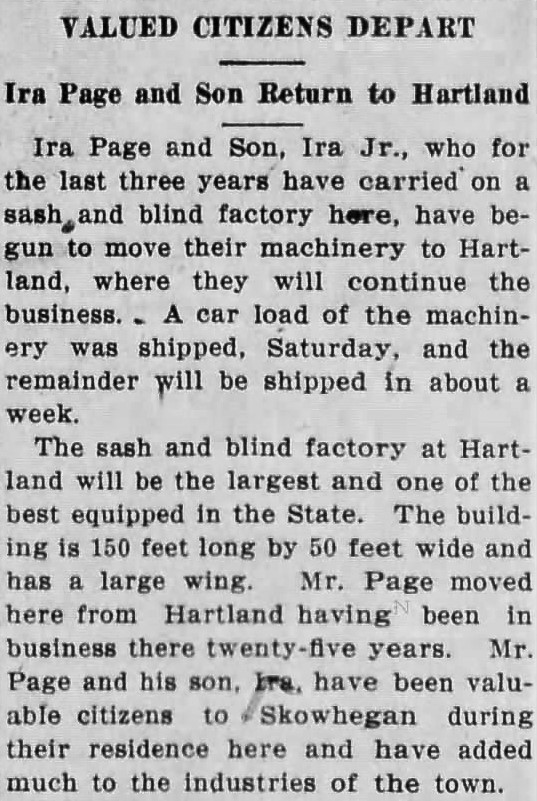
Skowhegan Independent Reporter – May 26, 1910
*
Fred Scammon Burrill was the next known occupant of the former Moore Woodworking Mill leasing it from the Linn Woolen Company and operating as the F. S. Burrill & Company by 1913. Fred was also involved with the Burrill Family Sawmill operations in North Hartland where his father Scammon Burrill owned a large lot of some 3,000 acres known locally as Burrill Woods.
Following the Linn Manufacturing Company Bankruptcy in 1915, the American Woolen Company took over the former Moor Lot as part of their buyout of the Linn real estate holdings in 1916. They also had little interest using it for themselves as they continued leasing the building to Fred who was still operating his business there in 1917 until he passed away on September 21, 1923. Research continues on the future occupants of the property and buildings but they remained under the ownership of the American Woolen Company until they were auctioned off in 1932.
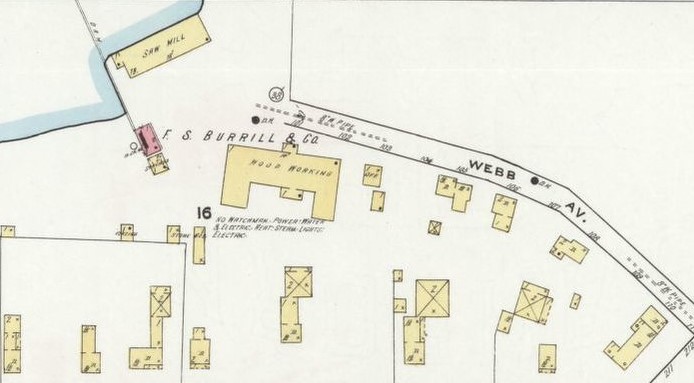
F. S. Burrill & Company Woodworking Mill – Sanborn Insurance Map 1917
*
Walter H. Moore eventually built another woodworking mill next to his house on North Street in 1923 with his surviving son Merrill Amasa Moore (1897-1976) where they began operating as W. H. Moore & Son Woodworking. Walter’s other son James Folsom Moor had passed away in 1918 at just 18yrs old from complications of Spanish Flu while attending Montclair Academy in New Jersey. Following Walter’s death in 1931, Merrill continued to operate the mill under the same company name into the early 1970s before retiring marking the end of 170+ years of Moor-Moore Family Wood Mill operations in Hartland.

W. H. Moore & Son Woodworking Sign
*
Our thanks to the many folks including Ted Griffith’s children, John, Joan & Susan, his nephews Jack & Jim Dyer and Ken & Geraldine Bishop’s children for providing numerous details to assist us in accurately portraying the Griffith Mill timeline below.
*
Frank Lee Griffith (1877-1937) was born in Hartland, the son of Lamont Griffith & Frances “Fannie” Olive Wright. Lamont Griffith had been a carriage maker on Main Street in Hartland in the 1880s. Frank married Annie Mabel Pickard in 1901. In 1905, Frank purchased the former James W. Moor Casket & Furniture Manufacturing building from the Linn Woolen Company which had been attached to the rear of James’ homestead on Moore Street.
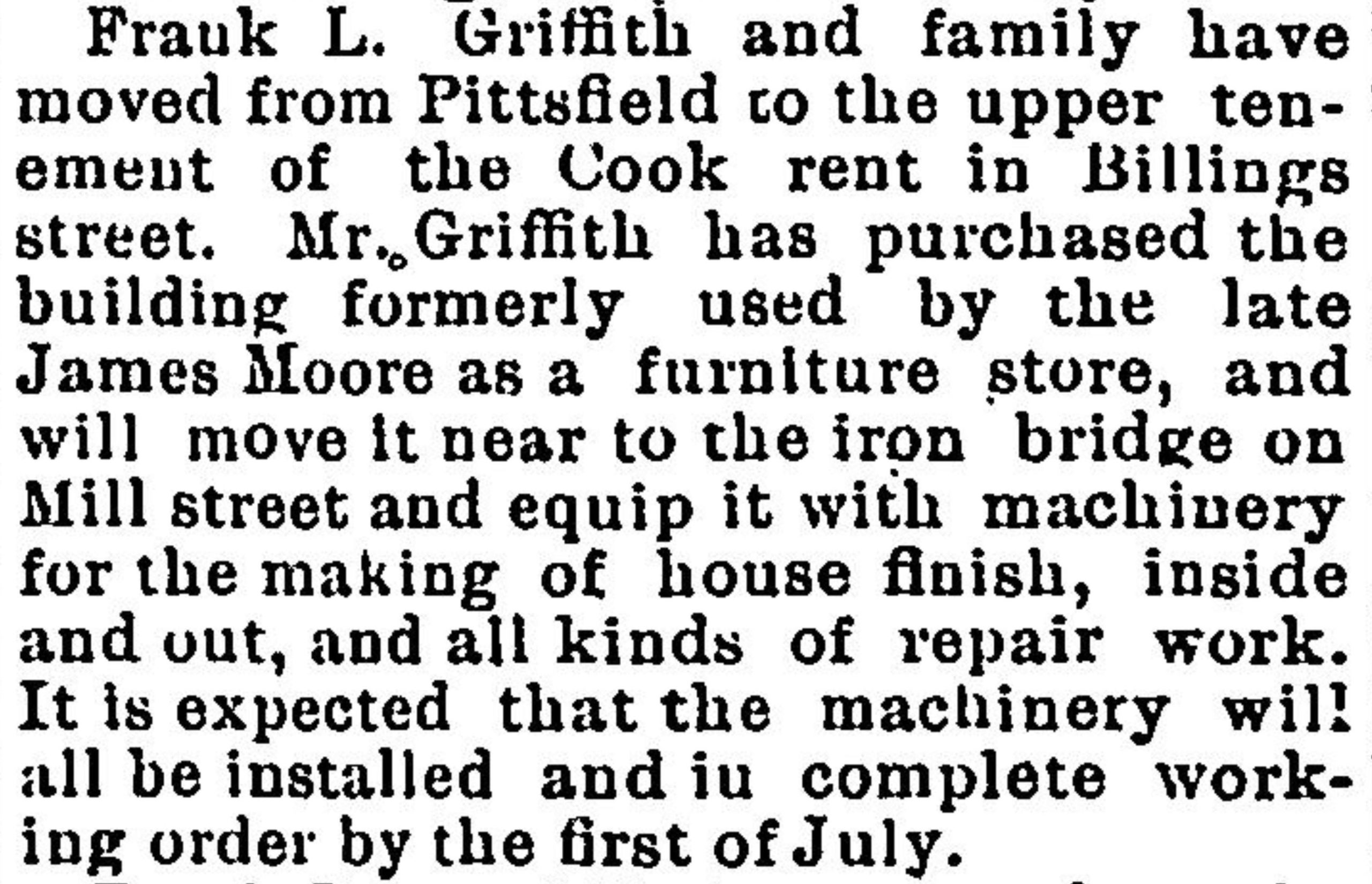
Pittsfield Advertiser Article – 1905
*
Frank moved the entire building down to the river lot next to the Mill Street Bridge and began his woodworking business in what came to be known as the “Big Shop” aka Finish & Planer Shop.
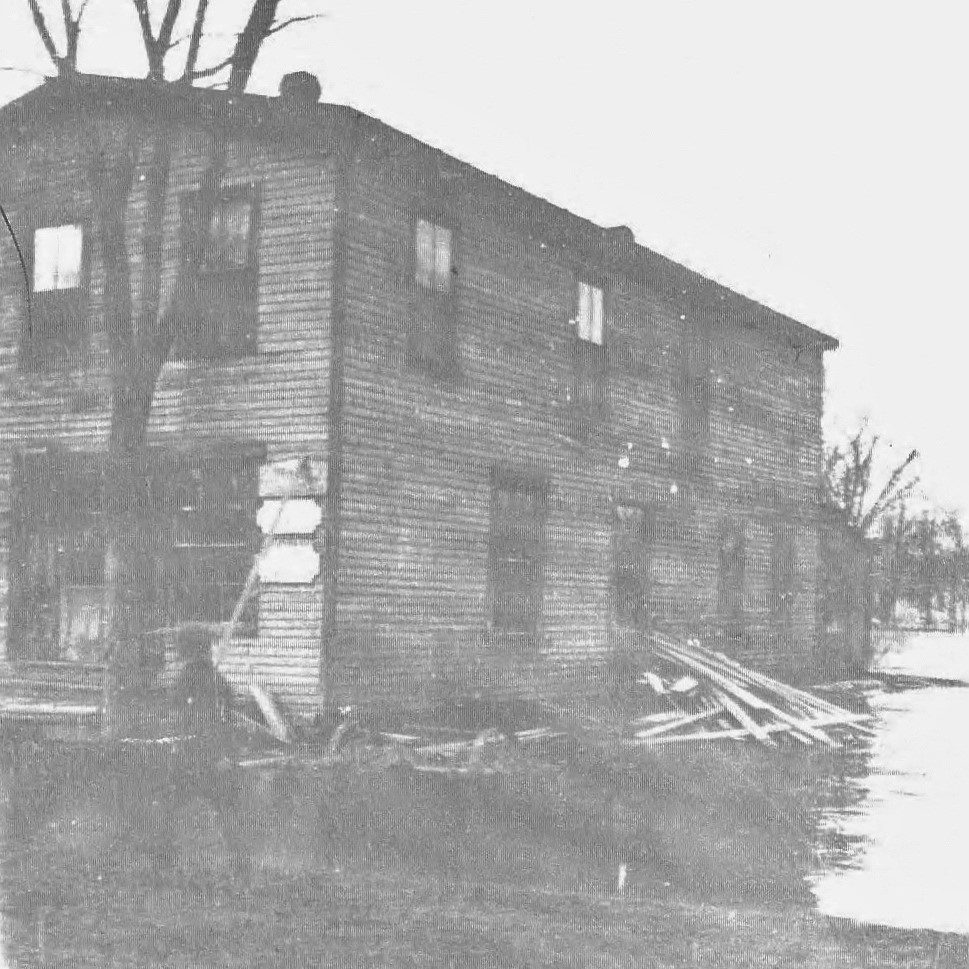
The former James W. Moor Building as Frank Griffith’s “Big Shop” with his daughter Esther – 1923
*
The river side lot where Frank located the Big Shop had been the location of a Blacksmith Shop as far back as at least the 1850s. Howard Temple later operated the Blacksmith Shop for Frank for several years. When the Sebasticook River was running high the entire lot would be flooded. During major flood events, water would rise up to and over Mill Street as seen during The Great Flood of 1923 which once again engulfed the Upper Dam & Mill Street area with high waters.
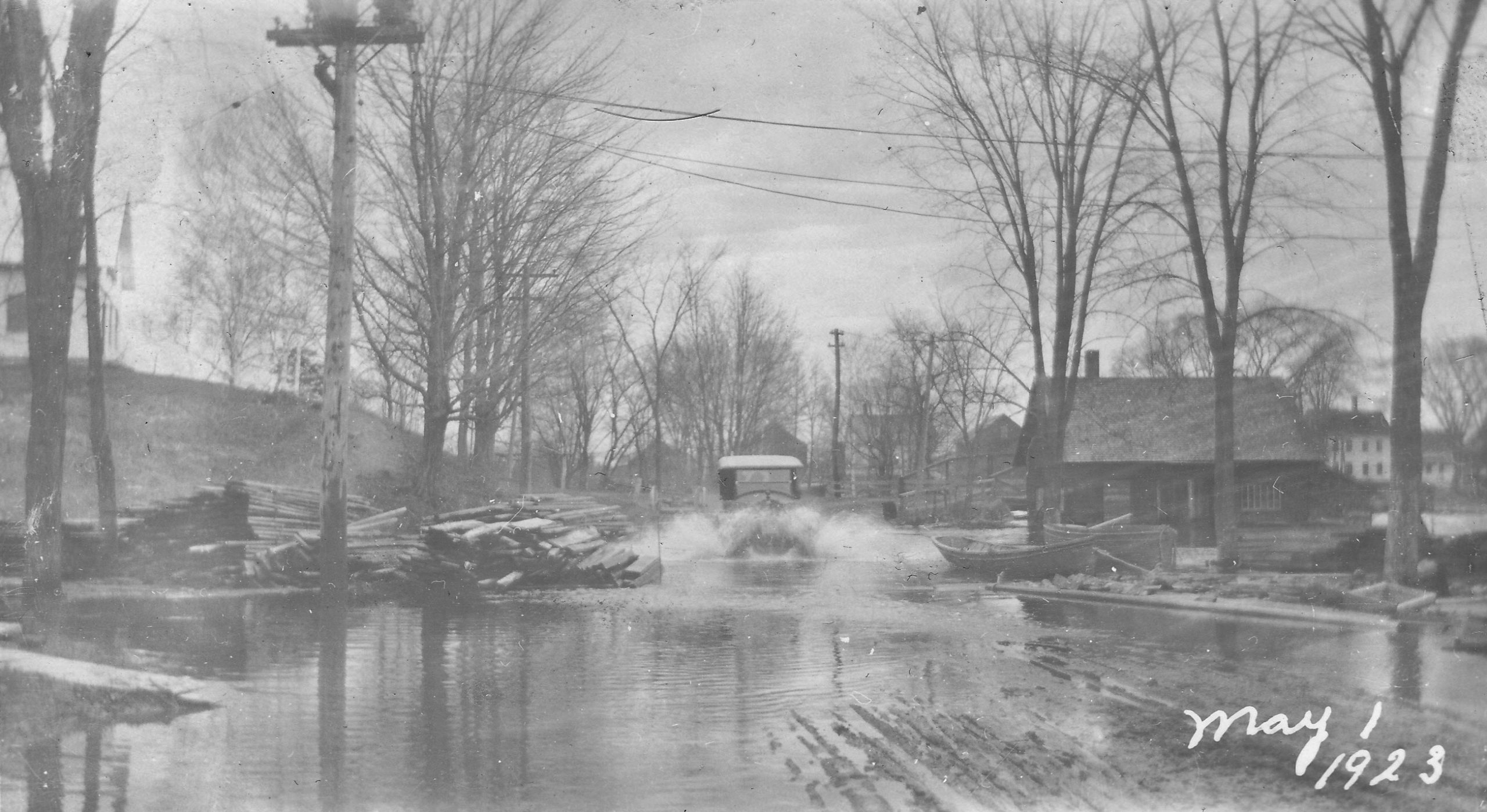
The Blacksmith Shop on Frank Griffith’s lot during the Great Flood of 1923
*
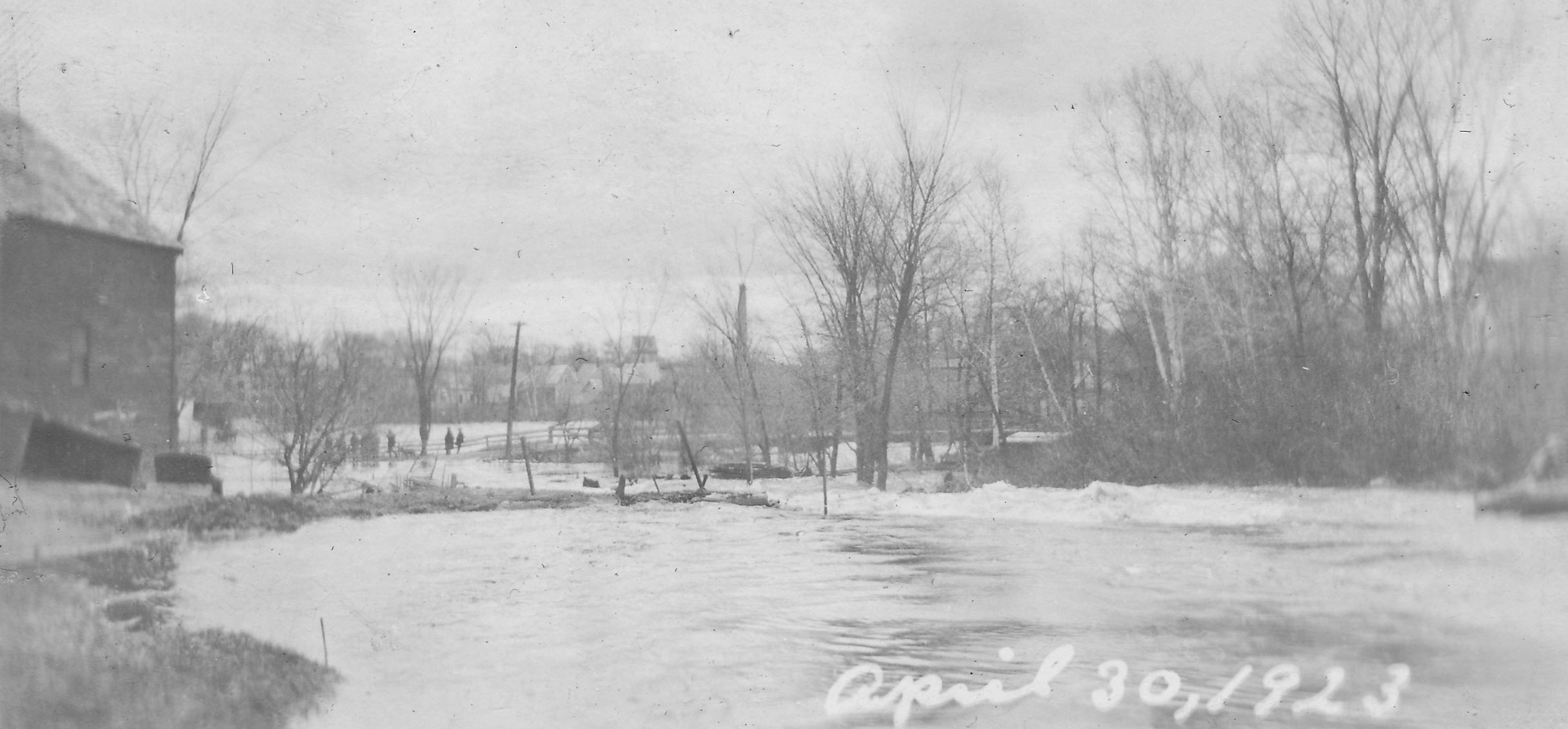
Mill Street Bridge engulfed by the Great Flood of 1923
*
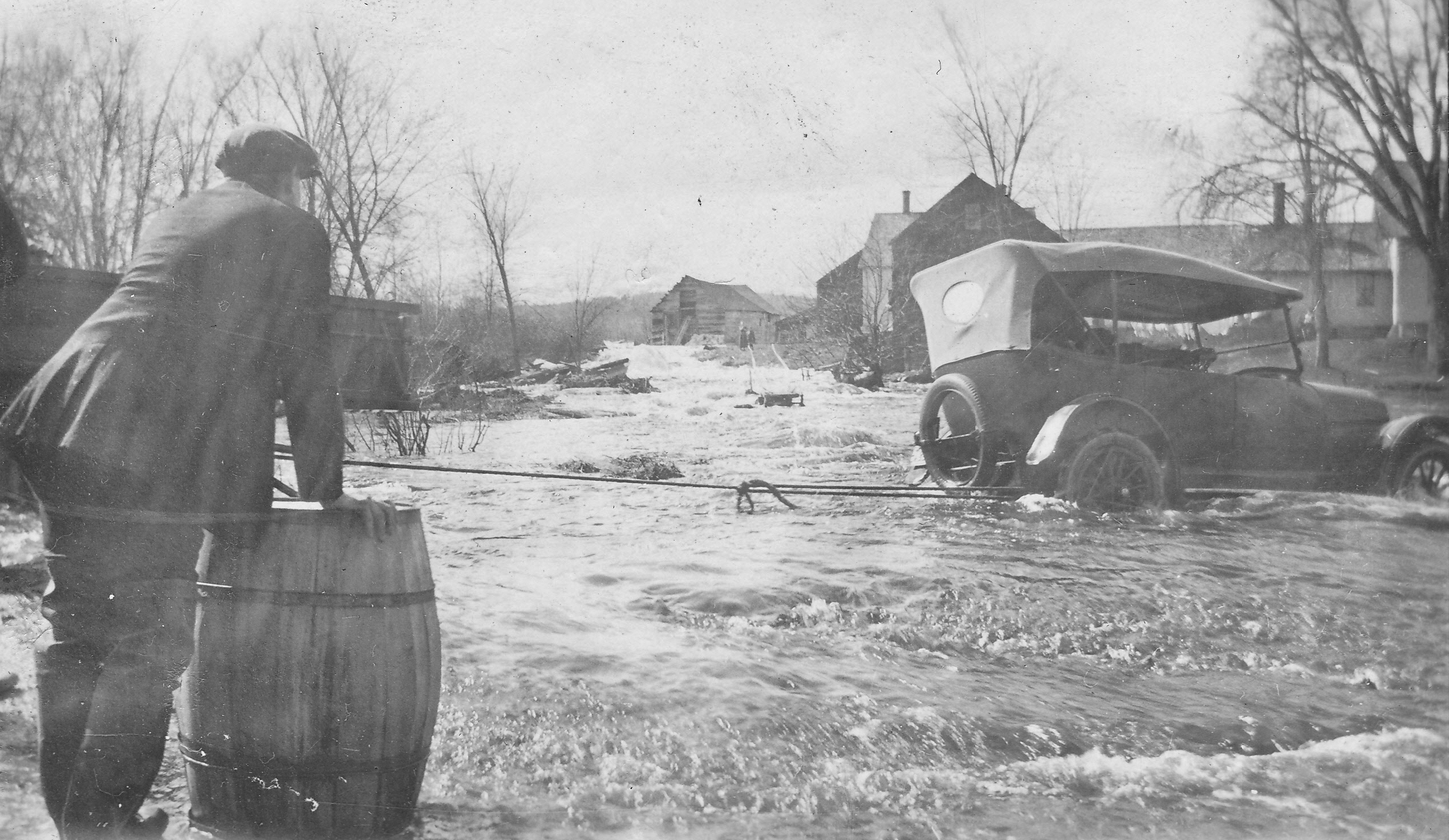
Frank Griffith assisting with an automobile rescue during The Great Flood of 1923
*
Frank had lived on Water Street (at the future Nichols house) in 1920 but soon moved his family to the 2nd Floor of the Big Shop. Other families would later live in the apartment including Fred & Barbara Harding (with their sons, Mark & Skip) as well as Roland Perkins. He also built a small garage sometime after this to the right side of the Big Shop where he stored some of his tools and later on his automobile.
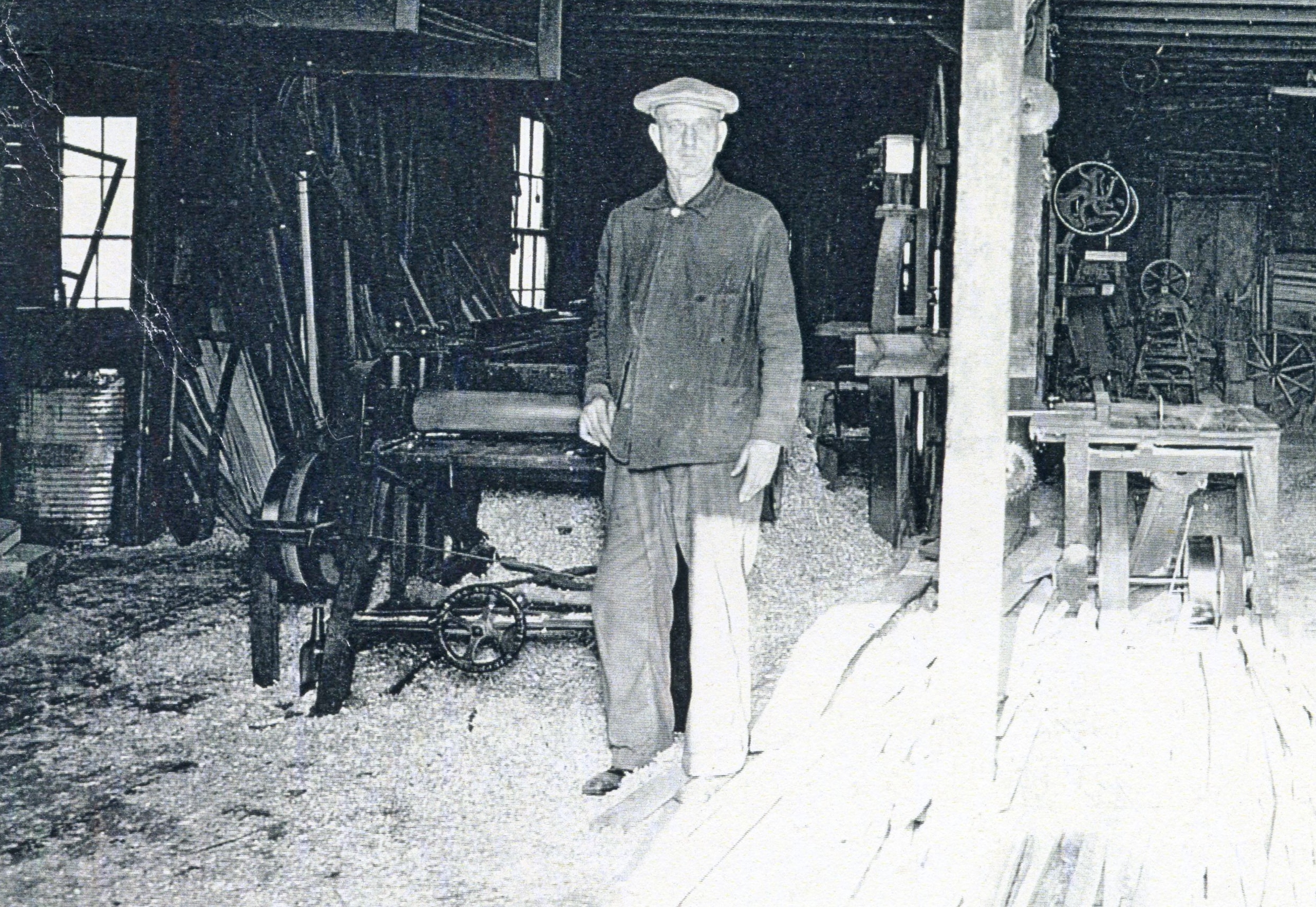
Frank Griffith at the Big Shop – c1930
*
Frank’s granddaughter Susan recalls, “My sister (Joan) and brother (John) and I were in and out of the Big Shop and the (future) sawmill all the time as children. My grandfather died long before I was born but the shop is just as I remember it (as seen in the photo above with Frank). When I was little, I used to run in there and drink from the water tap (seen to the right) by the window. The funny looking machine straight back with the fancy wheels was driven by hand. My father (Ted Griffith) told me that when he was a boy, he found a hole in the ceiling above the machine and one day, while his father was working it, he dropped a stone down through the hole that bounced and pinged my grandfather in the face. He said my grandfather never looked up, just flew up over the stairs and he got a ‘wicked’ smacking.”
*
Frank didn’t have a saw mill on the lot and instead purchased lumber as needed for orders. He made hundreds of wood items in his shop ranging from small to large orders for about every business and many people in Hartland. Several of Frank’s Work Order journals from 1915-1916 donated to the Hartland Historical Society by the Griffith Family document just some of the numerous projects he did including an order from Thomas Randlett for a wooden body for his ice delivery truck and another for Harold Baird’s fire wood delivery truck.
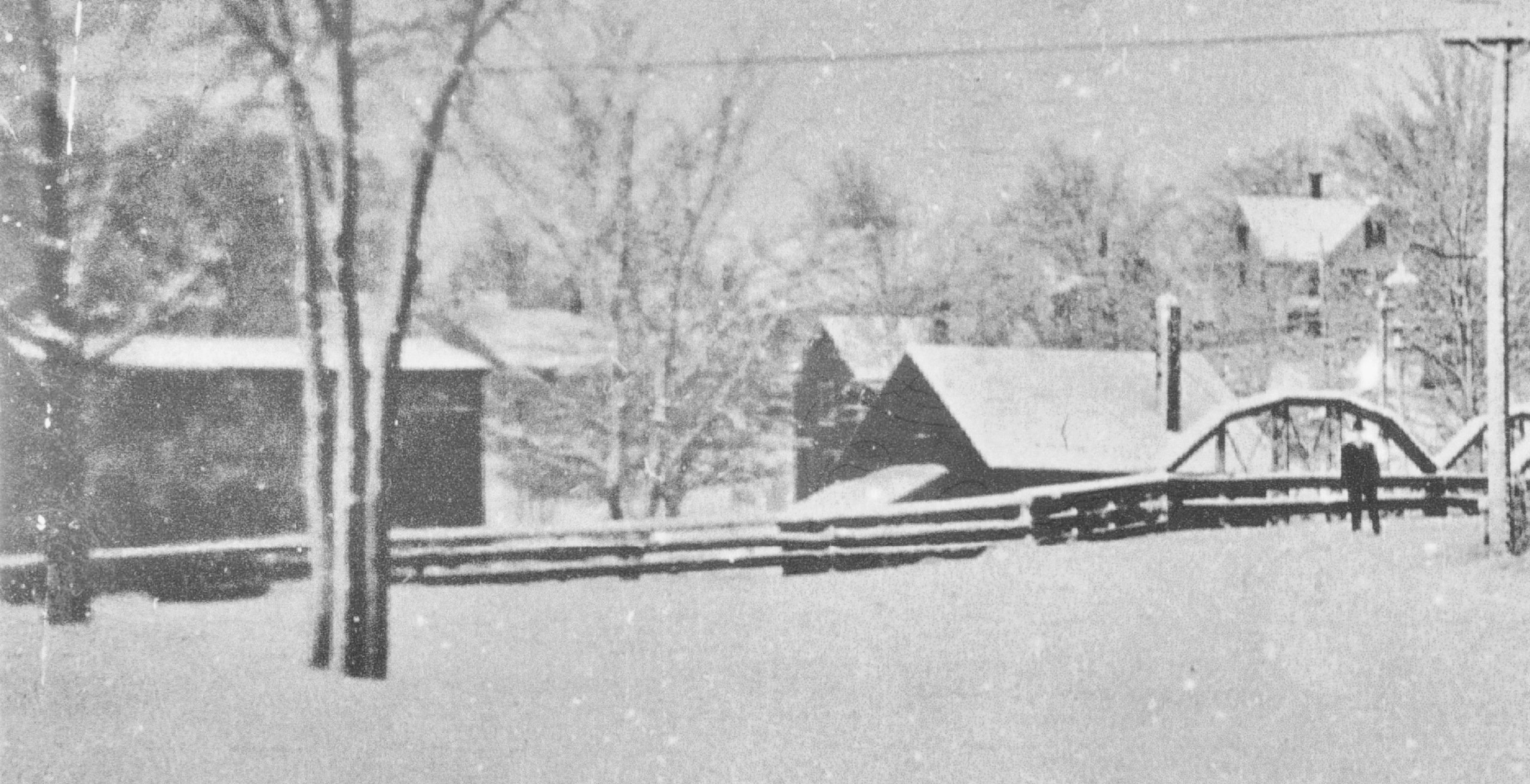
Looking back from Upper Mill Street onto Frank Griffith’s lot with the Blacksmith Shop to the right and the Big Shop to the left
*
The Great Auction of 1932 of the real estate holdings of the American Woolen Company included 2 properties on Moore Street, referred to then as Webb Street, as seen below from the original auction drawings & descriptions for lots #26 & #27 with purchase notes from the day of the auction.
26. NO. 49 WEBB STREET: (Moore Street) Approximately 8,600 square feet of land with two story frame cottage having seven rooms, bath, electricity with barn attached. (Purchased by Charles Wilford Mills for $325)
27. LAND & BUILDING: (Moore Street) Approximately 1.6 acres of land with Factory Building thereon. Detailed description will be available at time of sale. (Reserved) Former Amasa J. Moor & Son Woodworking Mill eventually purchased by Ivar Pearson)
Ivar Pearson, Sr purchased the former Amasa Moor Factory soon after the 1932 Auction and produced bowling pins and wooden shoe inserts before selling it to the SellWell Products Company in 1946 and moving to Athens where he opened another factory for the same products.
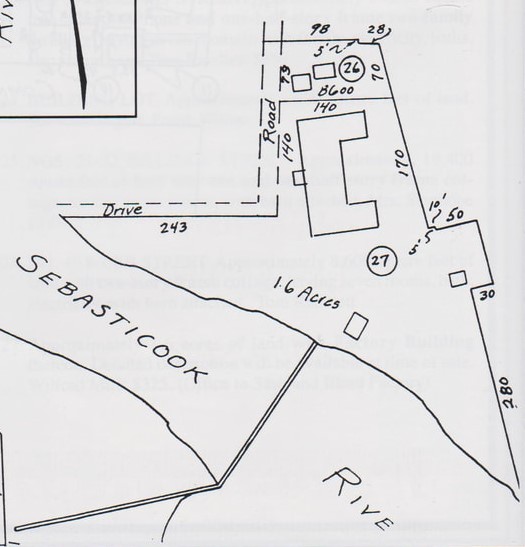
Great Auction of 1932
*
Upon Frank Griffith’s death in 1937, his son Theodore Franklin Griffith (1913-1968) inherited the mill just before his 27th birthday. Ted and his wife Evelyn Faye Hersey, who he married in 1935, eventually lived a little further up Mill Street next to the future library.
According to his family, Ted hadn’t worked at his father’s shop much before this point working instead at the American Woolen Mill and for Harry Randlett at the Hartland Hardware Store as a young man. At the time of Frank’s death, Ted was working for the Hunting & Rowe Sawmill on Pittsfield Avenue (behind the future Tasker house) which closed in the early 1940s. At this point Ted decided to go into business for himself but instead of continuing his father’s wood working operation, he built a saw mill in between the Big Shop and the Black Smith Shop purchasing much of the sawmill machinery from his former employer. He left the Blacksmith Shop intact where Stanley Bates housed his team of horses.
Ted first began sawing large pine & hemlock logs into lumber using his Moore Street lot to stockpile larger logs before they were sawed up. He later re-tooled the sawmill to saw smaller cedar logs which were used as cabin stock. To the left of the sawmill next to the bridge is where many local Hartland kids peeled and draw shaved bark with the finished pieces of cedar cabin stock sold to the L. C. Andrews Company in Portland.
*
The mill changed hands once when Ted sold the business to Everett “Hammie” Ham in the late 1940s. Hammie operated it for a couple of years while Ted planned to build another mill on his Moore Street lot however Hammie was discontent with the purchase of the mill so they traded. Ted owned the shop once more and Hammie acquired the land on Moore Street where he would build his house.
*
Around 1955, Ted sold the sawmill to Joe Cianchette (an Uncle of the Cianchette Brothers of the Cianbro Company) but he continued operating it for Joe for several years. It was around this time the old Blacksmith Shop was torn down. In 1958, an addition to the sawmill was built on the bridge side where the old blacksmith shop had stood which was built for Joe by Ted, his son Keith Griffith, E. Claire Russell & Earl Page.
*
Ken Bishop (1910-1992) and his brother Harold had operated a cedar sawmill in St Albans in the 1950s where they specialized in cedar fencing which later burnt. When the St Albans mill operation ceased, Ken began talking with the Maine Forestry Department to discuss possible new wood business ideas. Through these discussions, he discovered there was a great demand for all wooden elm barrels and an abundance of seldom used elm trees in Maine at the time. He decided on finding an appropriate location to begin his new business venture and in 1958 purchased the former Griffith Sawmill from Joe Cianchette. Ken had married Geraldine Knowles in 1941 and lived on Blake Street. Ken tore down the “Big Shop” soon after he purchased the business as it had deteriorated to an unusable condition.
Ken re-machined the existing sawmill for his needs utilizing a pair of old specialized machines he purchased in Van Buren said to have been built in the 1860s. Operating as the Elm Hoop Company, they began making the all wooden barrel hoops which were sold to potato farmers in Northern Maine, fishermen on the coast of Maine as well as Chesapeake Bay crab fishermen in Maryland. Wooden barrels with wooden stays were used since they could be steam cleaned and would not rust. The barrels were made only from elm trees because they grew so straight.
*
Further details of the Elm Hoop Company’s history and operations were featured in a newspaper article soon after Ken sold the business to Kermit “Topper” Badger in 1972.
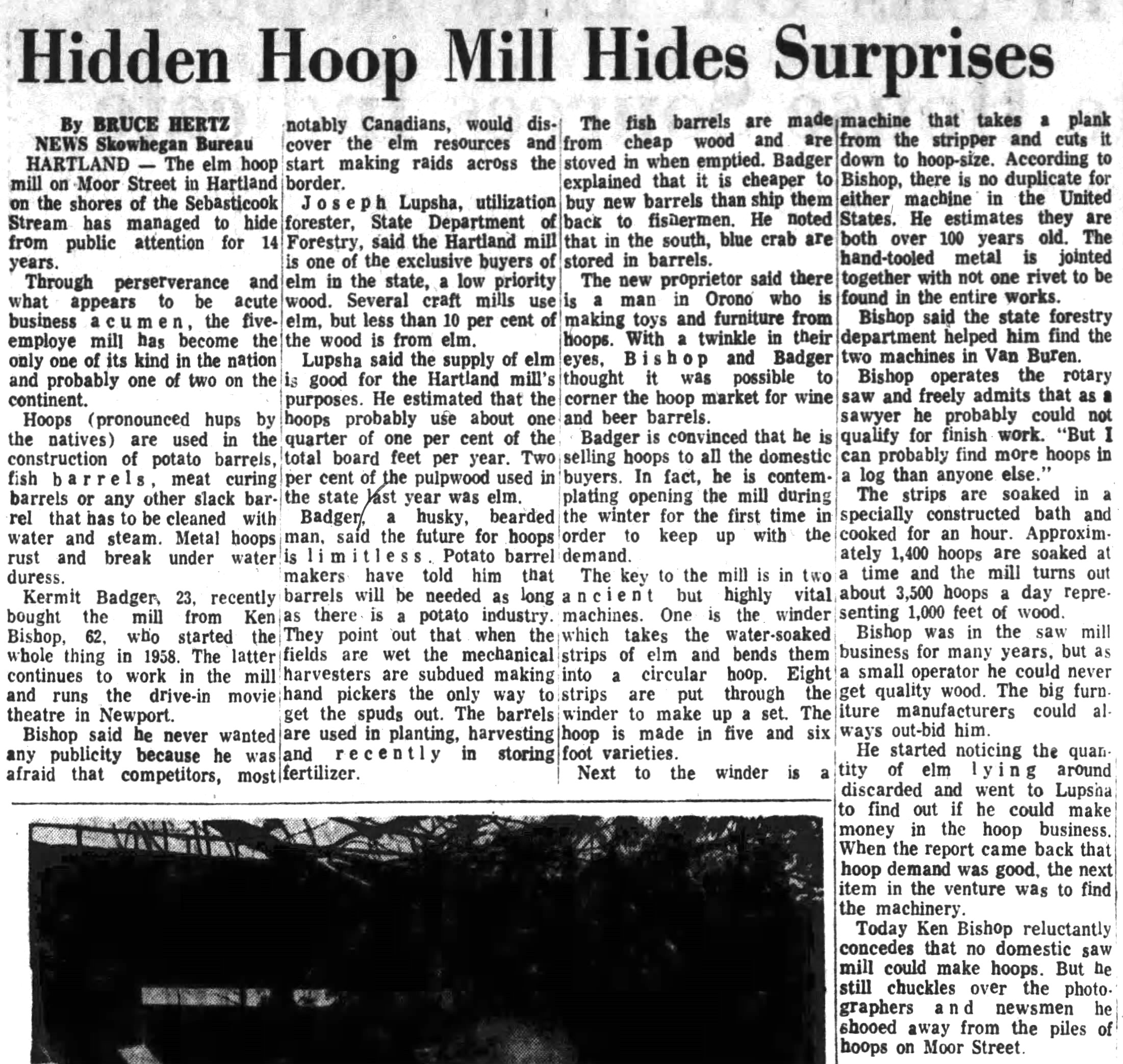
Elm Hoop Company – Bangor Daily News – October 25, 1972
*
Kermit Badger continued operating the Elm Hoop Company Mill until 1978. The 1958 addition to the original sawmill is seen to the left.
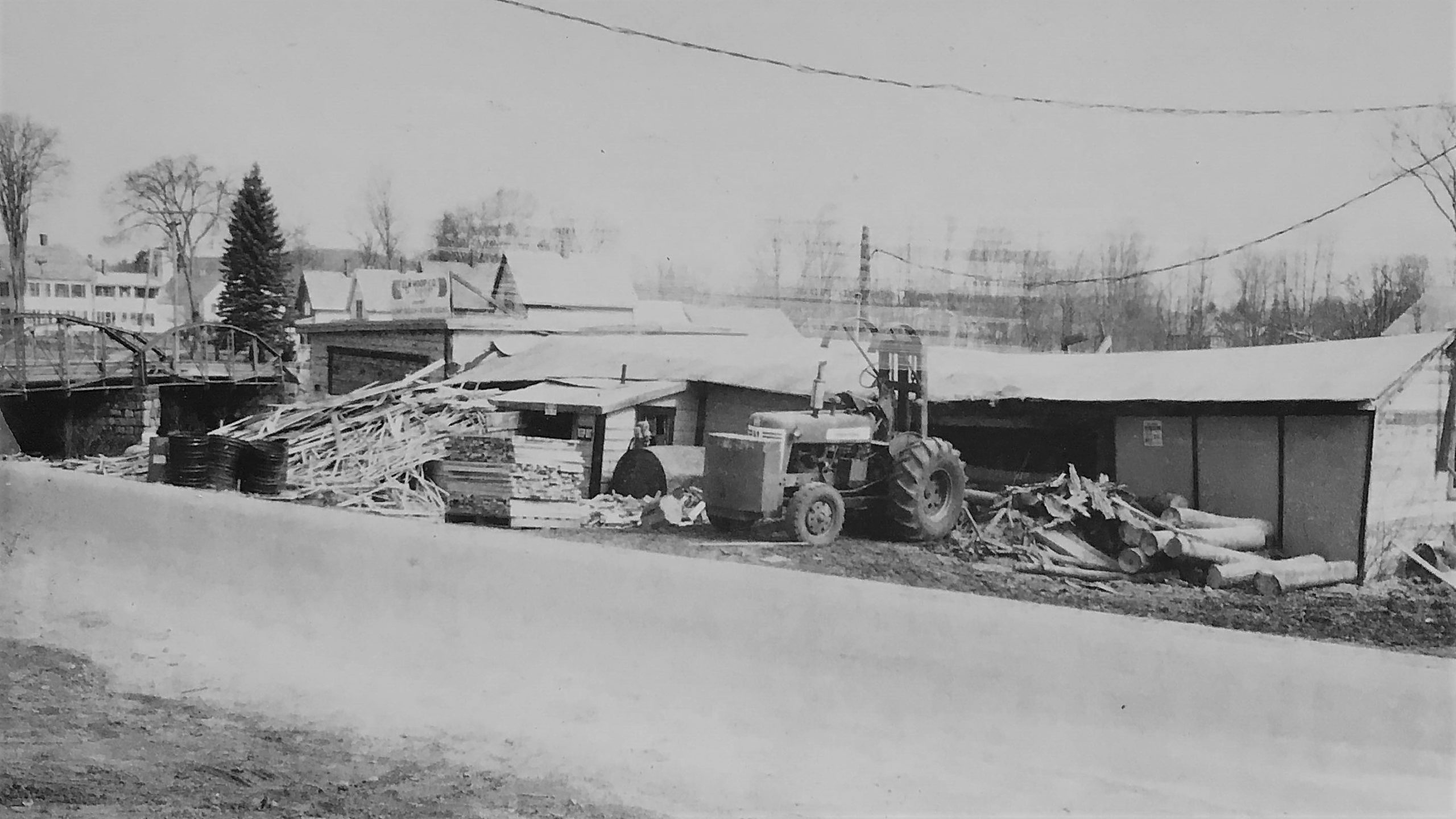
The Elm Hoop Mill in the 1970s.
*
On Wednesday, July 12, 1978 fire destroyed the Elm Hoop Mill owned at the time by Kermit Badger.
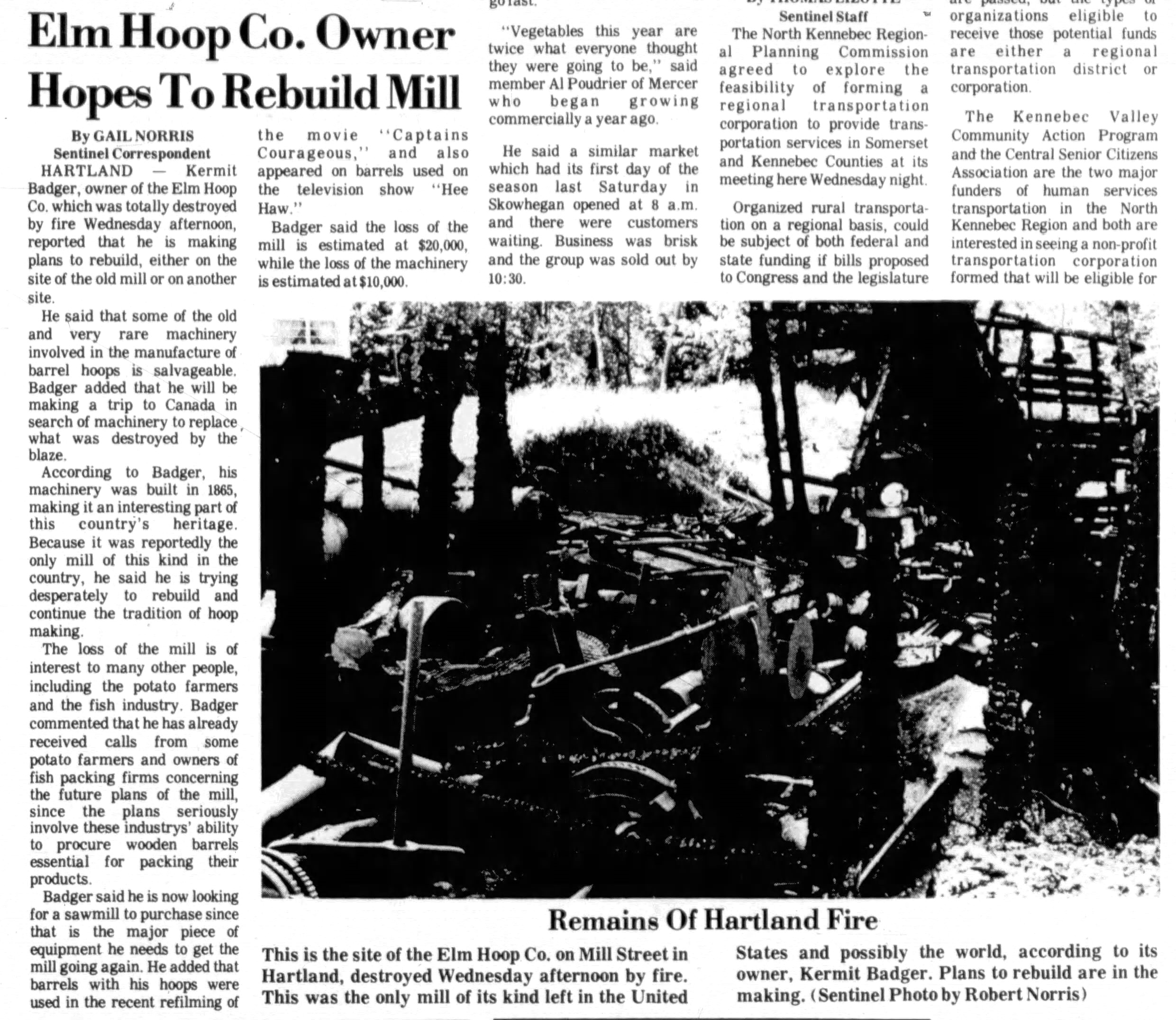
Elm Hoop Mill Fire – Morning Sentinel – July 14, 1978
*
A clearer version of the photo in the article above from a clipping of an original newspaper.
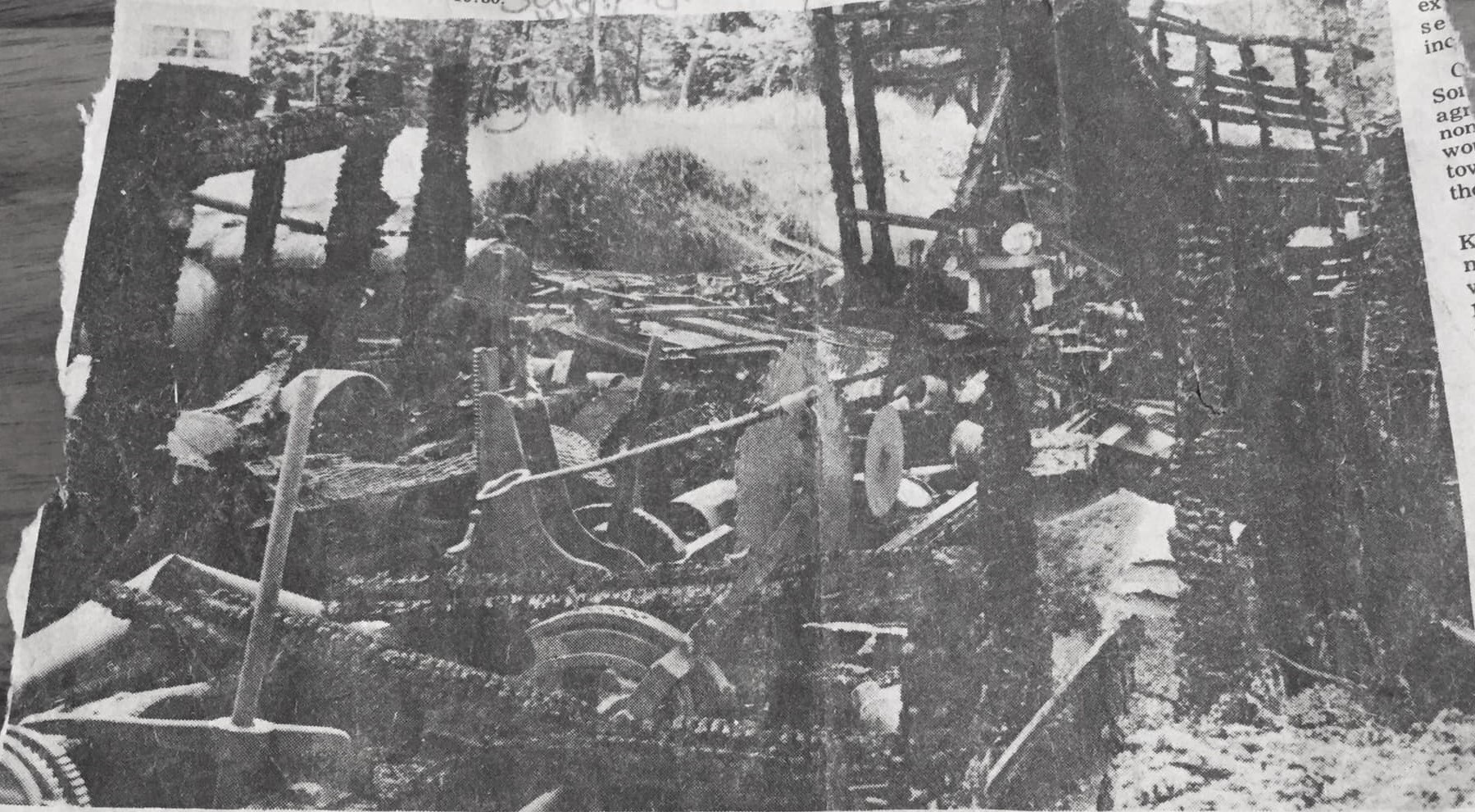
Elm Hoop Mill Fire Photo – Morning Sentinel – July 14, 1978
(Courtesy of Kari Jolly Cook)
*
As noted in the 1978 article, Topper had hoped to rebuild the hoop mill following the fire but those plans never came to fruition. The remaining debris of the burnt out hoop mill was razed turning the location into an empty lot which it still remains as today.
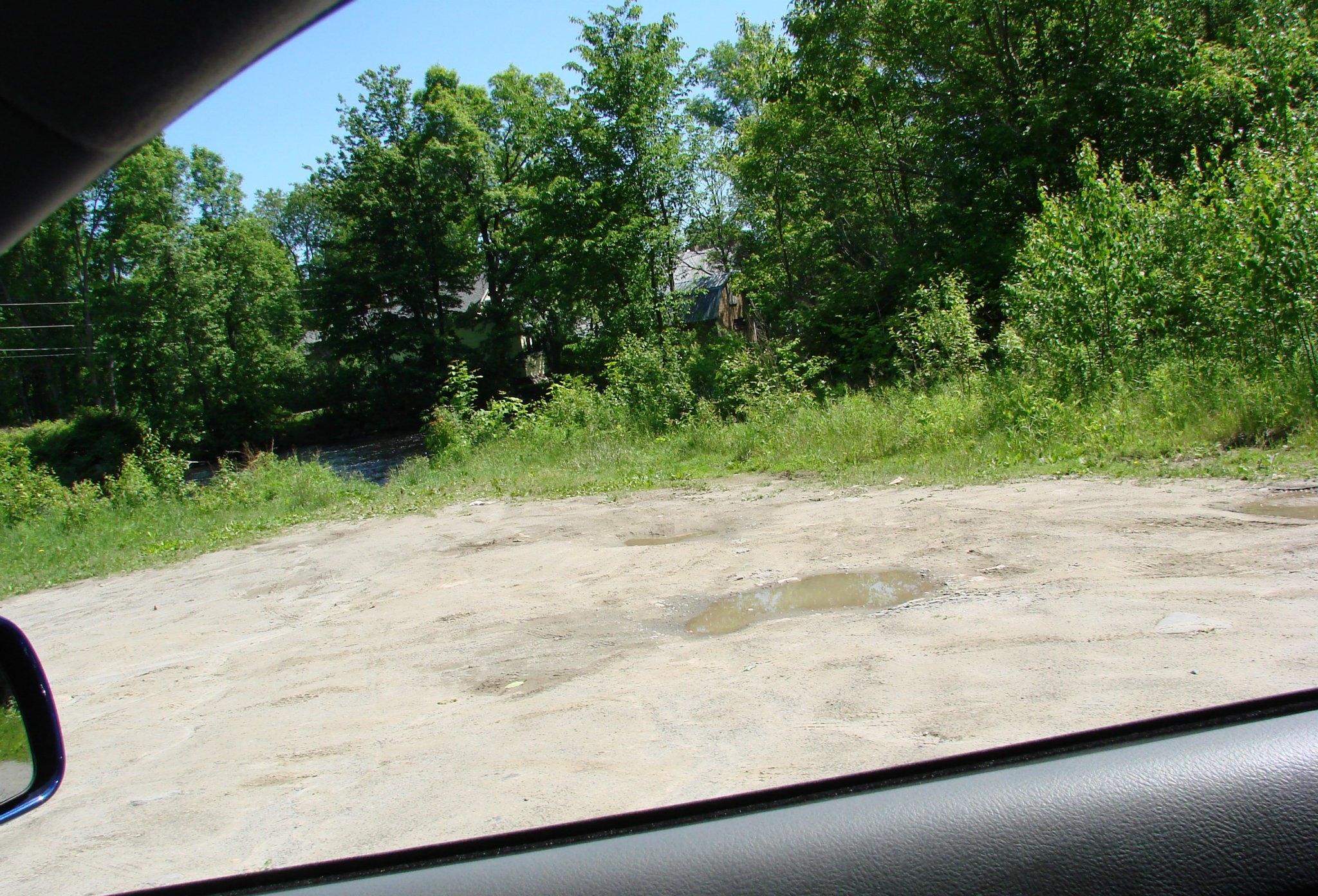
Part of the vacant lot where the former Griffith-Bishop-Badger Mills stood – 2012
*
On November 1, 1915, Ralph C. Hamilton and James C. Young partnered in a skirt manufacturing business venture and leased the former Walter E. M. Seekins Store Block on Commercial Street to locate a shop. Within a week, as reported in a November 17, 1915 Morning Sentinel article, they had 20 Singer sewing machines installed and were producing sample skirts reporting they hoped to eventually employ upwards of 50 people. James Young is the father of long time Town Clerk, Ruth (Young) Steeves.
Following successful operations at the Commercial Street location, they decided to expand production capabilities and construct a new larger building on Mill Street. They incorporated on August 23, 1916 as the Hamilton & Young Company and in early September ground & foundation work on the empty lot purchased from Daniel A. Packard had begun. By October 1st, construction began on the building named as the Daylight Skirt Factory with a planned opening of manufacturing operations set for December 15, 1916.
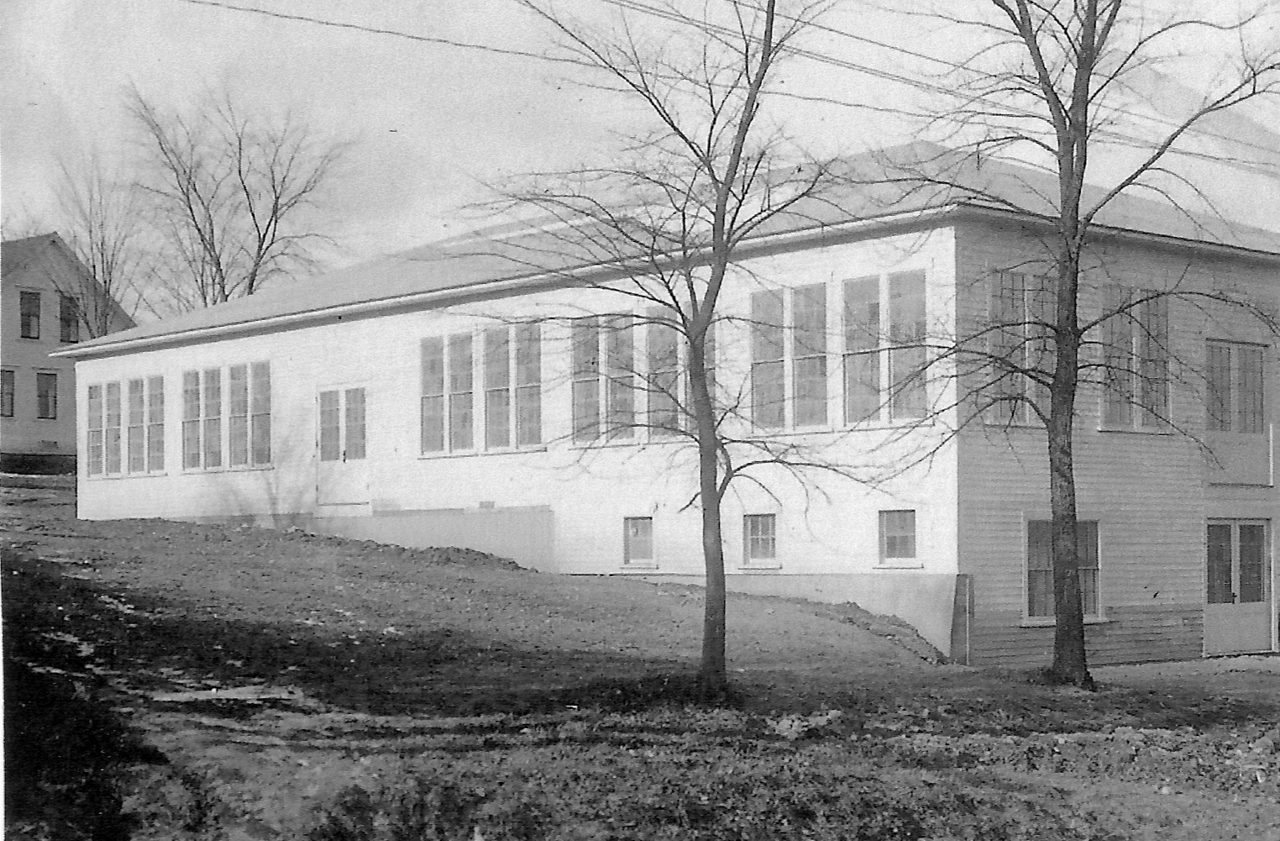
Postcard of Daylight Skirt Factory owned and operated by R. C. Hamilton & J. C. Young – c1917
(Courtesy of Maggie Smith)
*
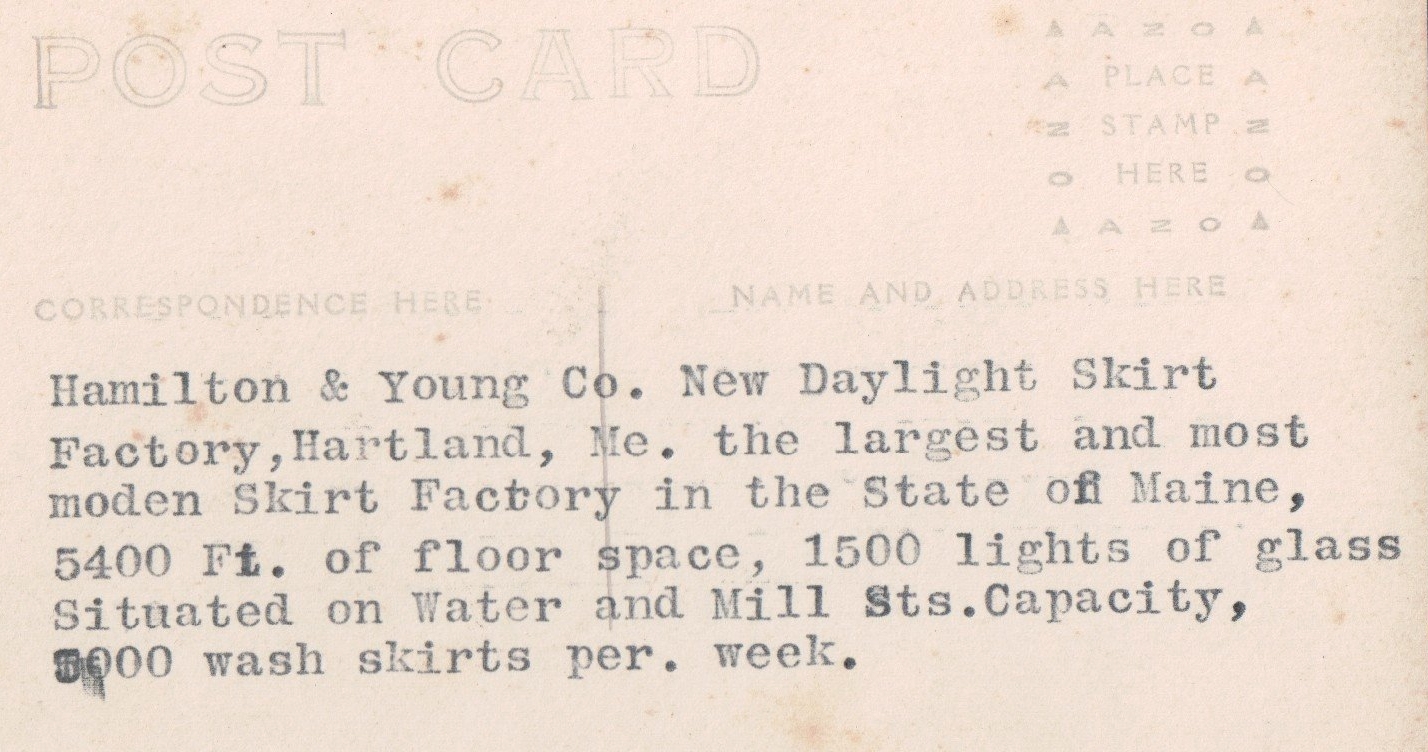
Description on back of Postcard
*
The new building was opened with a large dedication ball held on December 1, 1916 before being fitted with machinery.
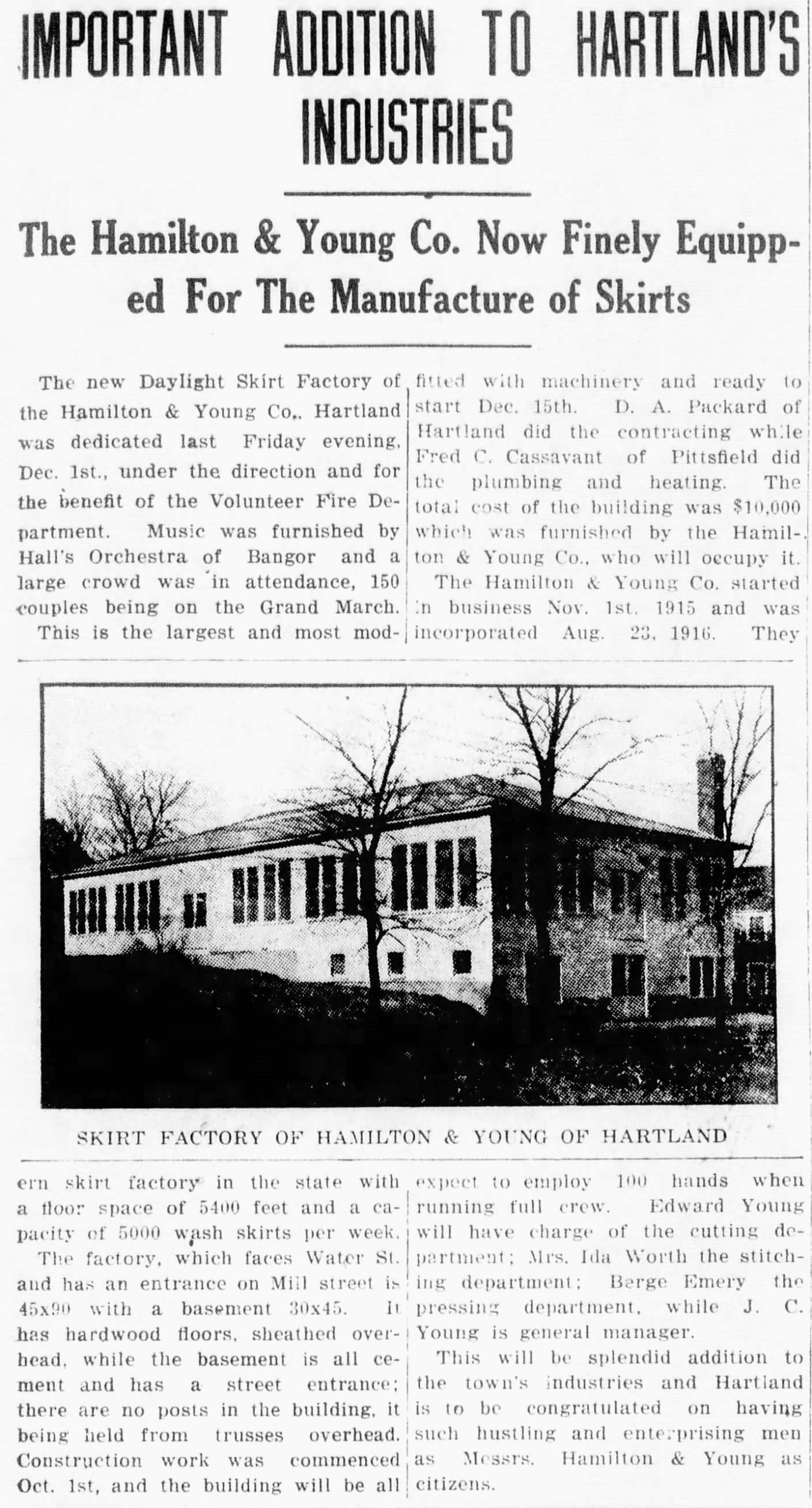
Hamilton & Young Company – Daylight Skirt Factory – Independent Reporter – December 7, 1916
*
By 1919, the Hamilton & Young Company had turned their focus to manufacturing men’s flannel shirts but the business closed in the mid-1920s.
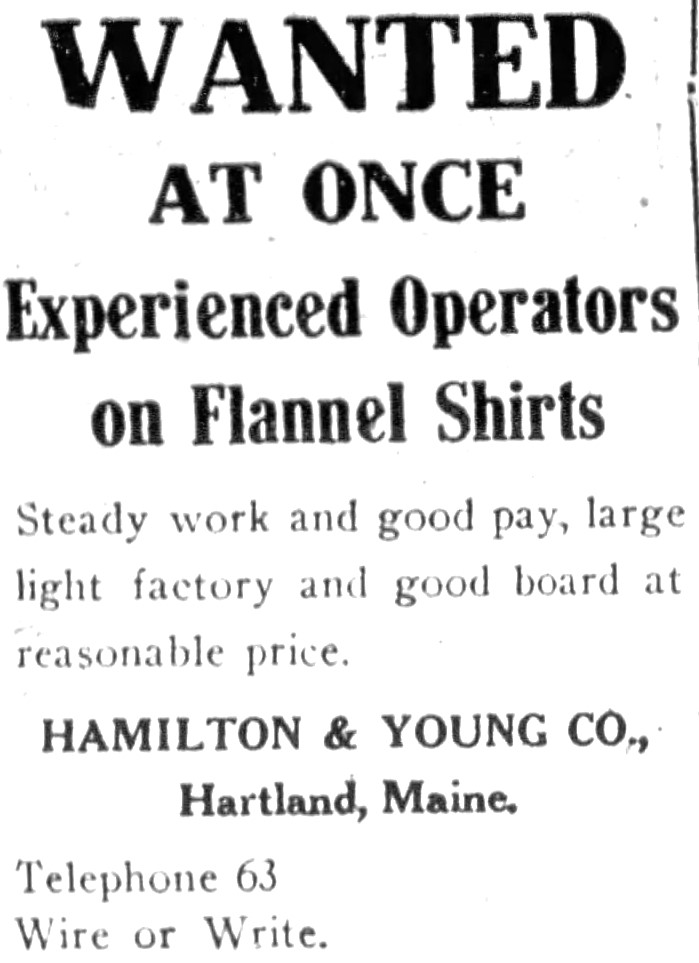
Bangor Daily News Ad – August 9, 1919
*
An undated photo reveals the interior of the Daylight Skirt Factory building with its large compliment of windows as several couples pose for a photo during an unknown event. Among the attendees are Miss Jean Anderson (1885-1972), 2nd lady from the left, with her dance partner.
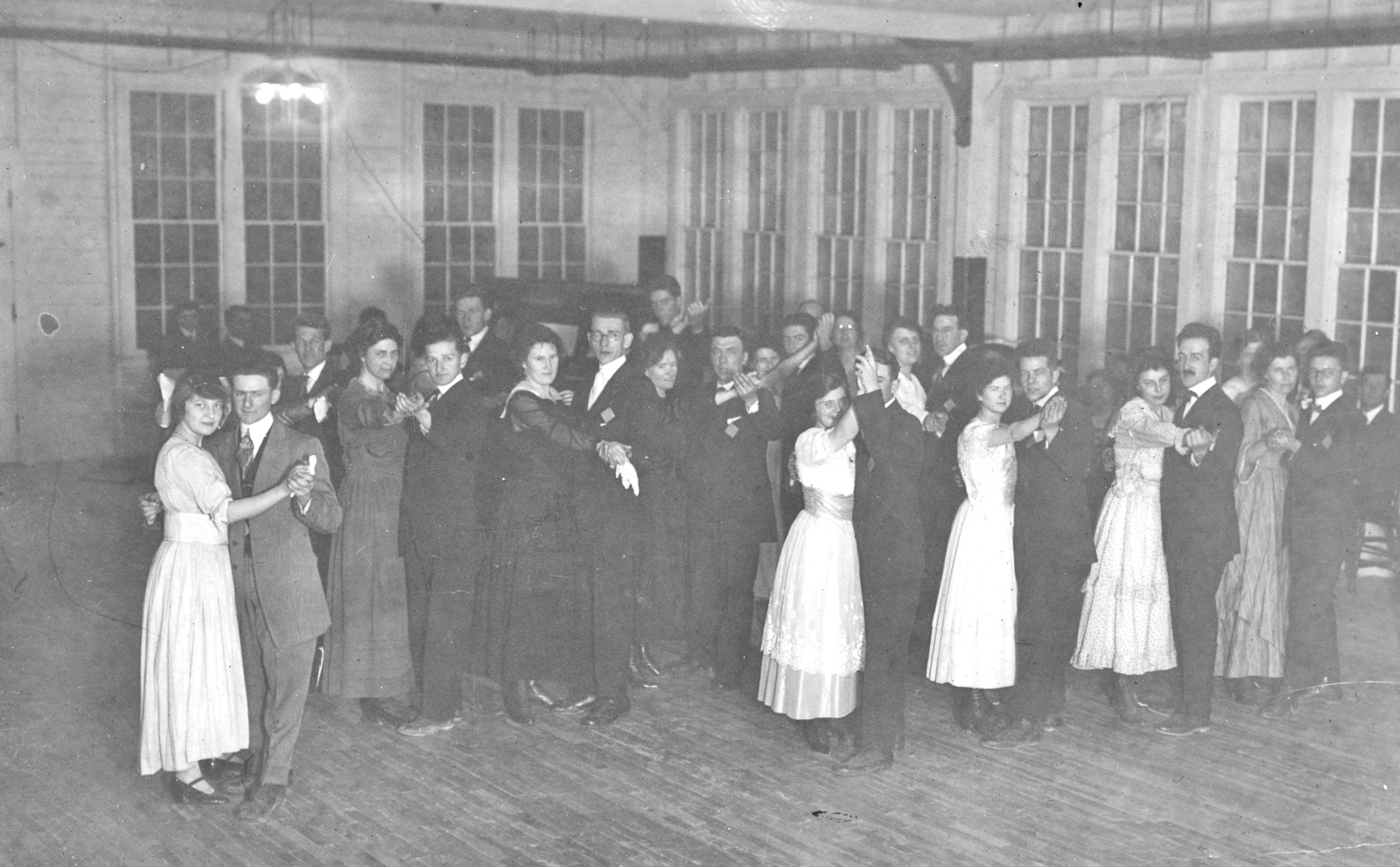
Daylight Skirt Factory – Mill Street
(Courtesy of Maggie Smith)
*
Following the 1932 American Woolen Company bankruptcy filing and their departure from Hartland, a citizen led group proposed a private stockholder funded shoe shop business to replace it. As the group considered options to locate the shop, Ralph Hamilton offered his former Daylight Skirt Factory as a possible location.
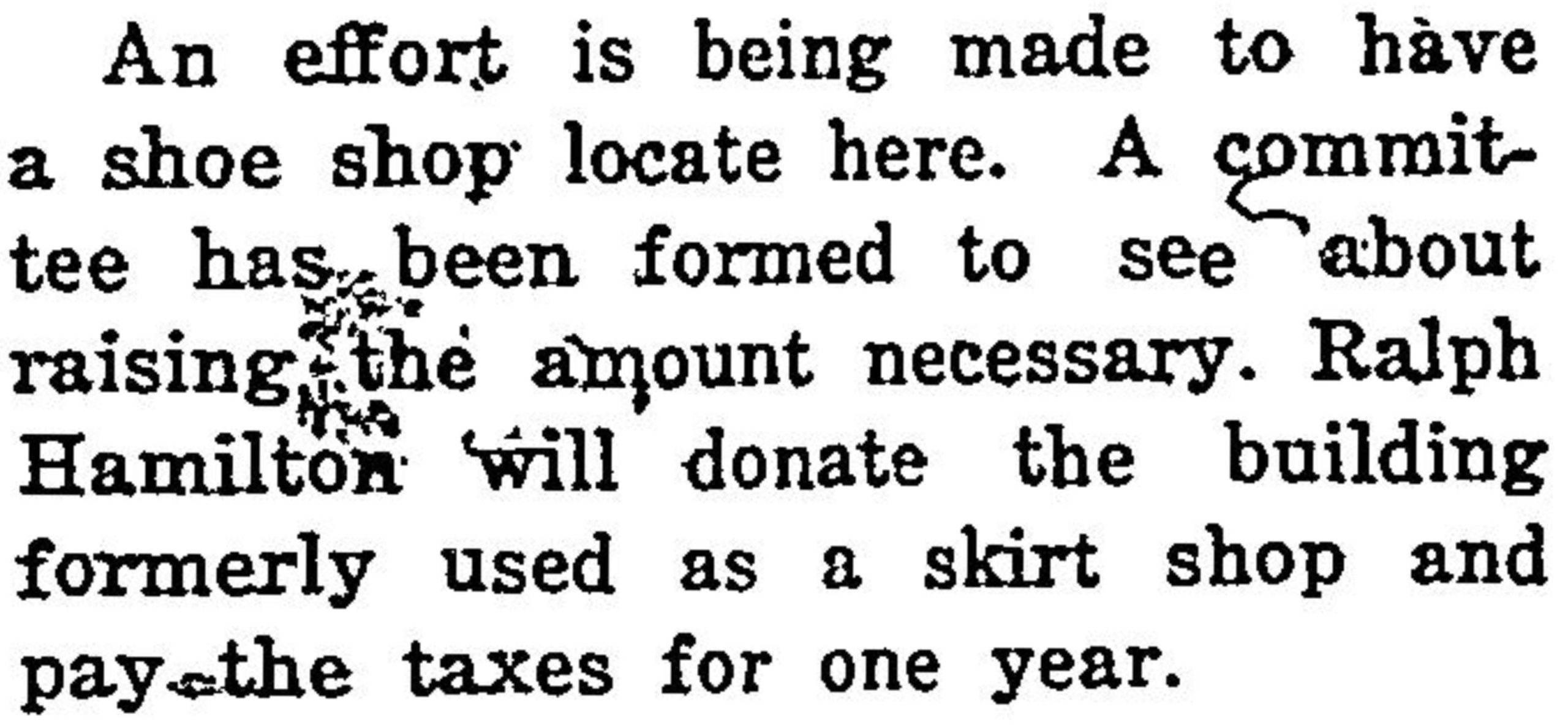
November 27, 1933
*
The Shoe Shop plan never came to fruition however it did not stop citizens from pursuing other options. A new plan of action began in 1934 with the creation of another citizen led group which would incorporate as Hartland Mills, Incorporated. They would focus their efforts to bring a new industry to town utilizing the existing mill buildings on Main Street and the former Daylight Factory building would remain vacant.
*
In 1936, Rae Fuller Randlett purchased the former Hamilton & Young Daylight Factory building which was reported as still vacant at the time. Rae eventually elevated the basement level of the building 3 feet and soon after leased the basement floor to H. C. Baxter & Brother Canning Company for storage. In 1938, Rae leased the 2nd floor of the building to Guy Elwood “Ed” Knowles who began operating as The Blue Moon Rink featuring dancing & roller skating. The Blue Moon was one of several popular dance venues in the region including dance halls in St Albans and Solon where dozens of couples gathered on Friday or Saturday Nights.
In the early 1940s, Ed ceased operations at The Blue Moon and began working on a couple of other business ventures around the state culminating with his plan to build a racecar track which opened in 1948 as Unity Raceway. In Ed’s absence, several local groups used the 2nd floor of the building for various fund raising events including the Hartland Volunteer Fire Department’s Annual Ball and the Hartland Lion’s Club Game Supper. In 1945, the Hartland American Legion began sponsoring occasional benefit dances and in January of 1946 leased The Blue Moon for a series of scheduled dance events throughout each weekend of the year.
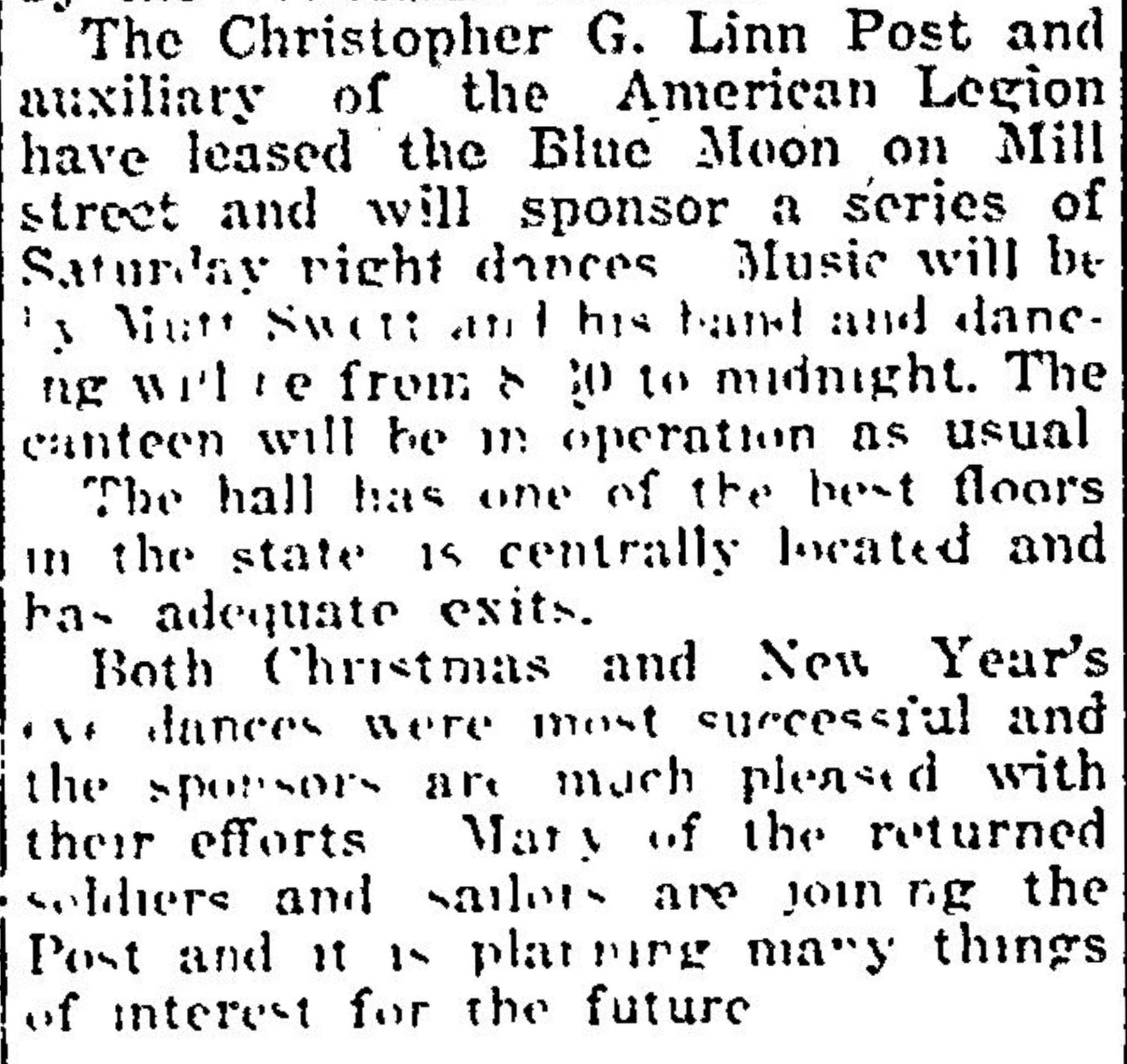
January 3, 1946
*
In June of 1947, Frank B. Allen, Jr leased the 2nd floor from Rae and operated as Skateland Roller Rink. Frank had managed several rinks including Riverside Rink in Skowhegan for his father over the years who had opened his first roller rink in Bangor in 1913. Frank opened a Skateland Roller Rink in Sebec in 1949 and eventually another in Dexter in 1959. Along with the regular skating schedule, Frank held several different roller skating carnivals, roller skating dance classes and numerous unique skating competitions at the Hartland rink attracting people from all over Maine including annual competitions for Miss & Mister Skateland, Skateland King & Queen and Junior Miss Skateland.
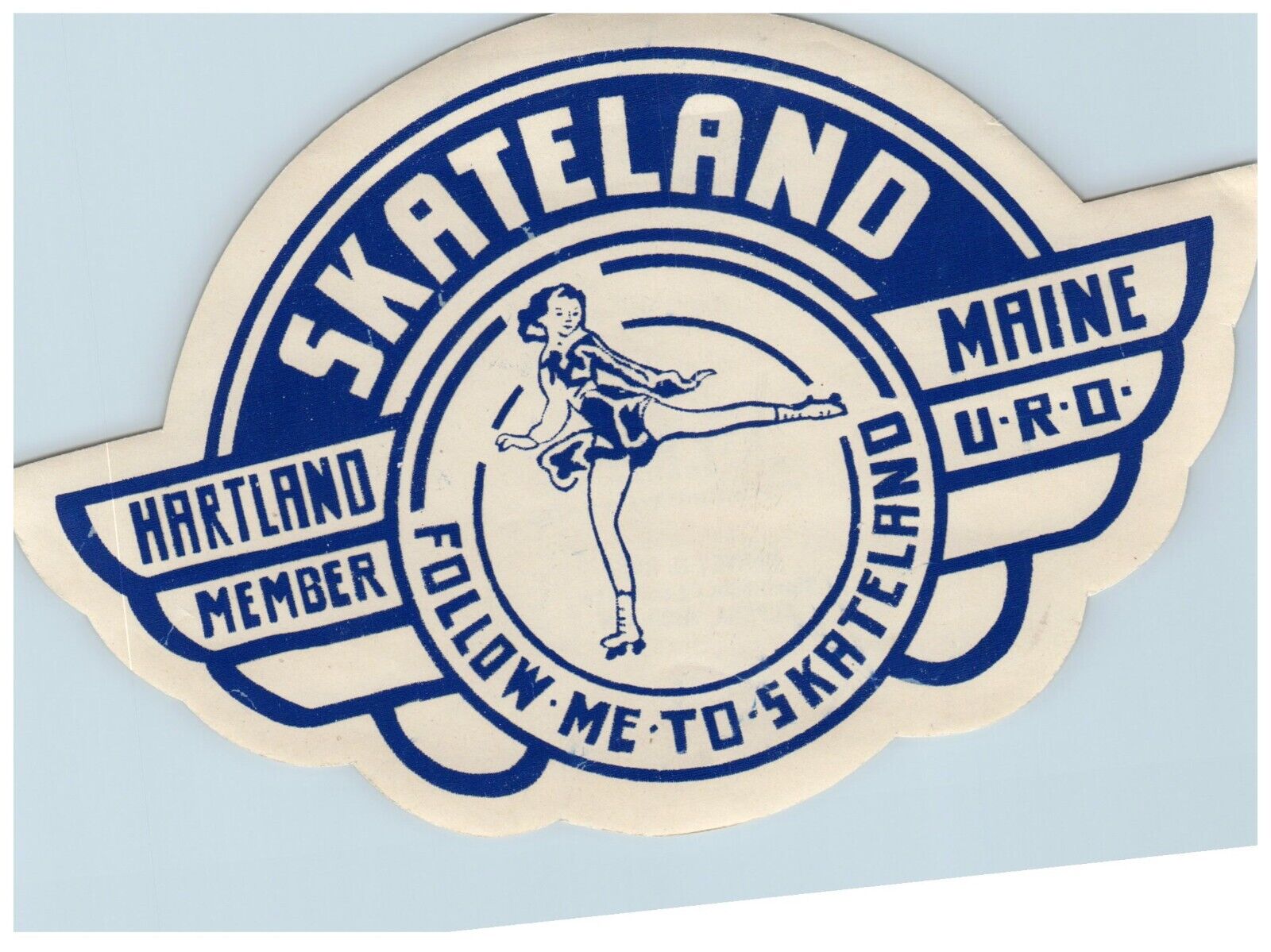
*
Edmond H. Seekins and Corinne Moore (his future wife) were crowned King & Queen at a Skateland Roller Rink Carnival Event in the late 1940s. Also in the photo are Glennis Hanson (standing behind Corinne next to the throne) and beside her Margaret (Bizeau) Gardner.
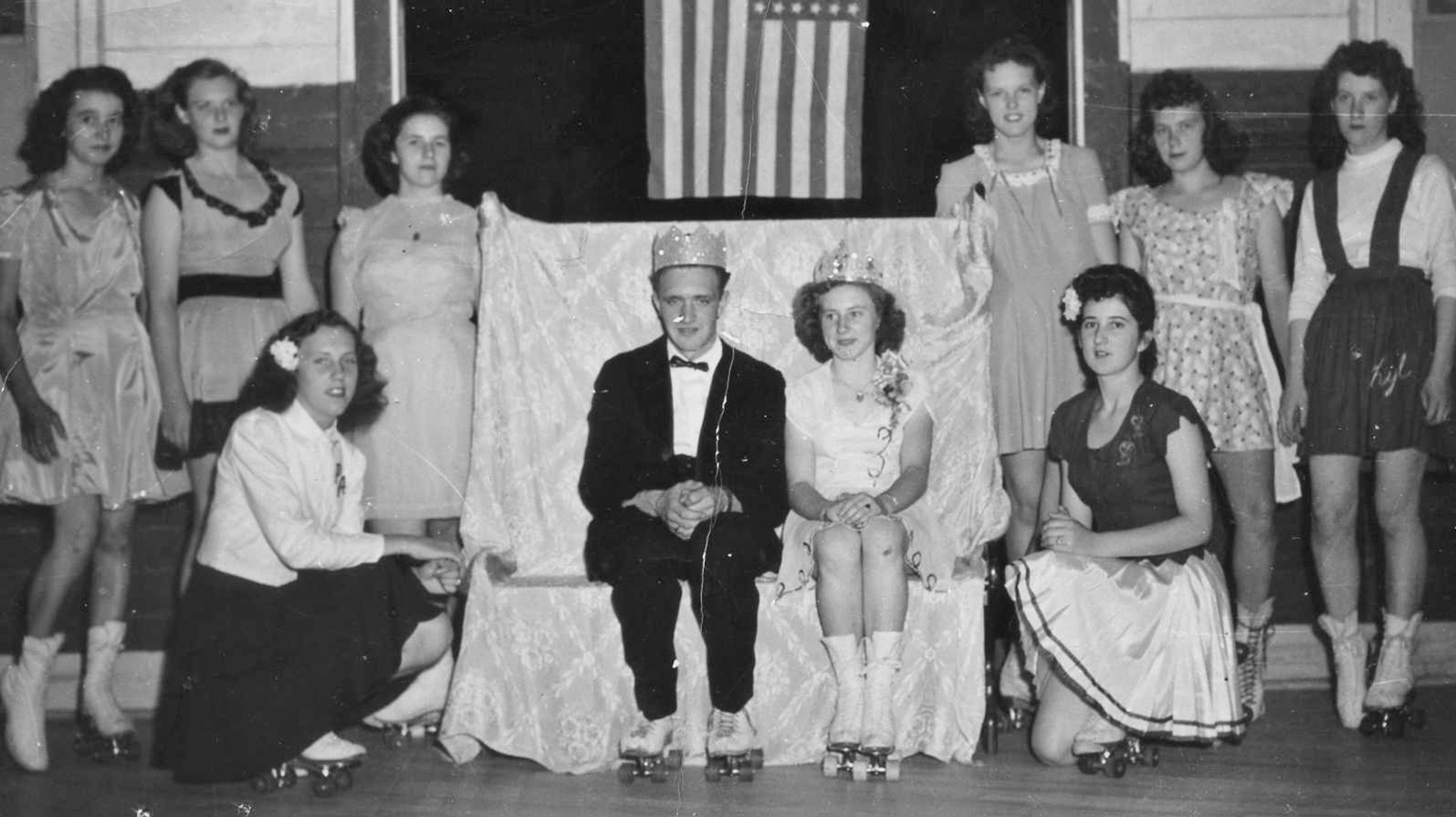
Skateland Roller Rink Carnival Event
*
The Junior Miss Skateland competition was also a very popular annual event at the rink.
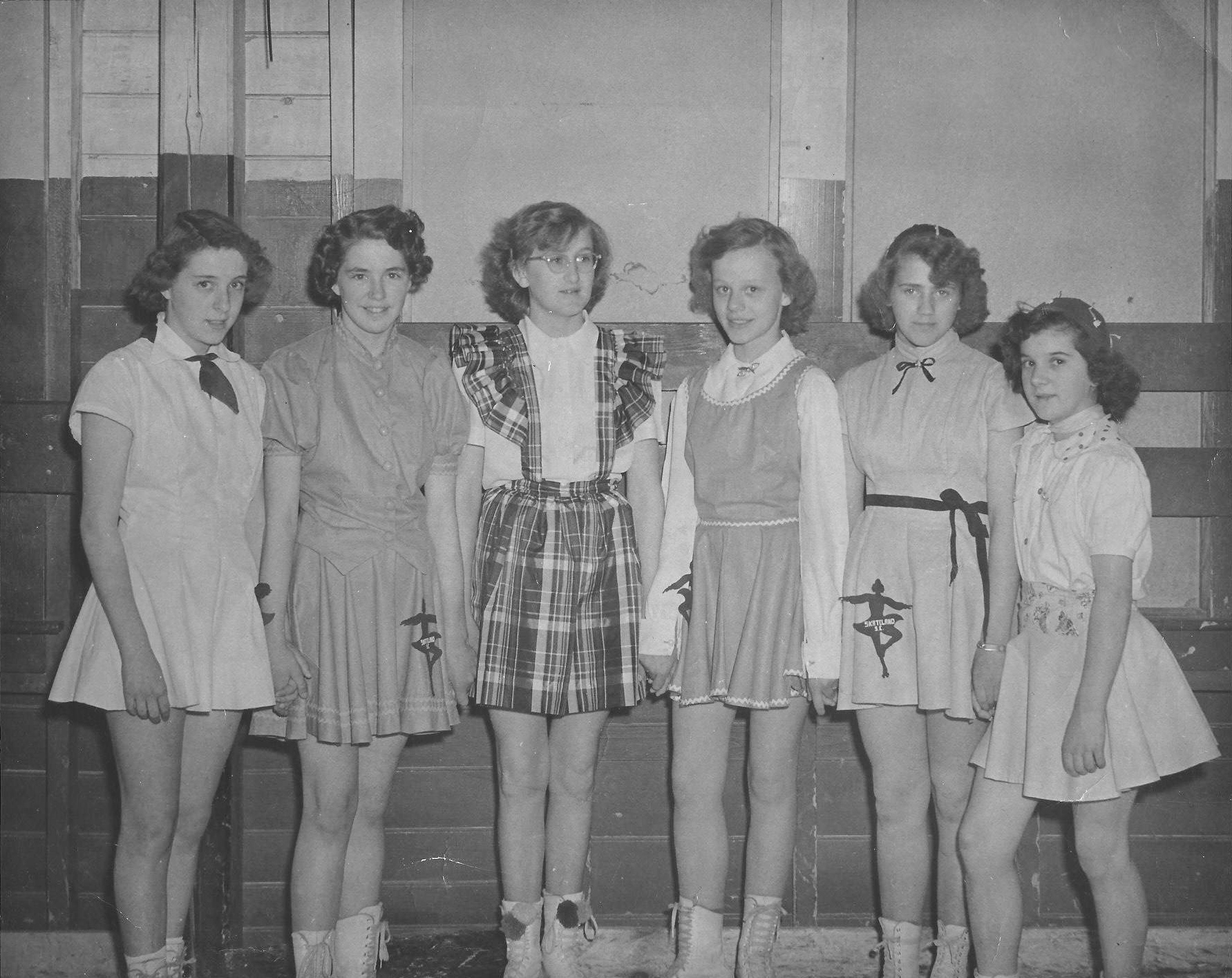
Junior Miss Skateland Competition – 1951 (Won by Betty Lou Grignon)
(L-R): Sandra (Southard) McNichol | Donna (Goforth) Lindquist | Ruth (Seekins) Wilber
Priscilla (Deering) Halle | Priscilla (Rice) Butler | Betty Lou (Grignon) Morrison
*
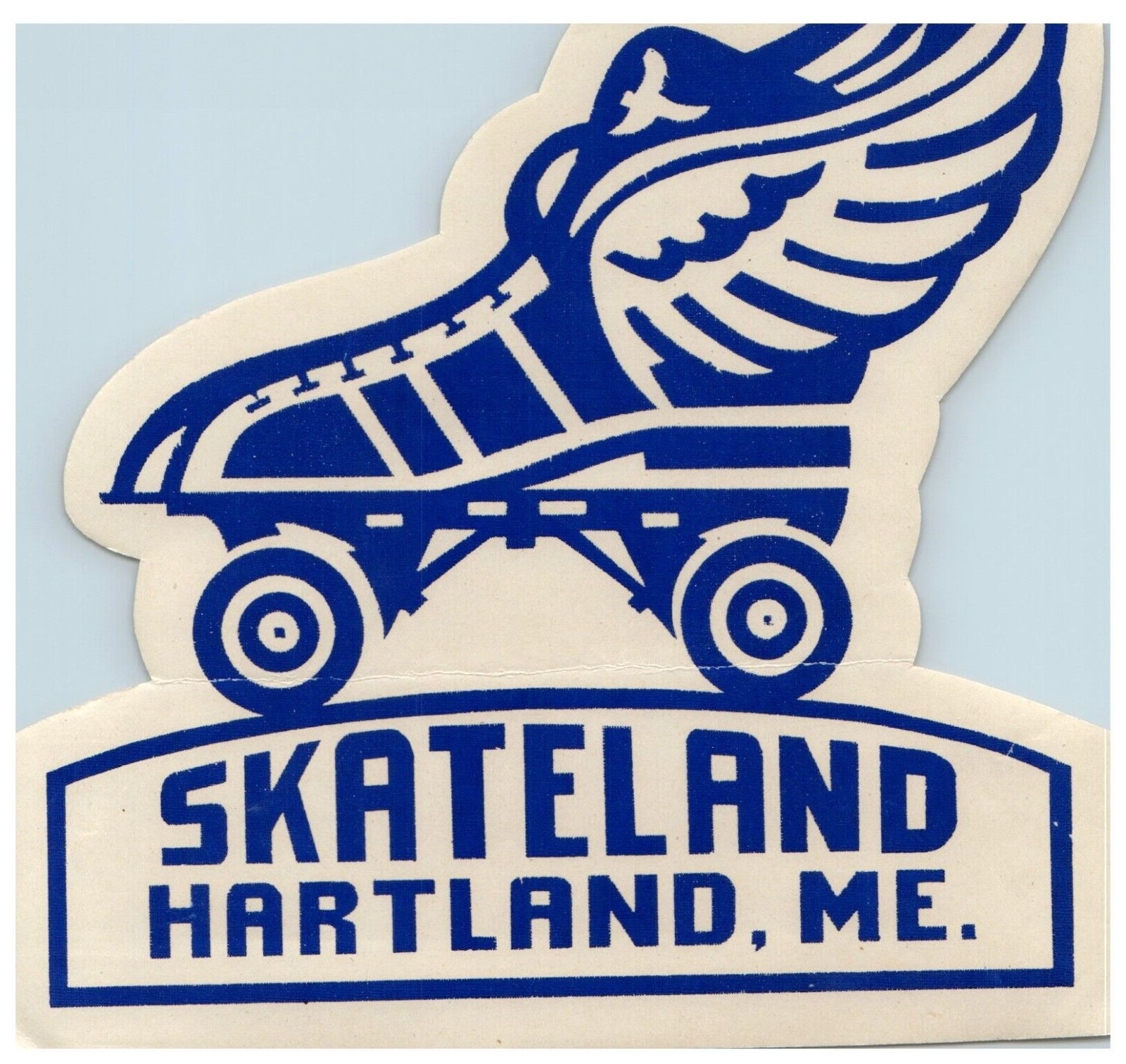
*
In the early 1950s, the fire hall at Hubbard Avenue began experiencing major floor support issues so for several years Rae stored a couple of the fire trucks in the 1st floor of The Blue Moon until a new fire hall was built in 1957.
*
In 1957, Frank left Hartland to open a new Skateland Roller Rink in Dexter. For the next couple of years, the 2nd floor was again used by local groups including the fire department for fund raising events until late 1959 when Robert Elwood Knowles, son of Ed Knowles, took over the building leasing it from Rae, his soon to be father-in-law. Bob was living in Hartland at the time with his step-grandmother Relief (Giles) Knowles on the corner of Blake & Seekins Street.
Bob installed a new heating system, painted the walls and windows blue, added new lights and opened for business soon after. In May of 1960, Bob had John McClegg from Waterville refinish the floor and coat it with a plastic sealer. The new nonskid, dustless floor was advertised as “speed skating on the new plastic floor”. Although the rink was operating in 1960, its official “Grand Opening” as The Blue Moon Ballroom & Roller Rink was held on Saturday, January 7, 1961 with a dance featuring the Al Corey Orchestra. Bob’s brother-in-law Rogen Randlett helped operate the rink and his wife Joanne (LeVasseur) Randlett also worked the concession stand.
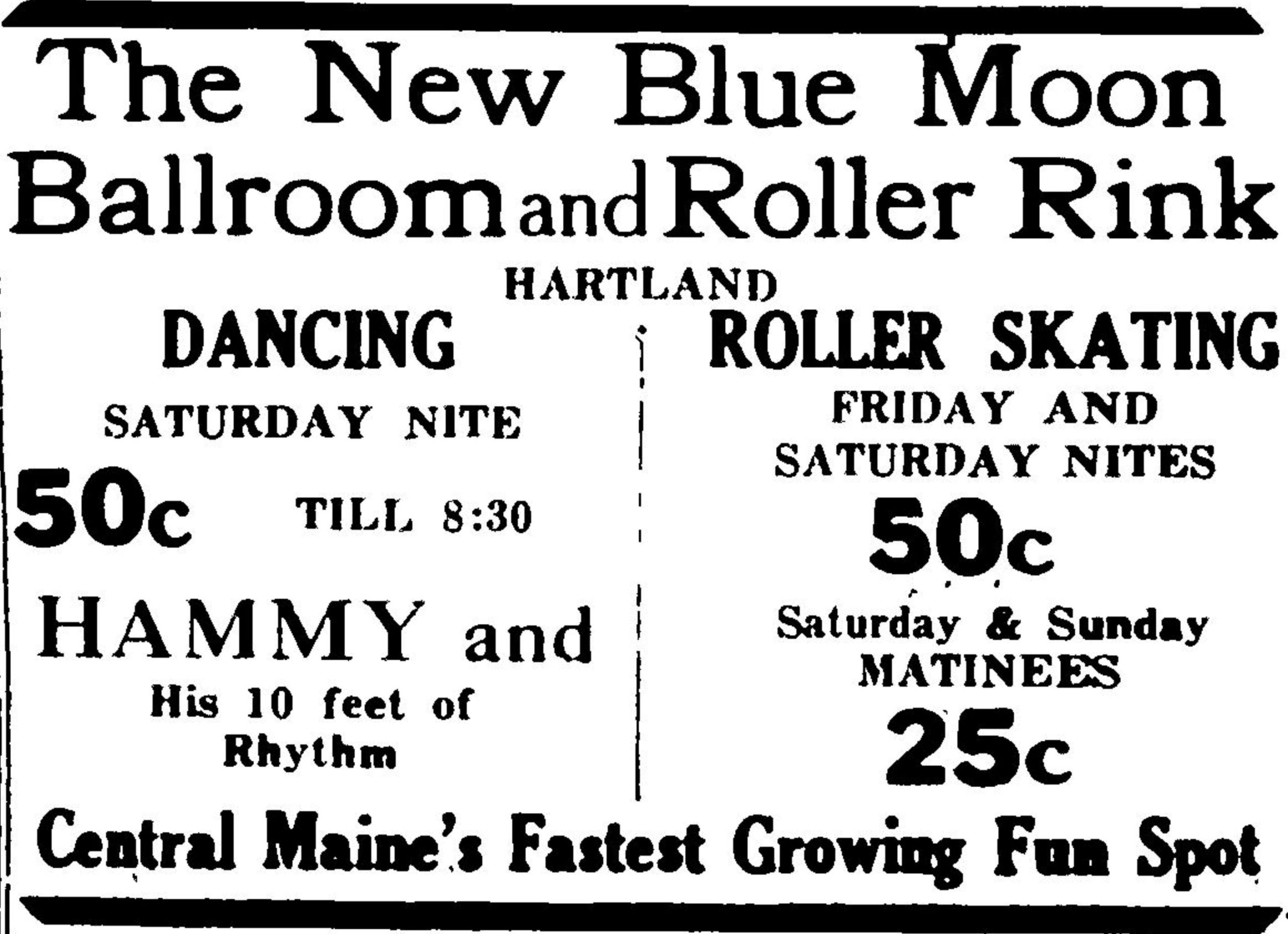
Blue Moon Ad – 1960
*
Roller skating at the “new” Blue Moon was typically held on Friday nights and Saturday & Sunday afternoons. Dances were usually held on Saturday nights with area live bands performing or DJ’s spinning records. Admission for afternoon roller skating was 25 cents and 50 cents for night skating with admission for dances at 50 cents. Bob sent clamp-on skates to a company in Waltham, Massachusetts where they attached them to shoes which he rented out at the rink for 25 cents. It wasn’t unusual for the very popular venue to take in $200 on a full card of Saturday skating and dancing events. Chairs for the dances were stored in the attic of the roller rink and after the Saturday afternoon skate Bob and Rogen brought them down to prepare for the night dance. Following each Saturday night dance, they hand washed the floor and put spangles on the floor to make it waxy for skating. (Special thanks to Bob Knowles for providing us with many of these details during a 2021 interview with his niece Tammy Randlett-Higgins)
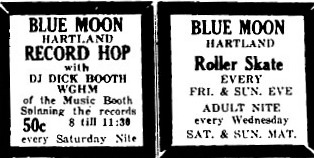
Blue Moon Ad – 1960
*
Following Bob’s marriage to Rae’s daughter Rae Jean (Randlett) Knowles in June of 1960, he continued operating The Blue Moon until 1965 before he and Rae Jean moved to Unity in 1966 to commit their efforts full time operating Unity Raceway which Bob had taken over from his father in 1960.
Soon after Harold Plumley of Unity began holding youth dances at The Blue Moon. Mr. Plumley, who had also established a Youth Center in Unity, noted a 1965 newspaper article, “This is for the young people in Hartland and the surrounding areas and will feature live rock and roll music every Saturday night. The project is being operated with the objective in mind to provide wholesome entertainment for teenagers.” Roller skating and fund raising events continued to be held during this time including the Annual Hartland Fireman’s Ball.
*
George and Merlene (Lewis) Mead took over management of The Blue Moon in late 1966 operating it as a roller skating rink but unfortunately its deteriorating condition eventually led to its closure about 1975. Gerald Martin purchased the building from Rae Randlett for heavy equipment storage before it was finally razed soon after.
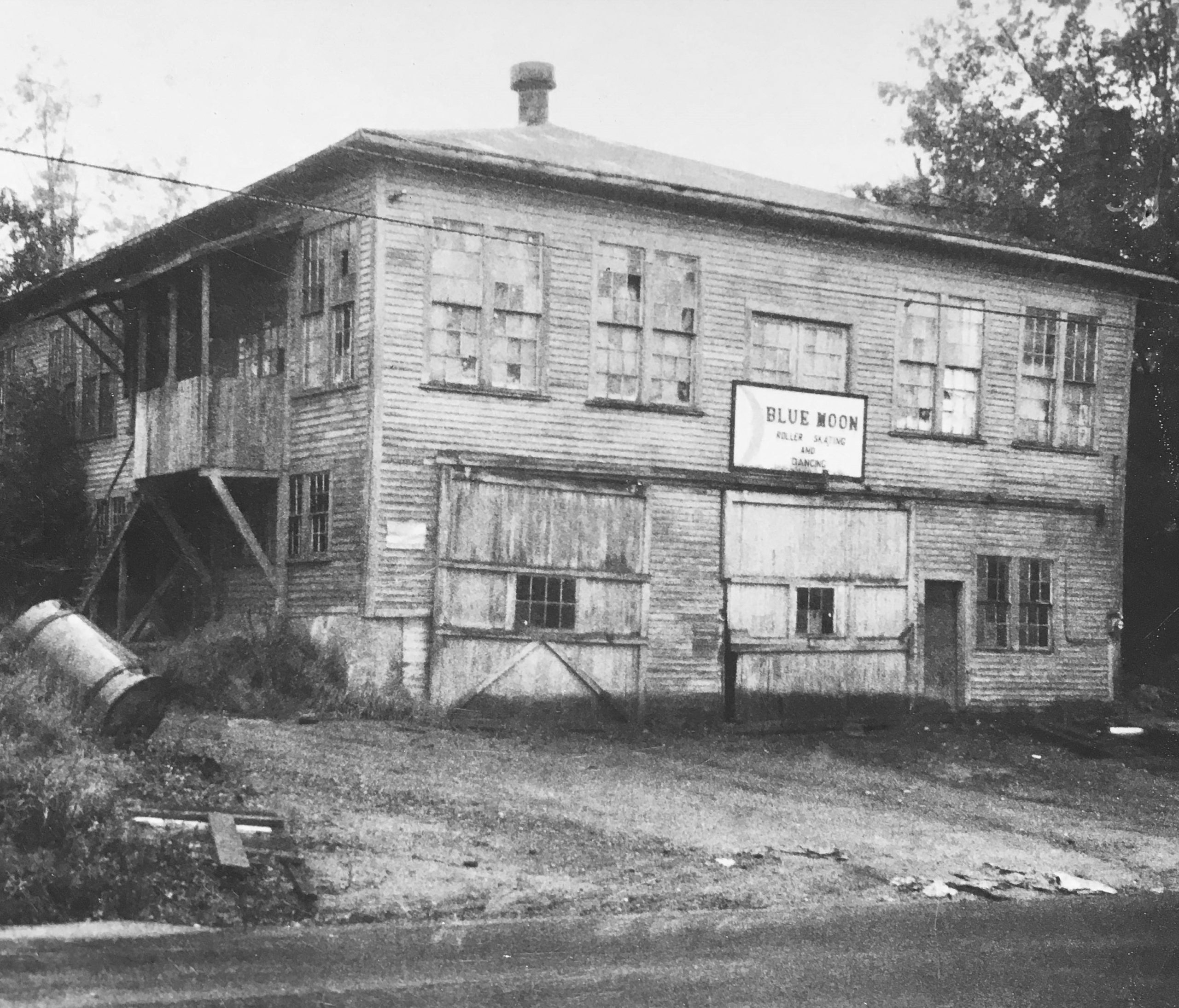
The last known photo of The Blue Moon Dance Hall & Roller Skating Rink awaiting its demolition that same day
*
A car wash was eventually built on the empty Blue Moon lot in early 1980s.
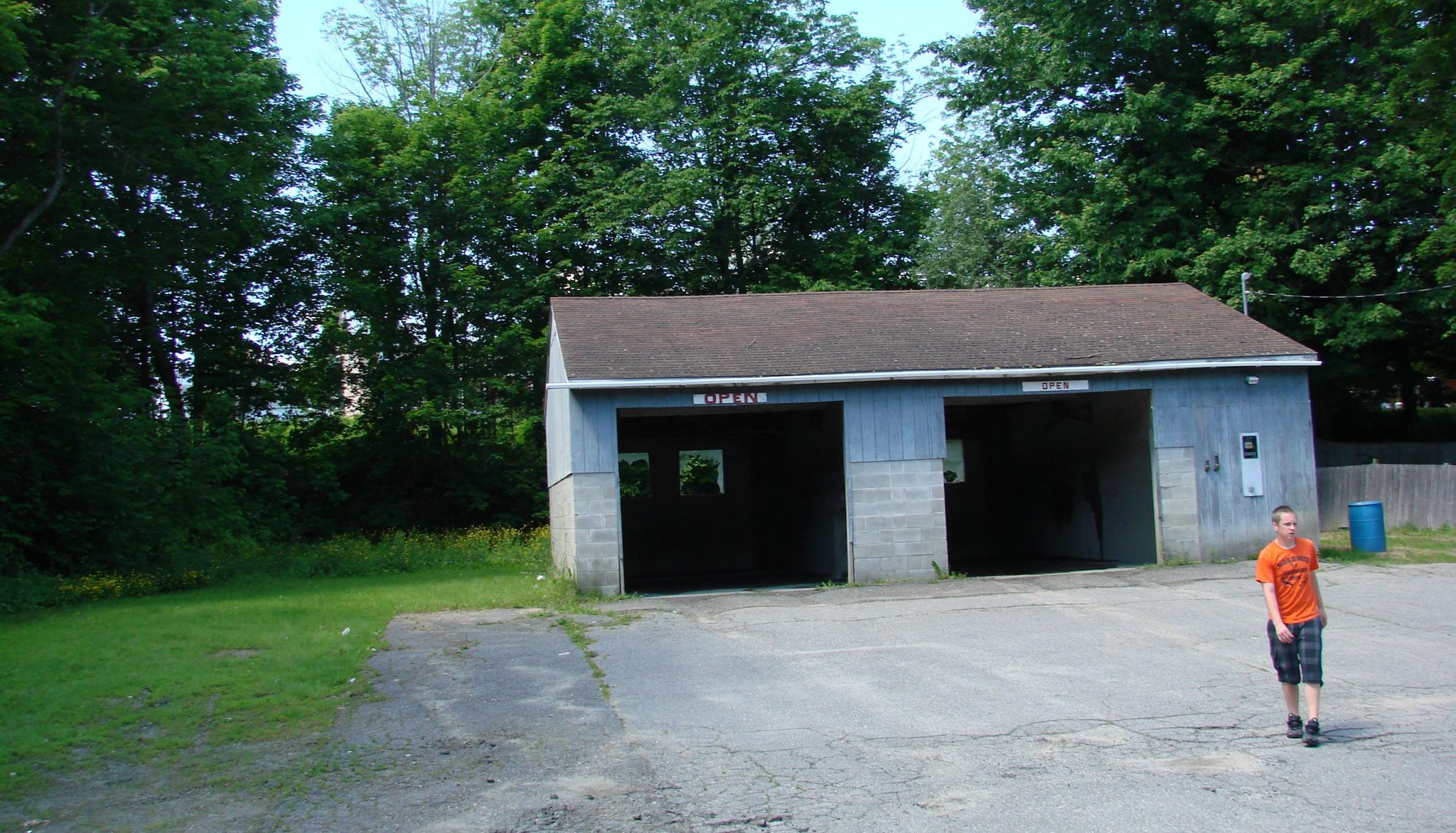
Former Blue Moon Building Lot – 2017
*
In 1898, the Linn Manufacturing Company purchased land from Greenville J. Shaw at the Upper Dam where the former Shaw Tannery had been located along with Shaw’s property across the street. The exact date is unknown but soon after they built 4 identical houses on the Upper Mill Street property likely used for housing for management employees of the company. At some point before the Great Auction of 1932, these 4 houses were privately sold and did not appear on the auction listing. They also built 3 of these identical houses on Hubbard Avenue which were part of the Great Auction and were mistakenly identified as their Mill Street counterparts in the description listing although they were correctly placed on the auction map.
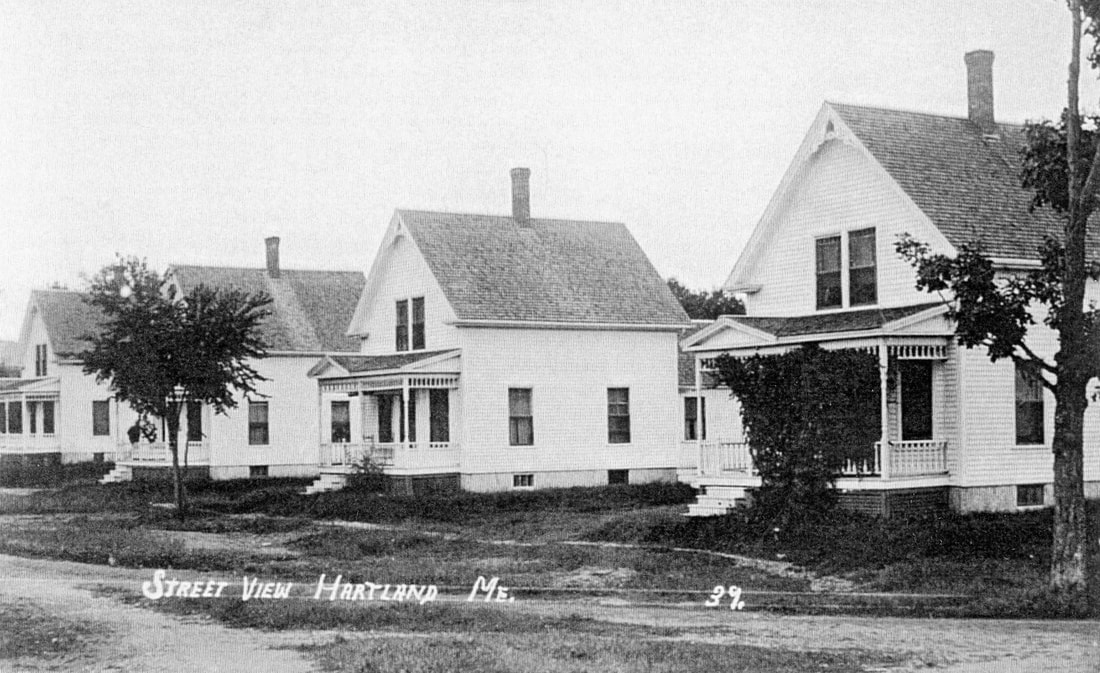
In 1943, the 4 homes were owned by (L-R): Frank Hollister Jr, A. Cook, R. Hunt and Vincent & Fannie (Griffith) Dyer
*
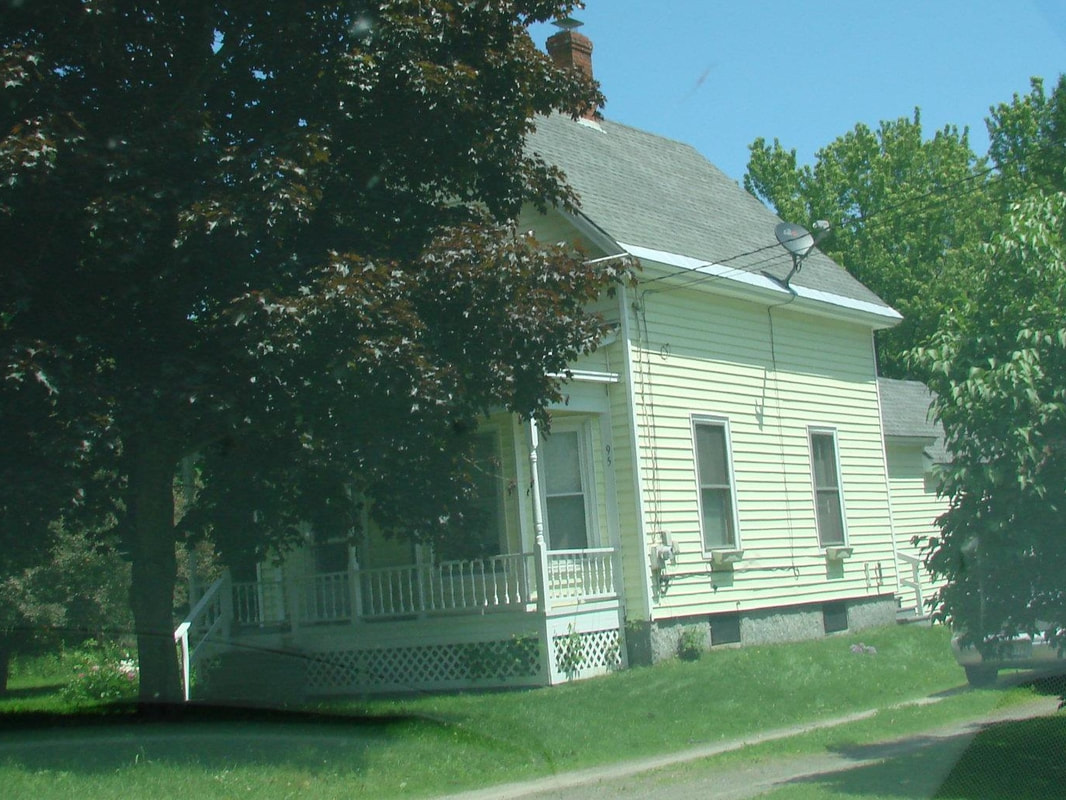
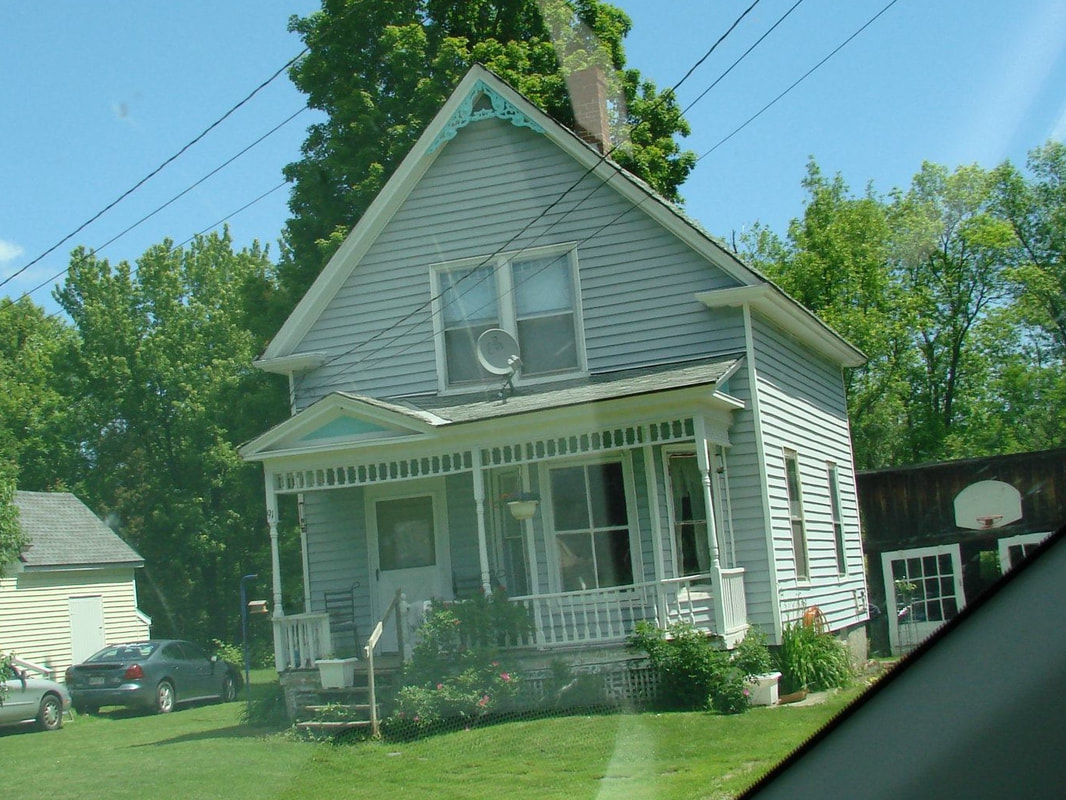
Former F. Hollister House – 2012 Former A. Cook House – 2012
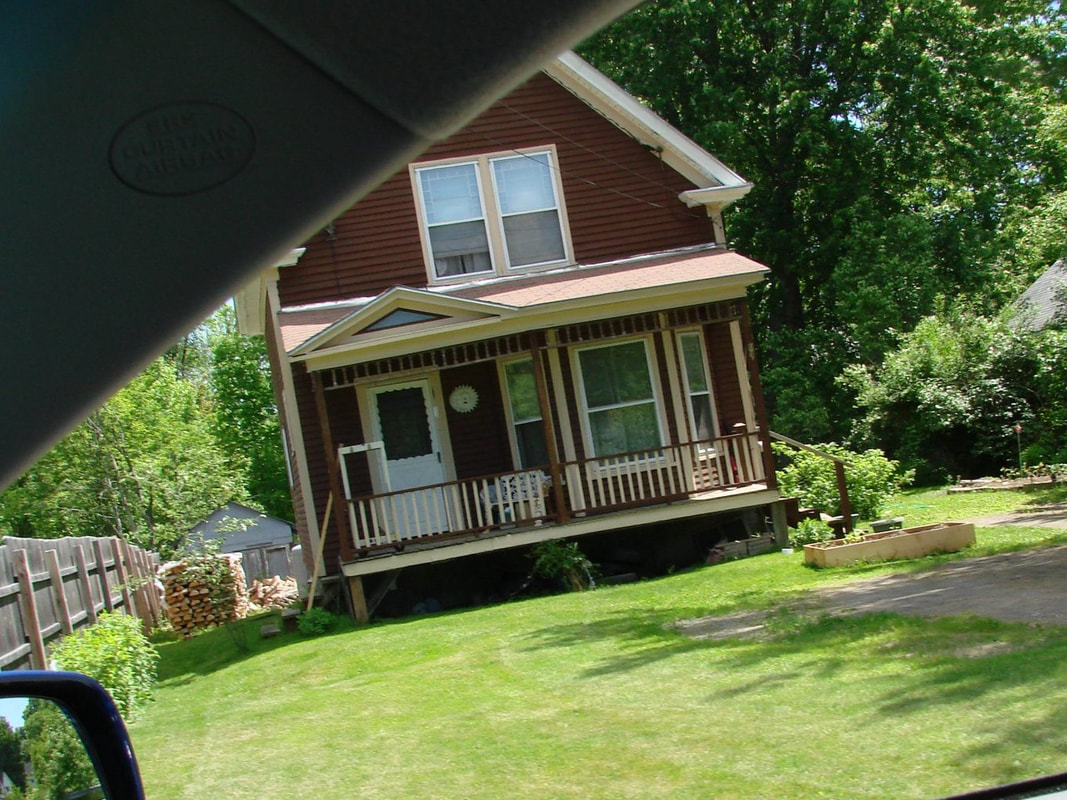
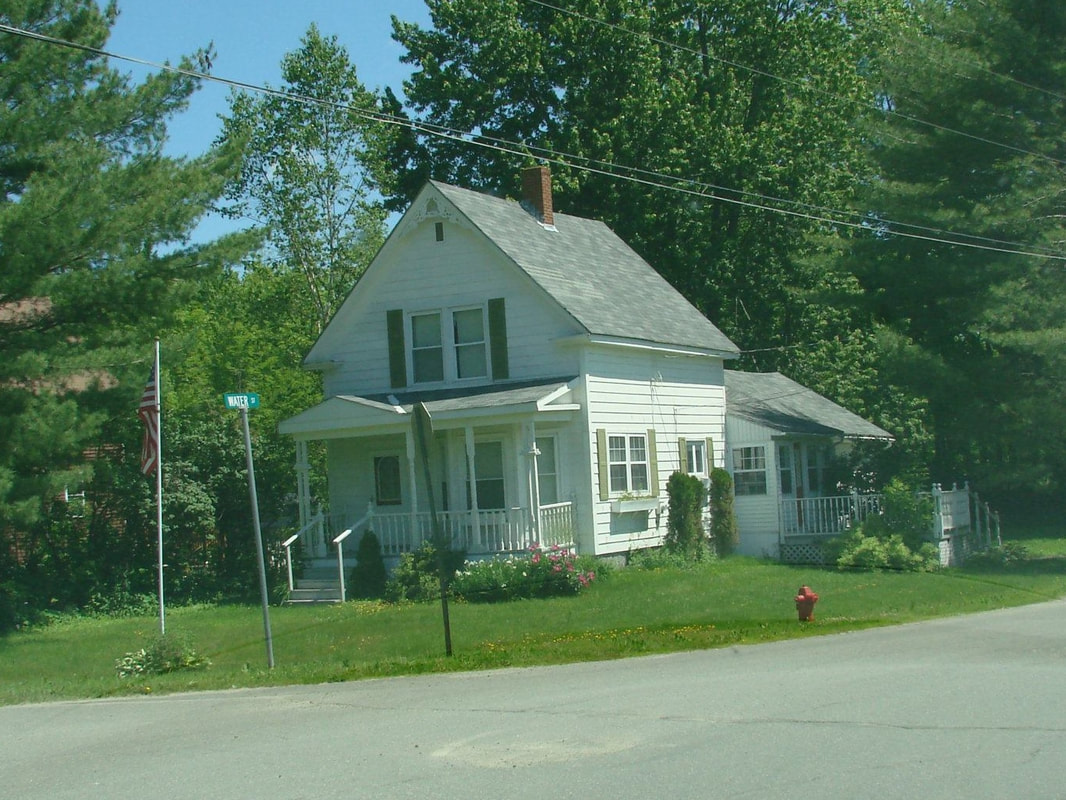
Former R. Hunt House – 2012 Former V. Dyer House – 2012
*
Mill Street & Moore Street below with property ownership in 1943. The house on Moore Street noted as “E.W. Mills” should be Charles Wilfred Mills. The house on Moore Street noted as “C.W. Mills” should be Horace Wesley Mills. The “M. Huff” on Mill Street should be Norman Huff.
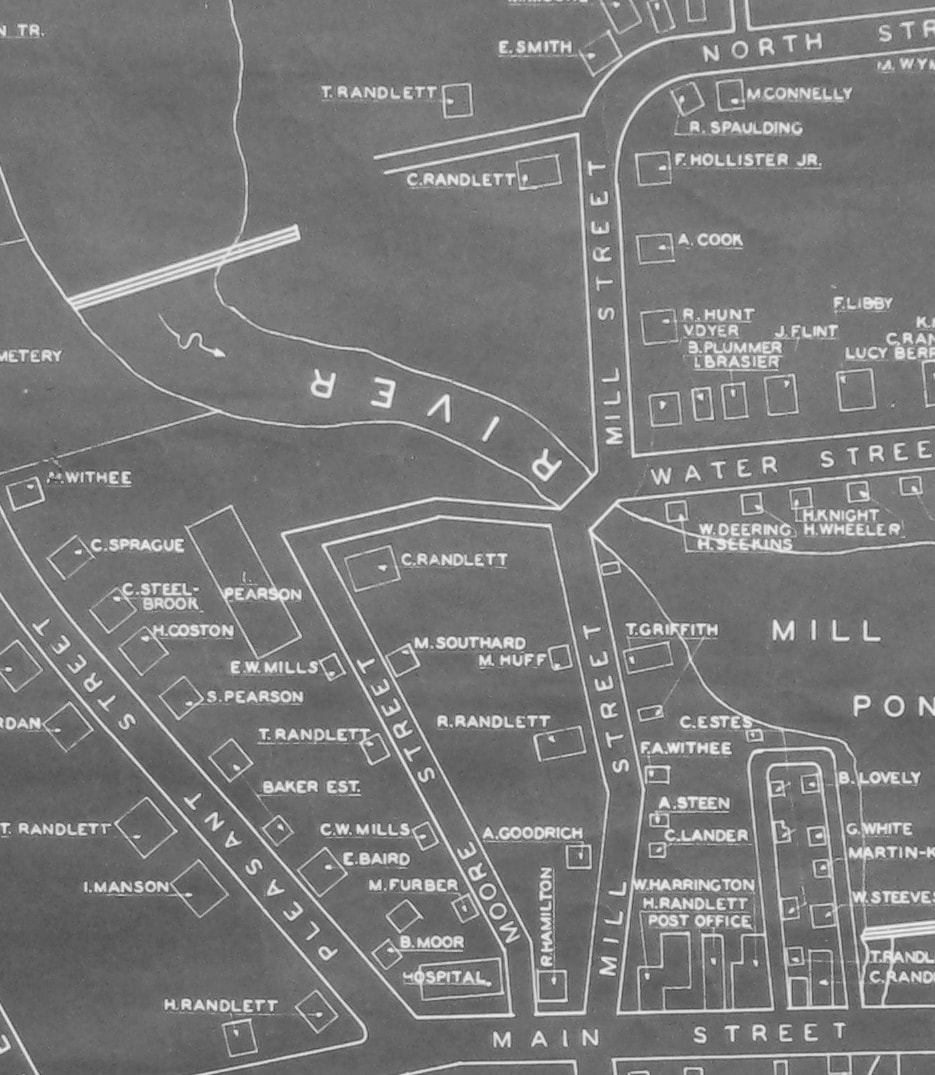
Hartland Village – 1943
*
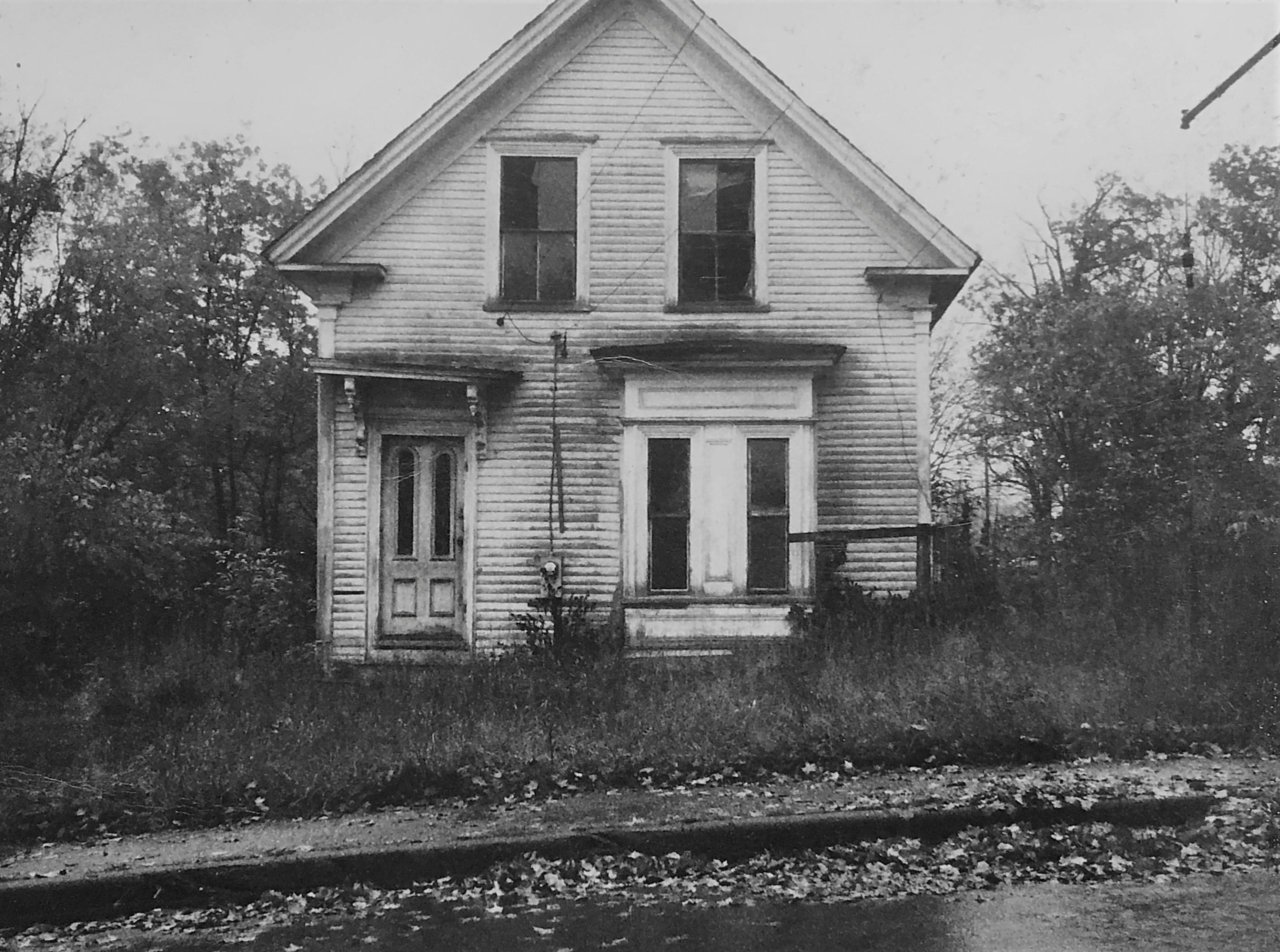
Former Frank A. Withee House
*
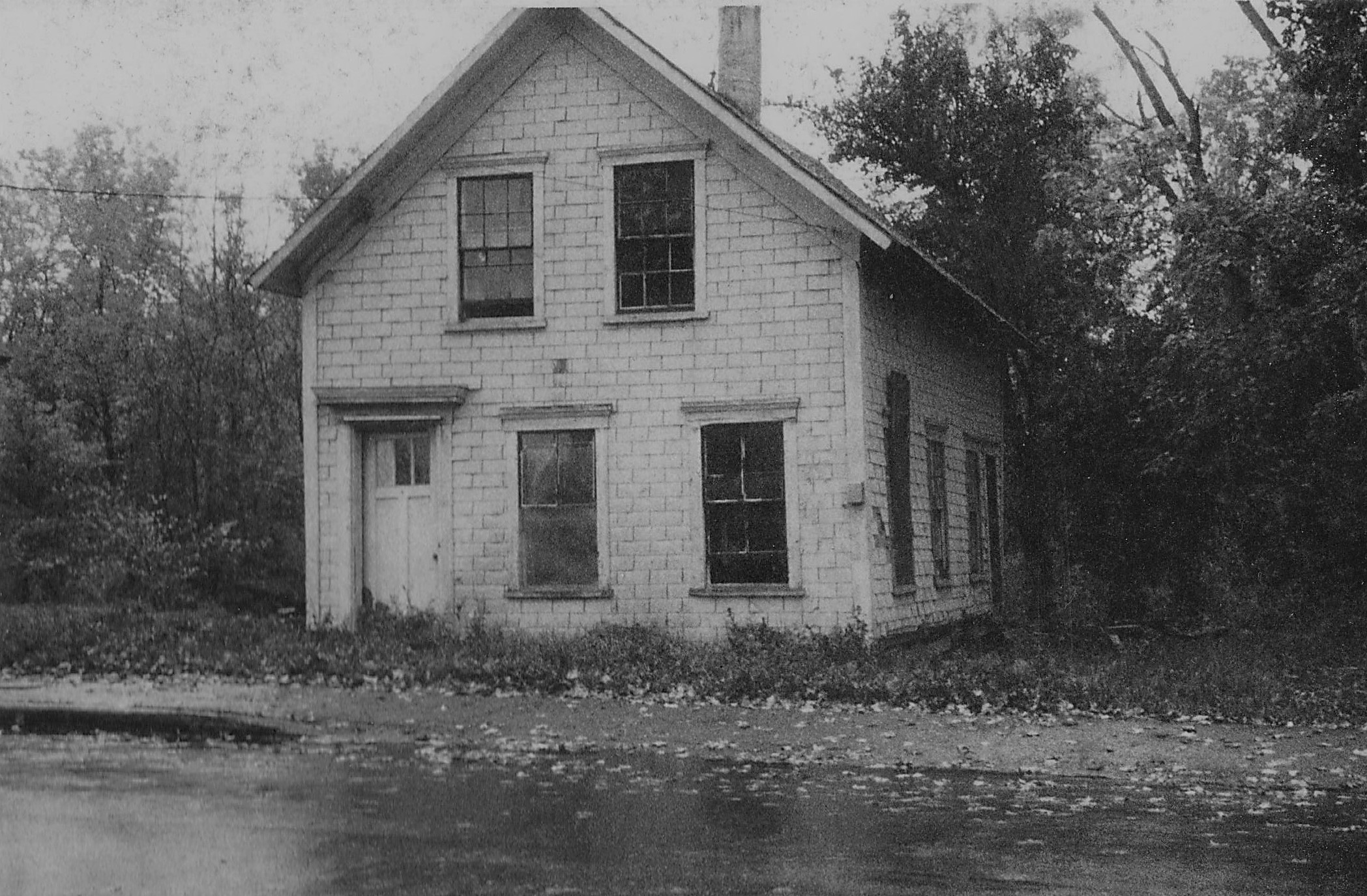
Former A. Steen House
*
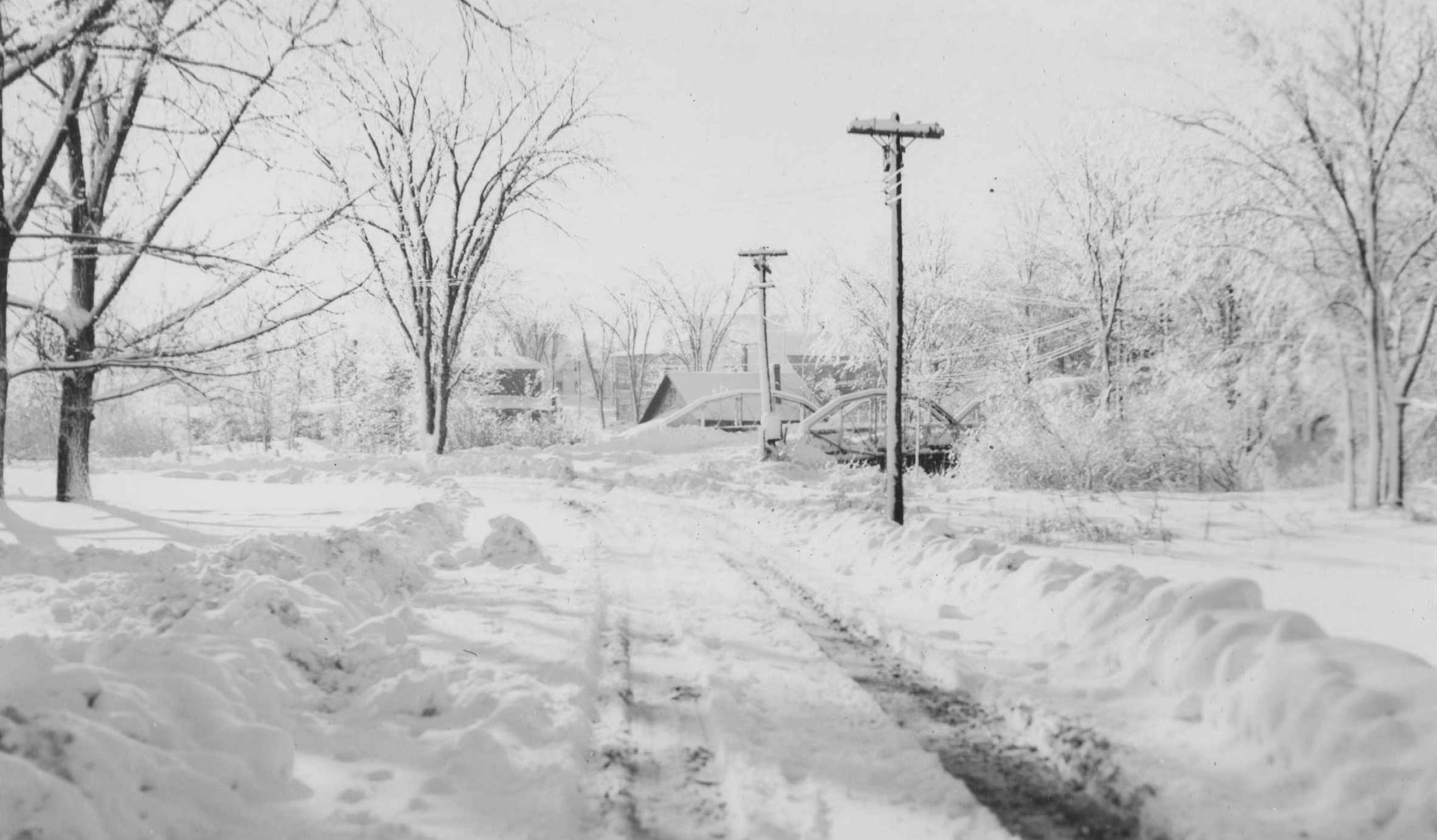
Mill Street seen from North Street – 1944
*
In 1948, the mill originally built by Amasa J. Moor and his son Walter H. Moor in 1885 and later operated by Fred Burrill & Ivar Pearson Sr burnt to the ground.
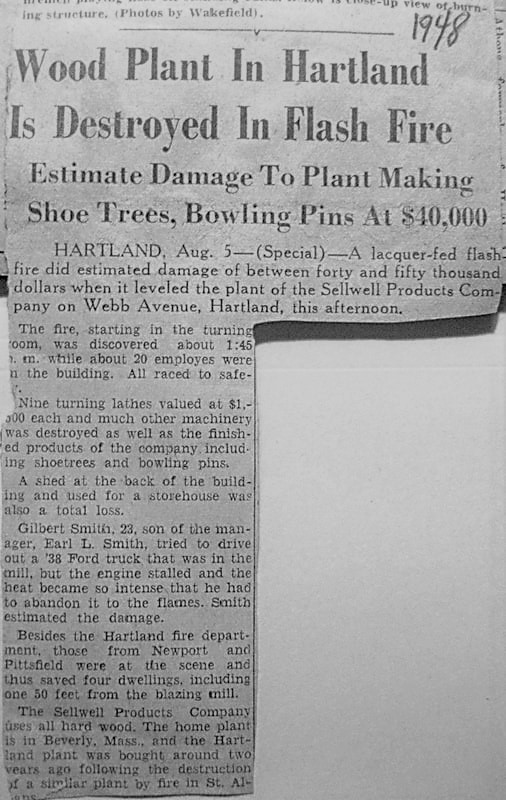
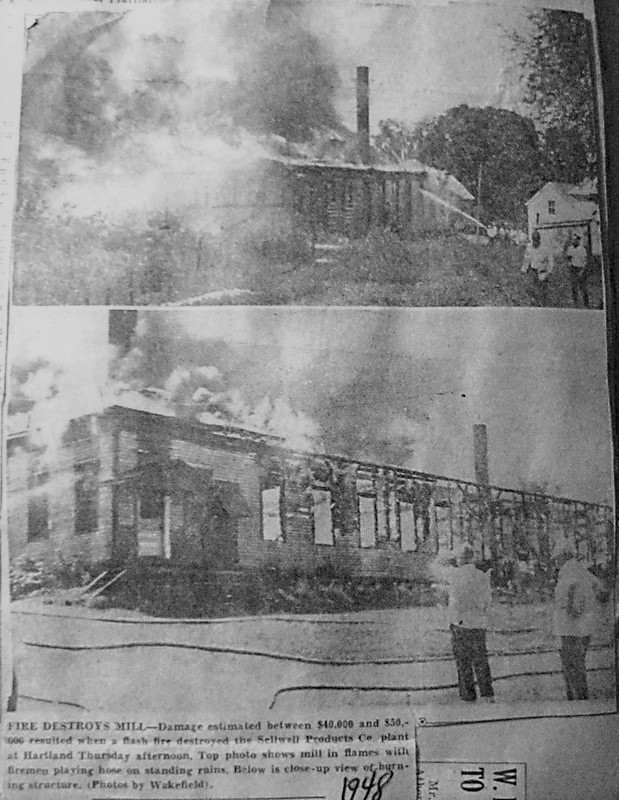
Sell Well Products Company Fire – August 5, 1948
*
In 1955, Moore Street officially became a street in Hartland when citizens voted in favor of the proposed Article 43 at the Annual Town Meeting.
“To see if the town will vote to accept the town way as laid out by the Selectmen and to raise and appropriate the sum of $1,000 for the construction and tarring of this street described as follows: Beginning at a point where a line drawn 31 ft. 6 inches easterly from a stone post in front of the Scott-Webb Memorial Hospital intersects a line drawn 45 ft. 8 inches westerly from a stone post in front of the residence of Ralph C. Hamilton, being ten feet on each side of a line extending North to Mill Street. No damages to be allowed to the owners of the land over which the way passes. The above course is center of the street to be 20 feet in width and to be called Moore Street.”
In 1956 the Town Report noted, “Moore Street was constructed, tarred and added to the village street system during 1955.”
*
In 1956, the Donald H. Shorey Funeral Home was built on Mill Street. Mr. Shorey had been in business for many years in Pittsfield and had located a smaller funeral home in Hartland several years earlier at the Hartland House before moving to this new dedicated building near the corner of Main Street.
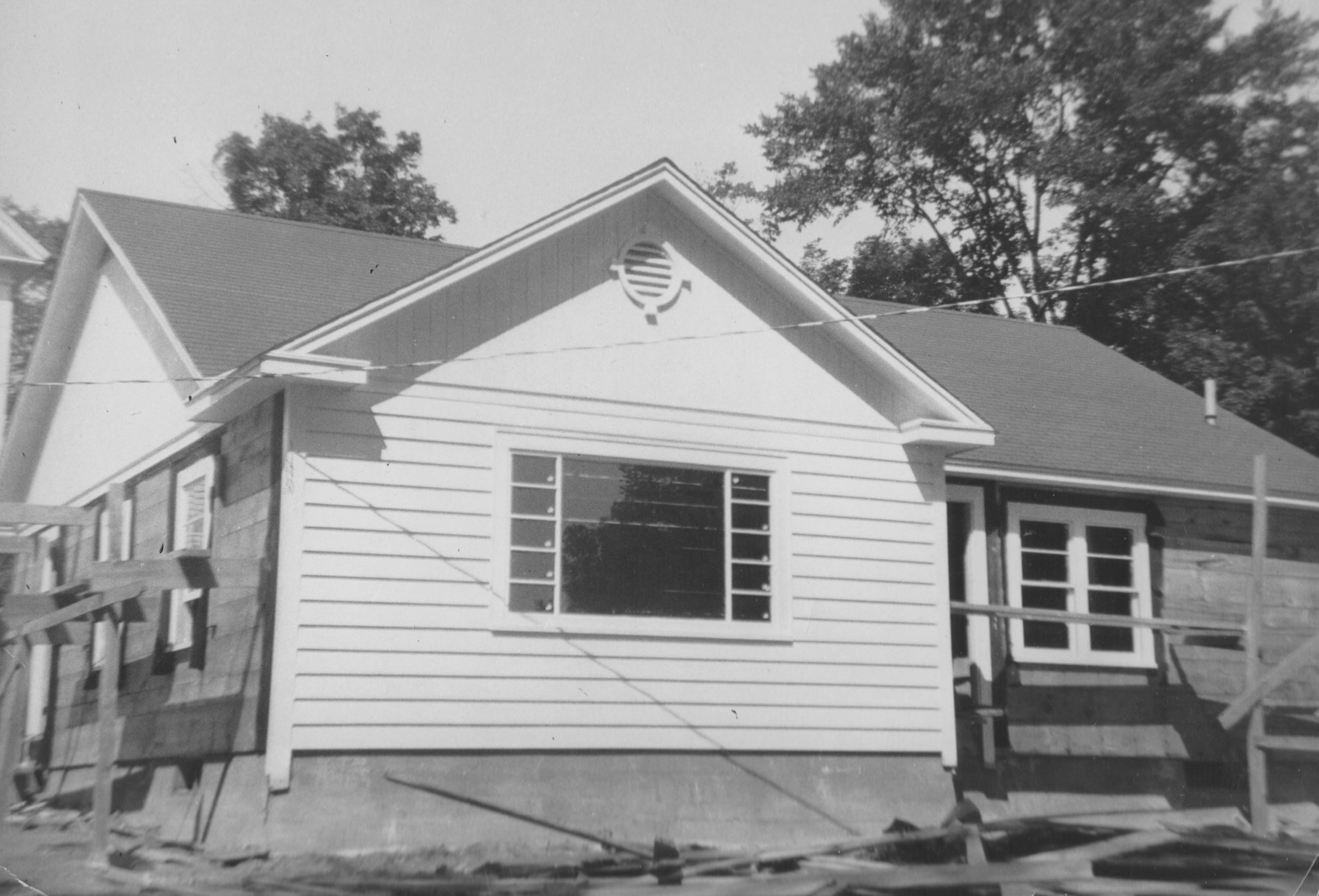
Construction of Donald H. Shorey Funeral Home – 1956
*
Donald Shorey’s building was purchased by the Town of Hartland in 1991 and converted into the new home of the Hartland Public Library moving from its former location at the original Linn Woolen Mill Office on Commercial Street where the library had been since 1935.

Hartland Public Library – 2017
*
During the infamous “April Fool’s Day Flood” of 1987, the Upper Dam held against the raging flood waters but was weakened enough to cause concern for its future stability and was rebuilt once again by the Town of Hartland in 1991.
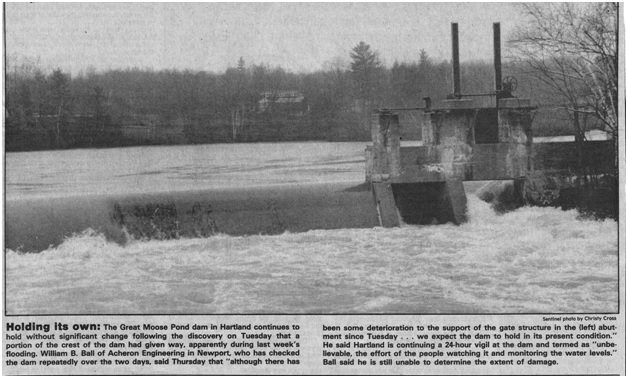
Upper Dam April Fool’s Flood Newspaper Article – 1987
*
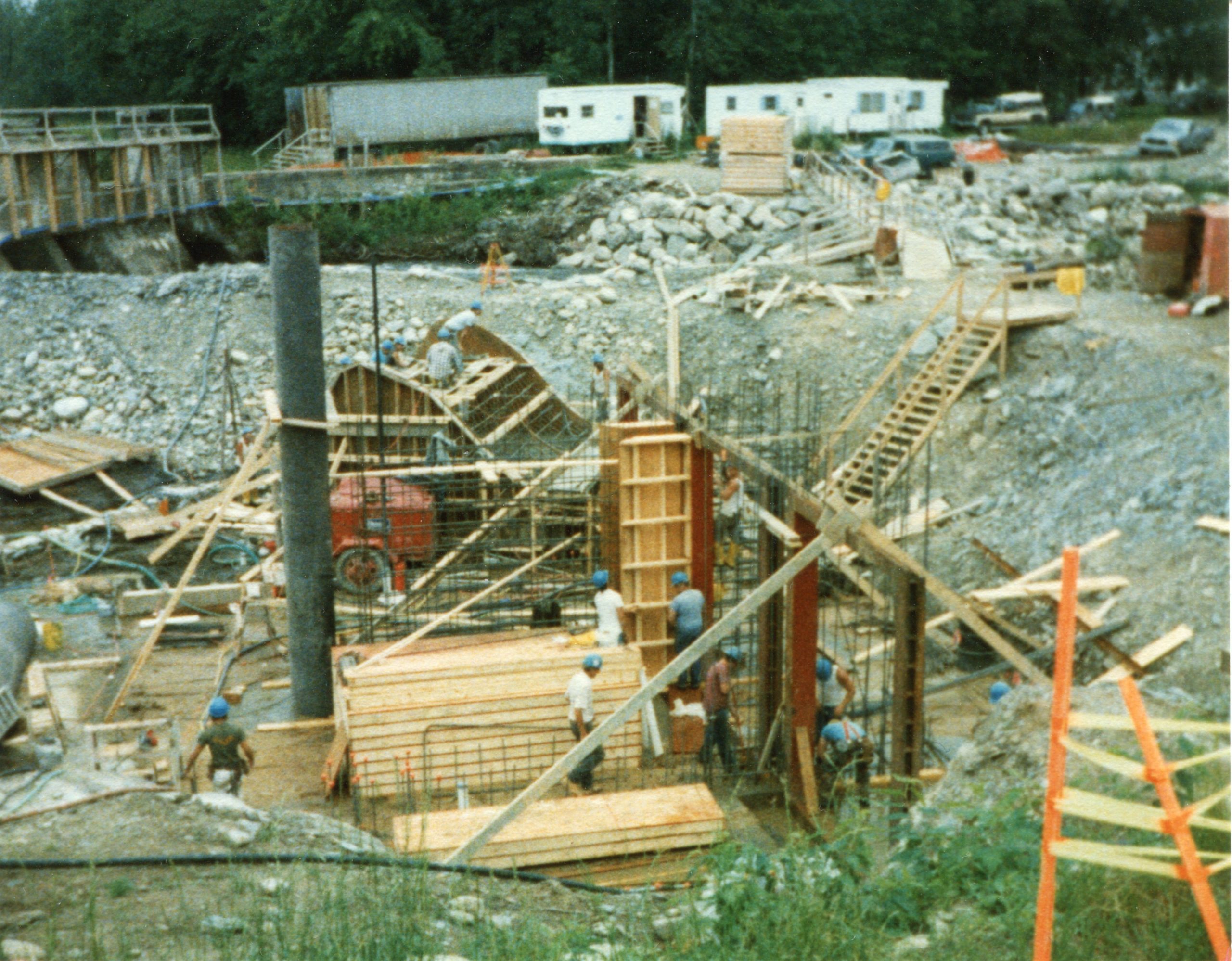
Upper Dam Rebuild – 1991
*
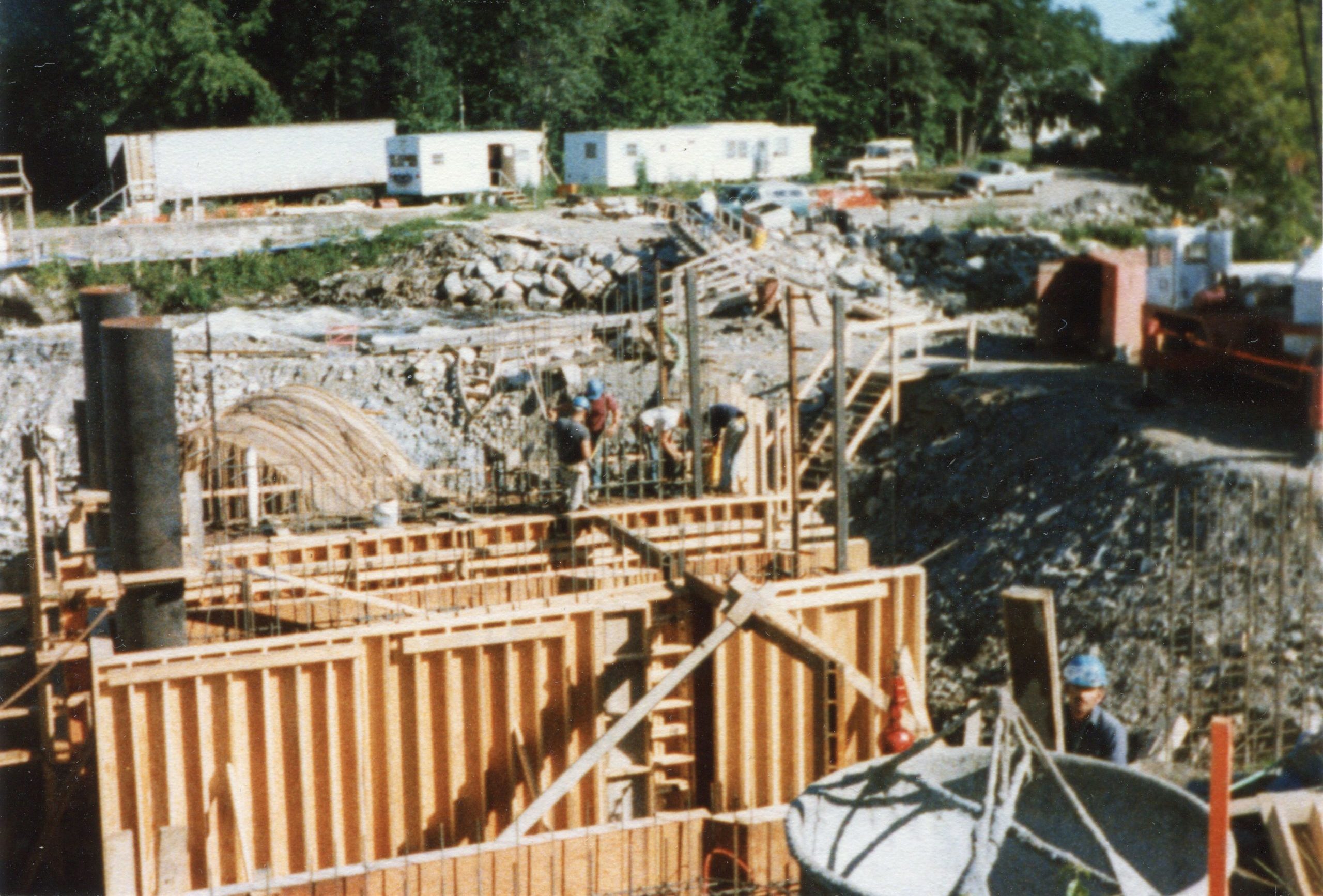
Upper Dam Rebuild – 1991
*
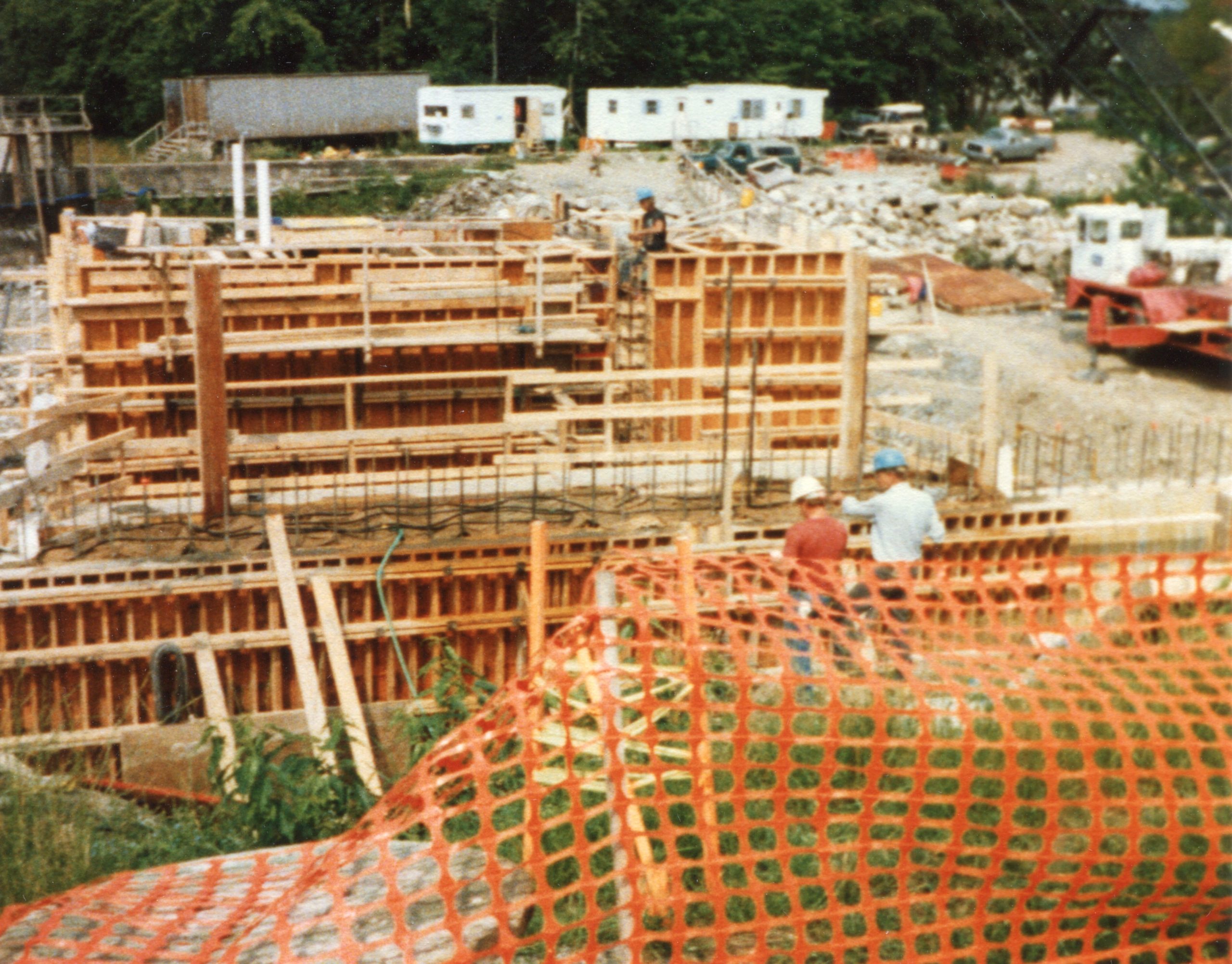
Upper Dam Rebuild – 1991
*
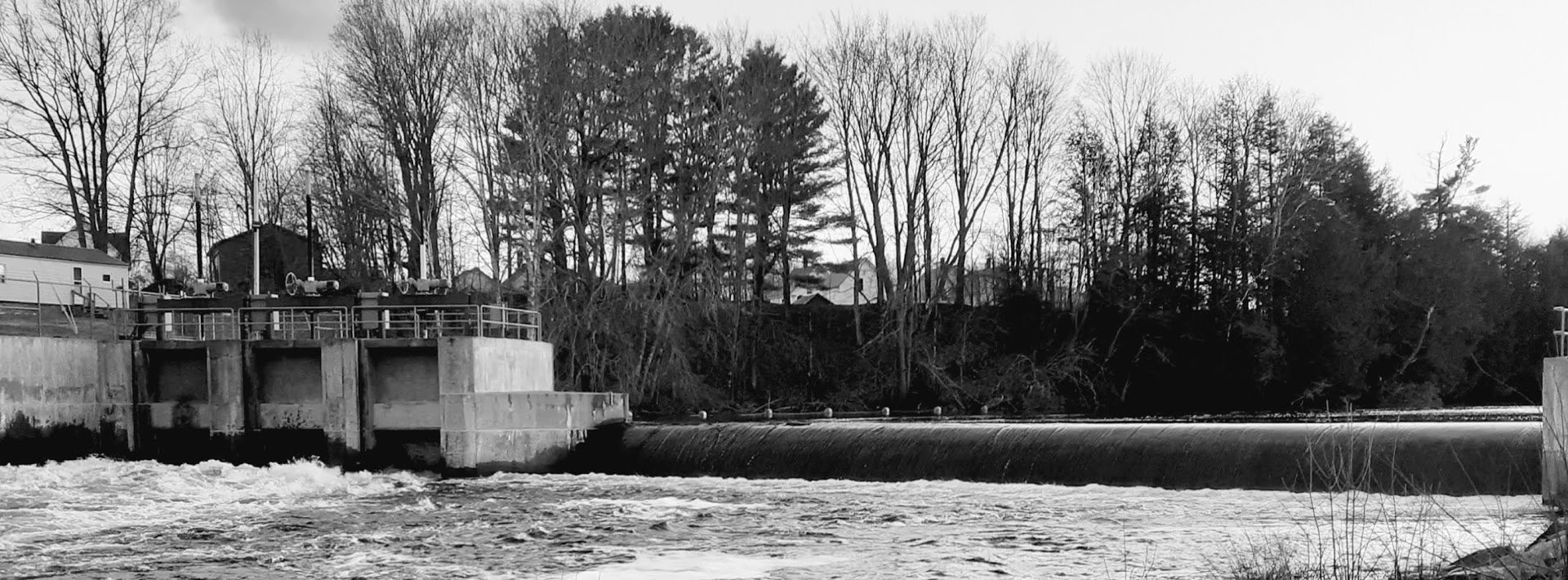
Upper Dam – 2019 (Photo courtesy of Will Bunker Photography)